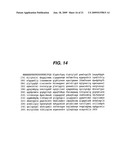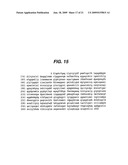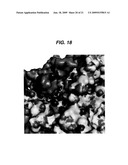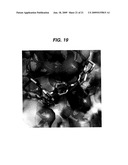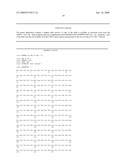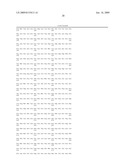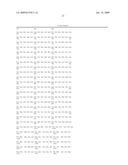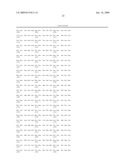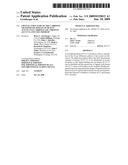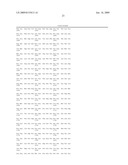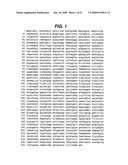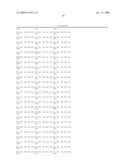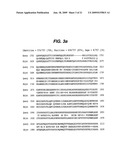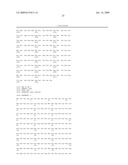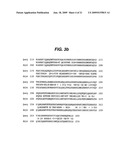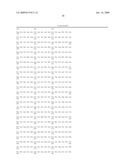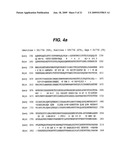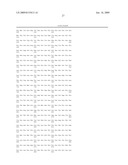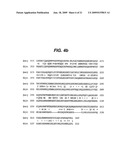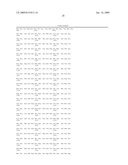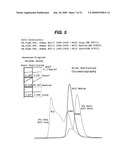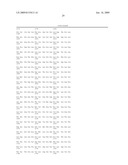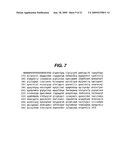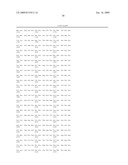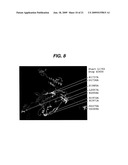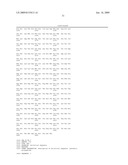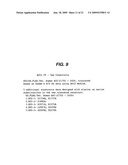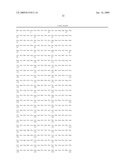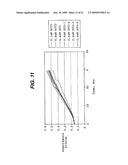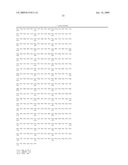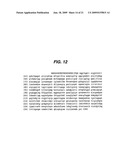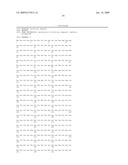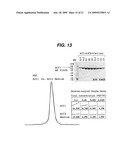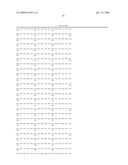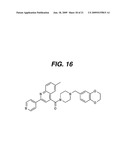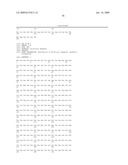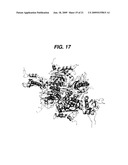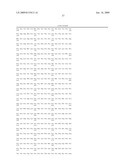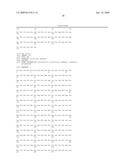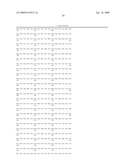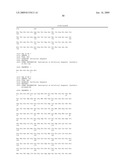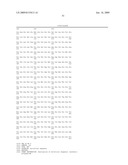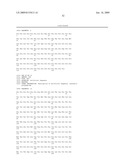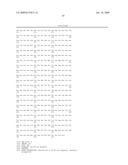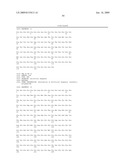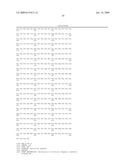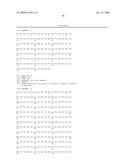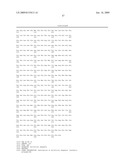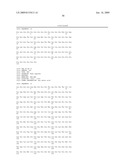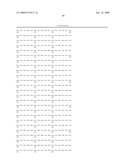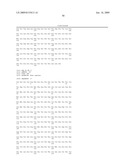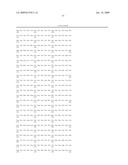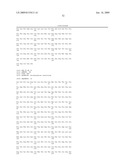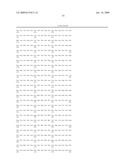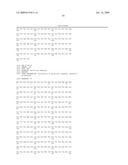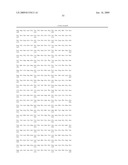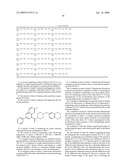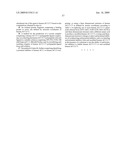Patent application title: CRYSTAL STRUCTURE OF THE CARBOXYL TRANSFERASE DOMAIN OF HUMAN ACETYL-COA CARBOXYLASE 2 PROTEIN (ACC2 CT) AND USES THEREOF
Inventors:
Bruce L. Grasberger (Trappe, PA, US)
Cynthia Milligan (Rutledge, PA, US)
John C. Spurlino (Downington, PA, US)
Ruth A. Steele (West Chester, PA, US)
Kenneth R. Singleton (Downington, PA, US)
Alan C. Gibbs (Wyndmoor, PA, US)
Francis A. Lewandowski (Washington Crossing, PA, US)
IPC8 Class: AG01N33566FI
USPC Class:
435 78
Class name: Measuring or testing process involving enzymes or micro-organisms; composition or test strip therefore; processes of forming such composition or test strip involving antigen-antibody binding, specific binding protein assay or specific ligand-receptor binding assay involving nonmembrane bound receptor binding or protein binding other than antigen-antibody binding
Publication date: 2009-06-18
Patent application number: 20090155815
Claims:
1. A crystal comprising a dimer of human ACC2 CT, or a fragment, or target
structural motif or derivative thereof, and a ligand, wherein said ligand
is a small molecule inhibitor.
2. The crystal of claim 1 wherein said fragment or derivative thereof is a peptide comprising SEQ ID NO: 6 or a peptide having at least 95% sequence identity to SEQ ID NO: 6.
3. The crystal of claim 1 wherein said crystal has a spacegroup of P2.sub.12.sub.12.sub.1.
4. The crystal of claim 1 wherein said ligand has the following structure: ##STR00001##
5. A crystal of claim 1 comprising an atomic structure characterized by the coordinates of Table 1.
6. The crystal of claim 1 comprising a unit cell having dimensions of about a=100.646, b=145.993, c=308.696, alpha=90.00, beta=90.00, gamma=90.00.
7. A computer system comprising: (a) a database containing information on the three dimensional structure of human ACC2 CT, or a fragment or a target structural motif or derivative thereof, and a ligand, wherein said ligand is a small molecule inhibitor, stored on a computer readable storage medium; and, (b) a user interface to view the information.
8. A computer system of claim 7, wherein the information comprises diffraction data obtained from a crystal comprising SEQ ID NO: 6.
9. A computer system of claim 7, wherein the information comprises an electron density map of a crystal form comprising SEQ ID NO: 6.
10. A computer system of claim 7, wherein the information comprises the structure coordinates of Table 1 or homologous structure coordinates comprising a root mean square deviation of non-hydrogen atoms of less than about 1.5 Å when superimposed on the non-hydrogen atom positions of the corresponding atomic coordinates of Table 1.
11. A method of identifying an agent that binds to human actyl-CoA carboxylase 2 or human actyl-CoA carboxylase 1 comprising a step of employing a three dimensional structure of human ACC2 CT that has been cocrystallized with a small molecule inhibitor.
12. A method of claim 11, wherein the three dimensional structure corresponds to the atomic structure characterized by the coordinates of Table 1 or similar structure coordinates comprising a root mean square deviation of non-hydrogen atoms of less than about 1.5 Å when superimposed on the non-hydrogen atom positions of the corresponding atomic coordinates of Table 1.
13. A method of claim 11, further comprising the steps of: synthesizing the agent; and contacting the agent with human ACC2 CT.
14. The method of claim 11, further comprising locating the attachment site of said agent to human ACC2 CT, comprising: (a) obtaining X-ray diffraction data for the crystal of human ACC2 CT; (b) obtaining X-ray diffraction data for a complex of human ACC2 CT and the agent; (c) subtracting the X-ray diffraction data obtained in step (a) from the X-ray diffraction data obtained in step (b) to obtain the difference in the X-ray diffraction data; (d) obtaining phases that correspond to X-ray diffraction data obtained in step (a); (e) utilizing the phases obtained in step (d) and the difference in the X-ray diffraction data obtained in step (c) to compute a difference Fourier image of the agent; and, (f) locating the attachment site of the agent to human ACC2 CT based on the computations obtained in step (e).
15. An isolated protein fragment comprising a binding pocket or active site defined by structure coordinates of human ACC2 CT.
16. A method for the production of a crystal complex comprising a human ACC2 CT polypeptide-ligand comprising: (a) contacting the human ACC2 CT polypeptide with said ligand in a suitable solution comprising 10% PEG 3350, 100 mM Hepes pH 7.5, 200 mM Proline, and, b) crystallizing said resulting complex of human ACC2 CT polypeptide-ligand from said solution.
17. The method of claim 11, further comprising identifying a potential inhibitor of human ACC1 or human ACC2 comprising: a) using a three dimensional structure of human ACC2 CT as defined by atomic coordinates according to Table 1; b) replacing one or more human ACC2 CT amino acids selected from A459-A462, A530-A538, B261-B270 in said three-dimensional structure with a different amino acid to produce a modified human ACC2 CT; c) using said three-dimensional structure to design or select said potential inhibitor; d) synthesizing said potential inhibitor; and, e) contacting said potential inhibitor with said modified human ACC2 CT in the presence of a substrate to test the ability of said potential inhibitor to inhibit human ACC2 CT or said modified human ACC2 CT.
Description:
CROSS REFERENCE TO RELATED APPLICATIONS
[0001]This application claims priority to Application No. 60/982,751 filed on Oct. 26, 2007, the entire contents of which are incorporated by reference herein.
TECHNICAL FIELD
[0002]The present invention generally pertains to the fields of molecular biology, protein crystallization, X-ray diffraction analysis, three-dimensional structural determination, molecular modelling, and structure based rational drug design. The present invention provides a crystallized dimer of the carboxyl transferase domain of human acetyl-CoA carboxylase 2 protein (ACC2 CT) as well as descriptions of the X-ray diffraction patterns. The X-ray diffraction patterns of the crystal in question are of sufficient resolution so that the three-dimensional structure of ACC2 CT can be determined at atomic resolution, ligand binding sites on ACC2 CT can be identified, and the interactions of ligands with amino acid residues of ACC2 CT can be modelled.
[0003]The high resolution maps provided by the present invention and the models prepared using such maps also permit the design of ligands which can function as active agents. Thus, the present invention has applications to the design of active agents which include, but are not limited to, those that find use as inhibitors of human acetyl-CoA carboxylase 2 and human acetyl-CoA carboxylase 1.
BACKGROUND OF THE INVENTION
[0004]Various publications, which may include patents, published applications, technical articles and scholarly articles, are cited throughout the specification in parentheses, and full citations of each may be found at the end of the specification. Each of these cited publications is incorporated by reference herein, in its entirety.
[0005]Human acetyl-Co carboxylase 1 (ACC1) and human acetyl-Co carboxylase 2 (ACC2) are large multi-functional biotin cofactor enzymes that catalyse the ATP-dependent carboxylation of acetyl-CoA to form malonyl-CoA. The amino acid sequence for full-length human ACC1 is SEQ ID NO: 1 shown in FIG. 1. The amino acid sequence for full-length human ACC2 is SEQ ID NO: 2 shown in FIG. 2. (Abu-Elheiga et al. 1995; Abu-Elheiga et al. 1997) ACC1 is located in the cytoplasm, where the production of malonyl-CoA is the first committed step in fatty acid biosynthesis and the rate limiting reaction for the pathway. ACC2 is located on the surface of the mitochondria, where the malonyl-CoA product controls mitochondrial fatty acid uptake through allosteric inhibition of carnitine palmitoyltransferase I (CPT-I). Thus, ACC1 controls the rate of fatty acid synthesis and ACC2 controls the rate of fatty acid oxidation. Given their crucial roles in fatty acid metabolism, both ACC1 and ACC2 are attractive therapeutic drug targets for the discovery of novel treatments for diabetes, insulin resistance, obesity, and the metabolic syndrome. (Abu-Elheiga et al. 1995; Abu-Elheiga et al. 2000; Abu-Elheiga et al. 2001; Abu-Elheiga et al. 2003; Harwood et al. 2003; Harwood 2004; Harwood 2005; Tong 2005; Tong and Harwood 2006)
[0006]The therapeutic potential of targeting ACC2 was dramatically demonstrated with ACC2 knockout mice. The mice were protected from diet-induced diabetes and obesity. Compared to their wild type cohorts, the ACC2 knockout mice had increased muscle fatty acid oxidation, reduced total body fat, reduced body weight, reduced plasma free fatty acids, and reduced plasma glucose. (Abu-Elheiga et al. 2001; Abu-Elheiga et al. 2003) The therapeutic potential of small molecule inhibitors of ACC1 and ACC2 was demonstrated with isozyme-nonselective inhibitors. The inhibitors showed efficacy in rodent models by increasing whole body fatty acid oxidation and reducing both liver and adipose tissue fatty acid synthesis. (U.S. Pat. No. 6,979,741) (Harwood 2004) Design of additional inhibitors would be facilitated by a cocrystal structure of these compounds with the human ACC2 CT protein.
[0007]Human ACC2 and human ACC1 have three sub domains, the biotin carboxylase domain (BC), the biotin carboxyl carrier domain (BCC), and the carboxyl transferase domain (CT). The amino acid sequences are 75% identical and 87% homologous for the CT domains of human ACC2 and human ACC1 (FIG. 3). The crystal structure of the yeast homolog of the human ACC2 CT domain has been determined, but the crystal structure of the human protein has not been reported. (U.S. patent application Ser. No. 10/754,687), (Zhang et al. 2003; Zhang et al. 2004) The amino acid sequence of the CT domain of the yeast homolog is only 50% identical and 67% homologous to the human ACC2 CT domain (FIG. 4).
[0008]Perhaps owing to the low sequence homology between the yeast and human ACC2 CT domain, a human ACC2 CT domain construct, based on the crystallized yeast construct, did not produce well-behaved protein our labs. In addition, the biological activity for the protein was quite low, when measured with the reverse-coupled NADH enzyme assay. (Guchhait et al. 1974; Polakis et al. 1974; Guchhait et al. 1975) The protein was not suitable for crystallization experiments. The 6H.FLAG.Tev. Human ACC2 1637-2458 construct, referred to as ACC2 Long, produced protein that was mostly aggregated into larger molecular weight species. Only a fraction of the ACC2 Long protein appeared to be a dimer, which is the active form of the yeast enzyme. The yeast ACC CT domain protein was shown to be a dimer in solution, with the active site of the enzyme located at the dimer interface. (U.S. patent application Ser. No. 10/754,687) (Zhang et al. 2003; Zhang et al. 2004; Zhang et al. 2004) The relatively small amount of dimer in the ACC2 Long protein preparation could have explained the low biological activity.
[0009]A shorter construct, 6H.FLAG.Tev. Human ACC-2 1685-2422, referred to as ACC2 Short, had regions of both the N-terminus and the C-terminus deleted. The deleted regions were homologous to regions at the N-terminus and the C-terminus of the yeast CT domain protein that were disordered in the crystal structure. Protein produced with the ACC2 Short construct was mostly a monomer. Only a small fraction of the protein appeared to be the appropriate size to be the active dimer and again the biological activity was quite low.
[0010]The ACC2 Medium construct, 6H.FLAG.Tev. Human ACC-2 1685-2458, produced protein that was very well behaved. The construct included the N-terminal region of the first ACC2 Long construct, but had the C-terminus deleted like the ACC2 Short construct. ACC2 Medium protein was a homologous dimer by size exclusion chromatography (SEC). In addition, ACC2 Medium protein had significantly more biological activity than protein produced from either the ACC2 Long or ACC2 Short constructs. Chromatograms from SEC and representative examples for enzyme activity of ACC2 Long, ACC2 Short, and ACC2 Medium are shown in FIG. 5.
[0011]ACC2 Medium protein was used for high throughput crystallization screening (HTXS). Numerous screens were conducted, including the HTXS--96well_Index crystallization screen at both 22° C. and 4° C. The screens were done with and without compound added to ACC2 Medium protein preparations both with and without the 6HFLAG-tag cleaved. No diffraction quality crystals were produced with ACC2 Medium protein.
[0012]Following the disappointing attempts at crystallization, ACC2 Medium protein was analysed using ExSAR's H/D-Ex platform. H/D-Ex is a proprietary hydrogen/deuterium-exchange technology that can be used to characterize the conformational dynamics and structural integrity of a protein. Results from H/D-Ex were used to generate structural data that showed a large flexible region at N-terminus and a small flexible portion at the C-terminus of the ACC2 Medium protein (FIG. 6). The large flexible region at the N-terminus included the 6H.FLAG.Tev portion of the construct as well as a portion of the ACC2 CT domain. A new ACC2 construct was designed using the structural information from ExSAR's H/D-Ex experiments. Compared to the ACC2 Medium construct, the new construct retained the 6H.FLAG.Tev region but had 8 residues deleted from the C-terminus and 17 residues deleted form the N-terminus of the ACC2 CT domain. The new construct was 6H.FLAG.Tev. Human ACC-2 1702-2450 (SEQ ID NO 3: FIG. 7).
[0013]In an effort to improve the chances of producing protein that was more amenable to crystallization, alanine or serine substitutions were introduced to alter surface properties of the ACC2 CT protein and promote crystal growth. It has been shown that replacing amino acids having large flexible side chains with smaller residues can lead to X-ray quality crystals of proteins otherwise recalcitrant to crystallization. (Derewenda 2004), The alanine or serine substitutions were targeted to amino acids in turns between regions of H bonded secondary structure based on sequence alignments to the crystallized yeast homolog (U.S. patent application Ser. No. 10/754,687) (Zhang et al. 2003; Zhang et al. 2004; Zhang et al. 2004) and a human homology model (FIG. 8). The substitutions were introduced into the new construct, 6H.FLAG.Tev. Human ACC-2 1702-2450. The un-substituted construct was designated SP2 and the 5 alanine or serine substituted constructs were designated SP2-1 thru SP2-5 (FIG. 9).
[0014]As had been done with the ACC2 Long, ACC2 Short, and ACC2 Medium constructs, the new constructs were inserted into a baculovirus expression vector and expressed in insect cells. The SP2-4 construct did not produce any protein, but the reason for the lack of expression was never determined. All of the other new constructs produced protein that retained the improved biophysical properties and improved biological activity of the protein produced with the ACC2 Medium construct (FIG. 10 and FIG. 11). An ACC1 CT domain construct was also designed, expressed, purified, and characterized with SEC and the reverse-coupled enzyme assay. Crystallization screens were not done with the ACC1 construct. The ACC1 CT domain construct is 6H.FLAG.Tev. Human ACC-1 1603-2383. The sequence for the ACC1 CT domain construct is SEQ ID NO 4, shown in FIG. 12. SEC data and the enzyme activity data for the ACC1 construct are shown in FIG. 13.
[0015]The purified protein preparations from the 5 new ACC2 constructs were screened with the HTXS--96well_Index crystallization screen. Only one of the constructs produced diffraction quality crystals and the crystals were only obtained for protein prepared with TEV cleavage of the 6H.FLAG-tag. The amino acid sequence for the ACC2 1637-2458 (D1736A, K1737A) construct is SEQ ID NO 5, shown in FIG. 14. The amino acid sequence for the protein after TEV cleavage is SEQ ID NO 6, shown in FIG. 15.
SUMMARY OF THE INVENTION
[0016]The present invention includes methods of producing and using three-dimensional structure information derived from the crystal structure of a dimer of the carboxyl transferase domain of human acetyl-CoA carboxylase 2 protein (ACC2 CT). The present invention also includes specific crystallization conditions to obtain crystals of the inhibitor-ACC2 CT complex. The crystals are subsequently used to obtain a 3-dimensional structure of the complex using X-ray crystallography. The obtained data is used for rational drug discovery with the aim to design compounds that are better inhibitors of human acetyl-CoA carboxylase 2 or human acetyl-CoA carboxylase 1.
[0017]The present invention includes a crystal comprising a dimer of the carboxyl transferase domain of human acetyl-CoA carboxylase 2 (ACC2 CT), or a fragment, or target structural motif or derivative thereof, and a ligand, wherein the ligand is a small molecule inhibitor. In another embodiment, the crystal has a spacegroup of P212121.
[0018]In another aspect of the invention, the present invention includes a crystal comprising human ACC2 CT which comprises a peptide having at least 95% sequence identity to SEQ ID NO: 6.
[0019]In another aspect of the invention, the invention includes a computer system comprising: (a) a database containing information on the three dimensional structure of a crystal comprising human ACC2 CT, or a fragment or a target structural motif or derivative thereof, and a ligand, wherein the ligand is a small molecule inhibitor, stored on a computer readable storage medium; and, (b) a user interface to view the information.
[0020]The present invention also includes a method of evaluating the potential of an agent to associate with ACC CT comprising: (a) exposing ACC CT to the agent; and (b) detecting the association of said agent to ACC CT amino acid residues A459-A462, A530-A538, B261-B270 thereby evaluating the potential of the agent.
[0021]The invention further includes a method of evaluating the potential of an agent to associate with the peptide having SEQ ID NO: 6, comprising: (a) exposing SEQ ID NO: 6 to the agent; and (b) detecting the level of association of the agent to SEQ ID NO: 6, thereby evaluating the potential of the agent.
[0022]Further included in the present invention is a method of identifying a potential agonist or antagonist against human acetyl-CoA carboxylase comprising: (a) employing the three dimensional structure of ACC2 CT cocrystallized with a small molecule inhibitor to design or select said potential agonist or antagonist.
[0023]The invention comprises a method of locating the attachment site of an inhibitor to human acetyl-CoA carboxylase, comprising: (a) obtaining X-ray diffraction data for a crystal of ACC2 CT; (b) obtaining X-ray diffraction data for a complex of ACC2 CT and an inhibitor; (c) subtracting the X-ray diffraction data obtained in step (a) from the X-ray diffraction data obtained in step (b) to obtain the difference in the X-ray diffraction data; (d) obtaining phases that correspond to X-ray diffraction data obtained in step (a); (e) utilizing the phases obtained in step (d) and the difference in the X-ray diffraction data obtained in step (c) to compute a difference Fourier image of the inhibitor; and, (f) locating the attachment site of the inhibitor to ACC2 CT based on the computations obtained in step (e).
[0024]The present invention further comprises a method of obtaining a modified inhibitor comprising: (a) obtaining a crystal comprising ACC2 CT and an inhibitor; (b) obtaining the atomic coordinates of the crystal; (c) using the atomic coordinates and one or more molecular modelling techniques to determine how to modify the interaction of the inhibitor with ACC2 CT; and, (d) modifying the inhibitor based on the determinations obtained in step (c) to produce a modified inhibitor.
[0025]In another aspect of the invention, the invention includes an isolated protein fragment comprising a binding pocket or active site defined by structure coordinates of ACC CT amino acid residues A459-A462, A530-A538, B261-B270.
[0026]In another aspect of the invention, the invention includes an isolated nucleic acid molecule encoding the fragment which comprises a binding pocket or active site defined by structure coordinates of ACC CT amino acid residues A459-A462, A530-A538, B261-B270. In another aspect of the invention, the invention includes a method of screening for an agent that associates with ACC CT, comprising: (a) exposing a protein molecule fragment to the agent; and (b) detecting the level of association of the agent to the fragment. In another aspect of the invention, the invention includes a kit comprising a protein molecule fragment.
[0027]The invention additionally comprises a method for the production of a crystal complex comprising a ACC2 CT polypeptide-ligand comprising: (a) contacting the ACC2 CT polypeptide with said ligand in a suitable solution comprising 10% PEG 3350, 100 mM Hepes pH 7.5, 200 mM Proline; and, b) crystallizing said resulting complex of ACC2 CT polypeptide-ligand from said solution.
[0028]The invention further includes a method for the production of a crystal comprising ACC2 CT and a ligand wherein the ligand is a small molecule inhibitor comprising crystallizing a peptide comprising the sequence of SEQ ID NO: 6 with a potential inhibitor.
[0029]The invention includes a method for identifying a potential inhibitor of human acetyl-CoA carboxylase comprising: a) using a three dimensional structure of ACC2 CT as defined by atomic coordinates according to Table 1; b) replacing one or more ACC2 CT amino acids selected from A459-A462, A530-A538, B261-B270 in said three-dimensional structure with a different amino acid to produce a modified ACC2 CT; c) using said three-dimensional structure to design or select said potential inhibitor; d) synthesizing said potential inhibitor; and, e) contacting said potential inhibitor with said modified ACC2 CT in the presence of a substrate to test the ability of said potential inhibitor to inhibit ACC2 CT or said modified ACC2 CT. Also included in the invention is an inhibitor identified by the method.
BRIEF DESCRIPTION OF THE DRAWINGS
[0030]A preferred embodiment of the present invention will now be described, by way of an example only, with reference to the accompanying drawings wherein:
[0031]FIG. 1: SEQ ID NO: 1: Amino acid sequence of Full-length ACC1: Shown is the full-length sequence of human ACC1 (gi:38679960, NP--942131.1).The full-length protein is 2383 amino acids.
[0032]FIG. 2: SEQ ID NO: 2: Amino acid sequence of Full-length ACC2: Shown is the full-length sequence of human ACC2 (gi:61743950, NP--001084.2). The full-length ACC2 protein is 2450 amino acids.
[0033]FIG. 3: Amino acid sequence alignment for Human ACC2 CT vs. Human ACC1 CT: Shown is the amino acid sequence alignment for the CT domains of the human ACC2 and human ACC1 proteins. The sequences were aligned with BLASTP 2.2.14, from The National Center for Biotechnology Information. The amino acid sequences were taken from the full-length sequences of Human ACC2 (gi:61743950, NP--001084.2) and Human ACC1 (gi:38679960, NP--942131.1). The aligned sequences include 749 amino acids (1702-2450) of ACC2 and 764 amino acids (1620-2450) of ACC1. Query refers to the ACC2 sequence and Sbjct refers to the ACC1 sequence. Human ACC1 CT domain is 75% identical and 87% homologous to the human ACC1 CT domain.
[0034]FIG. 4: Amino acid sequence alignment for Human ACC2 CT vs. Yeast ACC CT: Shown is the amino acid sequence alignment for the CT domains of the human ACC2 and yeast ACC proteins. The sequences were aligned with BLASTP 2.2.14, from The National Center for Biotechnology Information. The amino acid sequences were taken from the full-length sequences of human ACC2 (gi:61743950, NP--001084.2) and yeast (Saccharomyces cerevisiae) ACC CT (gi:6324343, NP--014413.1) The aligned sequences include 749 amino acids (1702-2450) of ACC2 and 740 amino acids (1493-2232) of yeast ACC. Query refers to the human ACC2 sequence and Sbjct refers to the yeast ACC sequence. Human ACC2 CT domain is 50% identical and 67% homologous to the yeast ACC CT domain.
[0035]FIG. 5: Size Exclusion Chromatography (SEC) results and representative enzyme activity for ACC2 Long, ACC2 Medium, and ACC2 Short: Shown are the results for SEC and the reverse-coupled enzyme assay for the 3 ACC2 CT constructs that are referred to as ACC2 Long, ACC2 Medium, and ACC2 Short. The enzyme assay was done under identical conditions with 0.17 mg/ml for all three samples. ACC2 Long was too long and produced mostly large molecular weight aggregated protein; ACC2 Short was too short and produced protein that was mostly a monomer; and ACC2 Medium produced protein that was a homogeneous dimer with more activity than either the ACC2 Long or ACC2 Short proteins.
[0036]FIG. 6: H/D-Ex patterns of ACC2 Medium protein: Shown is an H/D-Ex Profile of ACC2 Medium at 4° C. at pH 7.0. Each block represents peptide analyzed. Each block contains four time points, 15, 50, 150, and 500 seconds from top to bottom. The deuteration level at each time point at each segment is color-coded based on the % deuteration level. The key for % deuteration level is shown below the figure. The high-resolution structural data shows a large flexible region at the N-terminus and a small flexible portion at the C-terminus of the ACC2 Medium protein.
[0037]FIG. 7: SEQ ID NO 3: Sequence of 6H.FLAG.Tev. Human ACC-2 1702-2450: Shown is the sequence for the un-substituted construct that was designed based on ExSAR's H/D EX results. The numbering in the figure refers to the amino acid sequence for the human full-length ACC2 protein. The 6H.FLAG.Tev sequence is shown as bold text in capital letters. Aspartic acid 1736 (D) and tyrosine 1737 (Y) are also shown as bold text in capital letters.
[0038]FIG. 8: Human ACC2 CT homology model colorized based on ExSAR H/D EX with side chains of amino acids to be substituted shown in white: Shown is a single monomer from the human ACC2 CT homology model colorized based on ExSAR's H/D EX results with amino acid side chains shown in white for residues that were targeted for alanine or serine substitutions.
[0039]FIG. 9: List of constructs based on ExSAR H/D EX results and alanine or serine substitution strategy: Shown are the 6 new constructs designed based on ExSAR's H/D EX results with the ACC2 Medium protein and an alanine or serine substitution strategy to increase the chances of producing a protein that was more amenable to crystallization. The un-substituted construct is referred to as SP2 and the alanine or serine substituted constructs are referred to as SP2-1 thru SP2-5.
[0040]FIG. 10: SDS Page and SEC for new constructs based on ExSAR's H/D EX results and an alanine or serine substitution strategy: Shown are SDS Page gels and SEC results of protein preparations of the new truncated ACC2 CT domain constructs. The constructs were designed based on ExSAR's H/D EX results with the ACC2 Medium protein and an alanine or serine substitution strategy that was used to increase the chances of producing a protein that was more amenable to crystallization. The un-substituted construct is designated SP2 and the 5 alanine or serine substituted constructs are designated SP2-1 thru SP2-5. The SP2-4 construct did not produce any protein, but the reason for the lack of expression was never determined. All of the other new constructs produced protein that retained the improved biophysical properties of the ACC2 Medium construct. Based on the SDS PAGE and UV analysis (not shown), all of the protein preparations were approximately 95% pure. Based on SEC, all of the protein preparations were homogeneous dimers.
[0041]FIG. 11: Enzyme activity for the new constructs that were designed based on ExSAR's H/D EX results and an alanine or serine substitution strategy: Shown is the reverse-coupled enzyme assay data for protein preparations of the new truncated ACC2 CT domain constructs. The constructs were designed based on ExSAR's H/D EX results with the ACC2 Medium protein and an alanine or serine substitution strategy that was used to increase the chances of producing a protein that was more amenable to crystallization. The un-substituted construct is designated SP2 and the 5 alanine or serine substituted constructs are designated SP2-1 thru SP2-5. The SP2-4 construct did not produce any protein, but the reason for the lack of expression was never determined. All of the other new constructs produced protein that retained the improved biological activity of the ACC2 medium construct. The new ACC2 constructs all had comparable activity. Also shown is the activity of the ACC1 CT domain construct. Note that four times less protein was used for the ACC1 preparation. The activity of the ACC1 preparations were routinely measured to be approximately four times more active than the ACC2 preparations, but the reason for the increased activity was never determined.
[0042]FIG. 12: SEQ ID NO: 4: Amino acid sequence of 6H.FLAG.Tev. Human ACC-1 1603-2383: Shown is the amino acid sequence for the 6H.FLAG.Tev. Human ACC-1 1603-2383 construct. The numbering in the figure refers to the amino acid sequence for the human full-length ACC1 protein. The 6H.FLAG.Tev sequence is shown as bold text in capital letters.
[0043]FIG. 13: SDS PAGE, SEC, and enzyme activity for ACC1 protein produced with the ACC1 CT domain construct, 6H.FLAG.Tev. Human ACC-1 1603-2383: Shown is an SDS PAGE of purified ACC1 CT domain protein produced from the 6H.FLAG.Tev. Human ACC-1 1603-2383 construct. ACC1 protein was approximately 95% pure by SDS PAGE. Also shown are SEC and enzyme assay data comparing ACC1 protein to the ACC2 Medium protein. The SEC chromatograms are shown superimposed for ACC1 and ACC2 Medium. ACC1 was a homogeneous dimer by SEC. The activity of the ACC1 preparations were routinely measured to be approximately four times more active than the ACC2 preparations, but the reason for the increased activity was never determined.
[0044]FIG. 14: SEQ ID NO: 5: Amino acid sequence of 6H.FLAG.Tev. Human ACC-2 1702 -2450 (D1736A, K1737A): Shown is the amino acid sequence of the construct used to produce the crystallized protein of the present invention. The construct includes the 6H.FLAG-tag and the Tev cleavage site, which are shown in bold text and as capital letters, the human ACC2 sequence from 1702-2450, and the amino acid substitutions D1736A and K1737A, also shown in bold text and as capital letters. The numbering in the figure refers to the amino acid sequence for the human full-length ACC2 protein.
[0045]FIG. 15: SEQ ID NO: 6: Amino Acid Sequence of Crystallized Form of Human ACC2 CT: Shown is the amino acid sequence for the crystallized form of the human ACC2 CT domain protein. The total length of the crystallized form of the protein is 751 amino acids and includes GS, which is left after cleavage of 6H.FLAG-tag at the Tev site, and human ACC2 1702-2450 (D1736A, K1737A). The GS and the alanine substitutions, D1736A and K1737A, are shown in bold text as capital letters. The numbering in the figure refers to the amino acid sequence for the full-length human ACC2 protein.
[0046]FIG. 16: Structure: Shown is the structure of the compound used during crystallization of the ACC2 CT domain.
[0047]FIG. 17: Ribbon representation of ACC2 CT bound to compound. Shown is a ribbon diagram of the protein structure with monomer A in cyan and monomer B in green, the compound is represented as a magenta stick model.
[0048]FIG. 18: Fit of compound into the active site of ACC2 CT represented as a molecular surface. Shown is the accessible surface of the two monomers represented in atom coloring with carbons from monomer A colored in cyan, carbons from monomer B colored magenta, oxygens colored red and nitrogens colored blue. The compound is represented as a stick model with carbons colored green, oxygens red and nitrogens blue.
[0049]FIG. 19: Close-up of fit of compound into the active site of ACC2 CT represented as a molecular surface. Shown is the accessible surface of the two monomers represented in atom coloring with carbons from monomer A colored in cyan, carbons from monomer B colored magenta, oxygens colored red and nitrogens colored blue. The compound is represented as a stick model with carbons colored green, oxygens red and nitrogens blue.
[0050]Table: 1: Coordinates for ACC2 CT domain crystal structure in PDB Format. Shown are the coordinates for the structure of ACC2 CT domain in PDB format
DEFINITIONS
[0051]As is generally the case in biotechnology and chemistry, the description of the present invention has required the use of a number of terms of art. Although it is not practical to do so exhaustively, definitions for some of these terms are provided here for ease of reference. Unless defined otherwise, all technical and scientific terms used herein have the same meaning as commonly understood by one of ordinary skill in the art to which this invention belongs. Definitions for other terms also appear elsewhere herein. However, the definitions provided here and elsewhere herein should always be considered in determining the intended scope and meaning of the defined terms. Although any methods and materials similar or equivalent to those described herein can be used in the practice of the present invention, the preferred methods and materials are described.
[0052]The term "comprising" means "including principally, but not necessarily solely". Furthermore, variations of the word "comprising", such as "comprise" and "comprises", have correspondingly varied meanings.
[0053]As used herein, the term "atomic coordinates" or "structure coordinates" refers to mathematical coordinates that describe the positions of atoms in crystals of ACC2 CT in Protein Data Bank (PDB) format, including X, Y, Z and B, for each atom. The diffraction data obtained from the crystals are used to calculate an electron density map of the repeating unit of the crystal. The electron density maps may be used to establish the positions (i.e. coordinates X, Y and Z) of the individual atoms within the crystal. Those of skill in the art understand that a set of structure coordinates determined by X-ray crystallography is not without standard error. For the purpose of this invention, any set of structure coordinates for ACC2 CT from any source having a root mean square deviation of non-hydrogen atoms of less than about 1.5 Å when superimposed on the non-hydrogen atom positions of the corresponding atomic coordinates of Table 1 are considered substantially identical or homologous. In a more preferred embodiment, any set of structure coordinates for ACC2 CT from any source having a root mean square deviation of non-hydrogen atoms of less than about 0.75 Å when superimposed on the non-hydrogen atom positions of the corresponding atomic coordinates of Table 1 are considered substantially identical or homologous.
[0054]The term "atom type" refers to the chemical element whose coordinates are measured. The first letter in a column in Table 1 identifies the element.
[0055]The terms "X," "Y" and "Z" refer to the crystallographically-define-d atomic position of the element measured with respect to the chosen crystallographic origin. The term "B" refers to a thermal factor that measures the mean variation of an atom's position with respect to its average position.
[0056]As used herein, the term "crystal" refers to any three-dimensional ordered array of molecules that diffracts X-rays.
[0057]As used herein, the term "carrier" in a composition refers to a diluent, adjuvant, excipient, or vehicle with which the product is mixed.
[0058]As used herein, the term "composition" refers to the combining of distinct elements or ingredients to form a whole. A composition comprises more than one element or ingredient. For the purposes of this invention, a composition will often, but not always comprise a carrier.
[0059]As used herein, "ACC2 CT" is used to mean a protein obtained as a result of expression of the carboxyl transferase domain of the human actyl-CoA carboxylase 2 gene. Within the meaning of this term, it will be understood that human ACC2 CT encompasses all proteins encoded by the carboxyl transferase domain of the human actyl-CoA carboxylase 2, mutants thereof, conservative amino acid substitutions, alternative splice proteins thereof, and phosphorylated proteins thereof. Additionally, as used herein, it will be understood that the term "ACC2 CT" includes the carboxyl transferase domain of human actyl-CoA carboxylase 2, the carboxyl transferase domain of human actyl-CoA carboxylase 1 and homologues of other animals. As an example, ACC2 CT includes the protein comprising SEQ ID NO: 6 and variants thereof comprising at least about 70% amino acid sequence identity to SEQ ID NO: 6, or preferably 80%, 85%, 90% and 95% sequence identity to SEQ ID NO: 6, or more preferably, at least about 95% or more sequence identity to SEQ ID NO: 6.
[0060]As used herein, the term "SAR," an abbreviation for Structure-Activity Relationships, collectively refers to the structure-activity/structure property relationships pertaining to the relationship(s) between a compound's activity/properties and its chemical structure.
[0061]As used herein, the term "molecular structure" refers to the three dimensional arrangement of molecules of a particular compound or complex of molecules (e.g., the three dimensional structure of ACC2 CT and ligands that interact with ACC2 CT.
[0062]As used herein, the term "molecular modeling" refers to the use of computational methods, preferably computer assisted methods, to draw realistic models of what molecules look like and to make predictions about structure activity relationships of ligands. The methods used in molecular modeling range from molecular graphics to computational chemistry.
[0063]As used herein, the term "molecular model" refers to the three dimensional arrangement of the atoms of a molecule connected by covalent bonds or the three dimensional arrangement of the atoms of a complex comprising more than one molecule, e.g., a protein-ligand complex.
[0064]As used herein, the term "molecular graphics" refers to 3 D representations of the molecules, for instance, a 3 D representation produced using computer assisted computational methods.
[0065]As used herein, the term "computational chemistry" refers to calculations of the physical and chemical properties of the molecules.
[0066]As used herein, the term "molecular replacement" refers to a method that involves generating a preliminary model of a crystal of ACC2 CT whose coordinates are unknown, by orienting and positioning the said atomic coordinates described in the present invention so as best to account for the observed diffraction pattern of the unknown crystal. Phases can then be calculated from this model and combined with the observed amplitudes to give an approximate Fourier synthesis of the structure whose coordinates are unknown. (Rossmann 1972)
[0067]As used herein, the term "homolog" refers to the ACC2 CT protein molecule or the nucleic acid molecule which encodes the protein, or a functional domain from said protein from a first source having at least about 70% or 75% sequence identity, or at least about 80% sequence identity, or more preferably at least about 85% sequence identity, or even more preferably at least about 90% sequence identity, and most preferably at least about 95%, 97% or 99% amino acid or nucleotide sequence identity, with the protein, encoding nucleic acid molecule or any functional domain thereof, from a second source. The second source may be a version of the molecule from the first source that has been genetically altered by any available means to change the primary amino acid or nucleotide sequence or may be from the same or a different species than that of the first source.
[0068]As used herein, the term "active site" refers to regions on ACC2 CT or a structural motif of ACC2 CT that are directly involved in the function or activity of human ACC2 CT.
[0069]As used herein, the terms "binding site" or "binding pocket" refer to a region of human ACC2 CT or a molecular complex comprising ACC2 CT that, as a result of the primary amino acid sequence of human ACC2 CT and/or its three-dimensional shape, favourably associates with another chemical entity or compound including ligands, cofactors, or inhibitors.
[0070]For the purpose of this invention, any active site, binding site or binding pocket defined by a set of structure coordinates for ACC2 CT or for a homolog of ACC2 CT from any source having a root mean square deviation of non-hydrogen atoms of less than about 1.5 Å when superimposed on the non-hydrogen atom positions of the corresponding atomic coordinates of Table 1 are considered substantially identical or homologous. In a more preferred embodiment, any set of structure coordinates for ACC2 CT or a homolog of ACC2 CT from any source having a root mean square deviation of non-hydrogen atoms of less than about 0.75 Å when superimposed on the non-hydrogen atom positions of the corresponding atomic coordinates of Table 1 are considered substantially identical or homologous.
[0071]The tem "root mean square deviation" means the square root of the arithmetic mean of the squares of the deviations from the mean.
[0072]As used herein, the term "amino acids" refers to the L-isomers of the naturally occurring amino acids. The naturally occurring amino acids are glycine, alanine, valine, leucine, isoleucine, serine, methionine, threonine, phenylalanine, tyrosine, tryptophan, cysteine, proline, histidine, aspartic acid, asparagine, glutamic acid, glutamine, γ-carboxylglutamic acid, arginine, ornithine, and lysine. Unless specifically indicated, all amino acids are referred to in this application are in the L-form.
[0073]As used herein, the term "nonnatural amino acids" refers to amino acids that are not naturally found in proteins. For example, selenomethionine.
[0074]As used herein, the term "positively charged amino acid" includes any amino acids having a positively charged side chain under normal physiological conditions. Examples of positively charged naturally occurring amino acids are arginine, lysine, and histidine.
[0075]As used herein, the term "negatively charged amino acid" includes any amino acids having a negatively charged side chains under normal physiological conditions. Examples of negatively charged naturally occurring amino acids are aspartic acid and glutamic acid.
[0076]As used herein, the term "hydrophobic amino acid" includes any amino acids having an uncharged, nonpolar side chain that is relatively insoluble in water. Examples of naturally occurring hydrophobic amino acids are alanine, leucine, isoleucine, valine, proline, phenylalanine, tryptophan, and methionine.
[0077]As used herein, the term "hydrophilic amino acid" refers to any amino acids having an uncharged, polar side chain that is relatively soluble in water. Examples of naturally occurring hydrophilic amino acids are serine, threonine, tyrosine, asparagine, glutamine and cysteine.
[0078]As used herein, the term "hydrogen bond" refers to two hydrophilic atoms (either O or N), which share a hydrogen that is covalently bonded to only one atom, while interacting with the other.
[0079]As used herein, the term "hydrophobic interaction" refers to interactions made by two hydrophobic residues or atoms (such as C).
[0080]As used herein, the term "conjugated system" refers to more than two double bonds are adjacent to each other, in which electrons are completely delocalized with the entire system. This also includes and aromatic residues.
[0081]As used herein, the term "aromatic residue" refers to amino acids with side chains having a delocalized conjugated system. Examples of aromatic residues are phenylalanine, tryptophan, and tyrosine.
[0082]As used herein, the phrase "inhibiting the binding" refers to preventing or reducing the direct or indirect association of one or more molecules, peptides, proteins, enzymes, or receptors, or preventing or reducing the normal activity of one or more molecules, peptides, proteins, enzymes or receptors, e.g., preventing or reducing the direct or indirect association of human ACC2 CT with actyl-CoA or biotin.
[0083]As used herein, the term "competitive inhibitor" refers to inhibitors that bind to human ACC2 CT at the same sites as its substrate(s), (e.g., actyl-CoA or biotin), thus directly competing with them. Competitive inhibition may, in some instances, be reversed completely by increasing the substrate concentration.
[0084]As used herein, the term "uncompetitive inhibitor" refers to one that inhibits the functional activity of human ACC2 CT by binding to a different site than does its substrate(s) (e.g., actyl-CoA or biotin).
[0085]As used herein, the term "non-competitive inhibitor" refers to one that can bind to either the free or actyl-CoA bound form of ACC2 CT.
[0086]Those of skill in the art may identify inhibitors as competitive, uncompetitive, or non-competitive by computer fitting enzyme kinetic data using standard methods. See, for example, (Segel 1975)
[0087]As used herein, the term "R or S-isomer" refers to two possible stereroisomers of a chiral carbon according to the Cahn-Ingold-Prelog system adopted by International Union of Pure and Applied Chemistry (IUPAC). Each group attached to the chiral carbon is first assigned to a preference or priority a, b, c, or d on the basis of the atomic number of the atom that is directly attached to the chiral carbon. The group with the highest atomic number is given the highest preference a, the group with next highest atomic number is given the next highest preference b; and so on. The group with the lowest preference (d) is then directed away from the viewer. If the trace of a path from a to b to c is counter clockwise, the isomer is designated (S); in the opposite direction, clockwise, the isomer is designated (R).
[0088]As used herein, the term "ligand" refers to any molecule, or chemical entity, which binds with or to ACC2 CT, a subunit of ACC2 CT, a domain of ACC2 CT, a target structural motif of ACC2 CT, or a fragment of ACC2 CT. Thus, ligands include, but are not limited to, small molecule inhibitors, for example.
[0089]As used herein, the term "small molecule inhibitor" refers to compounds useful in the present invention having measurable ACC2 CT inhibiting activity. In addition to small organic molecules, peptides, antibodies, cyclic peptides and peptidomimetics are contemplated as being useful in the disclosed methods. Preferred inhibitors are small molecules, preferably less than 700 Daltons, and more preferably less than 450 Daltons.
[0090]As used herein the terms "bind," "binding," "bond," or "bonded" when used in reference to the association of atoms, molecules, or chemical groups, refer to any physical contact or association of two or more atoms, molecules, or chemical groups.
[0091]As used herein, the terms "covalent bond" or "valence bond" refer to a chemical bond between two atoms in a molecule created by the sharing of electrons, usually in pairs, by the bonded atoms.
[0092]As used herein, "noncovalent bond" refers to an interaction between atoms and/or molecules that does not involve the formation of a covalent bond between them.
[0093]As used herein, the term "native protein" refers to a protein comprising an amino acid sequence identical to that of a protein isolated from its natural source or organism.
DETAILED DESCRIPTION OF ILLUSTRATIVE EMBODIMENTS
[0094]It is to be understood at the outset, that the figures and examples provided herein are to exemplify, and not to limit the invention and its various embodiments.
[0095]The present invention includes a crystal comprising the carboxyl transferase domain of human acetyl-CoA carboxylase 2 (ACC2 CT), or a fragment, or target structural motif or derivative thereof, and a ligand, wherein the ligand is a small molecule inhibitor. In one embodiment, the fragment or derivative thereof is a peptide comprising SEQ ID NO: 6
[0096]In another embodiment, the crystal has a spacegroup of P212121. In a different embodiment, the crystal effectively diffracts X-rays for determination of atomic coordinates to a resolution of at least about 3.2 Å. In a preferred embodiment, the ligand is in crystalline form. In a highly preferred embodiment, the ligand is the structure depicted in FIG. 16, and, derivatives thereof.
[0097]The present invention also includes a crystal comprising ACC2 CT, which comprises a peptide having at least 95% sequence identity to SEQ ID NO. 2. In a preferred embodiment, the crystal comprising SEQ ID NO: 6 comprises an atomic structure characterized by the coordinates of Table 1. In another preferred embodiment, the crystal comprises a unit cell selected from the group consisting of: a cell having dimensions of a=100.646, b=145.993, c=308.696, alpha=90.00, beta=90.00, gamma=90.00.
[0098]In another aspect of the invention, the invention includes a computer system comprising: (a) a database containing information on the three dimensional structure of a crystal comprising ACC2 CT, or a fragment or a target structural motif or derivative thereof, and a ligand, wherein the ligand is a small molecule inhibitor, stored on a computer readable storage medium; and, (b) a user interface to view the information. In one embodiment, the information comprises diffraction data obtained from a crystal comprising SEQ ID NO: 6. In another embodiment, the information comprises an electron density map of a crystal form comprising SEQ ID NO: 6. In a different embodiment, the information comprises the structure coordinates of Table 1 or homologous structure coordinates comprising a root mean square deviation of non-hydrogen atoms of less than about 1.5 A when superimposed on the non-hydrogen atom positions of the corresponding atomic coordinates of Table 1. In a preferred embodiment, the information comprises structure coordinates comprising a root mean square deviation of non-hydrogen atoms of less than about 0.75 Å when superimposed on the non-hydrogen atom positions of the corresponding atomic coordinates of Table 1. In a highly preferred embodiment, the information comprises the structure coordinates for amino acids A459-A462, A530-A538, B261-B270 according to Table 1 or similar structure coordinates for said amino acids comprising a root mean square deviation of non-hydrogen atoms of less than about 1.5 A when superimposed on the non-hydrogen atom positions of the corresponding atomic coordinates of Table 1.
[0099]The present invention also includes a method of evaluating the potential of an agent to associate with ACC2 CT comprising: (a) exposing ACC2 CT to the agent; and (b) detecting the association of said agent to ACC2 CT amino acid residues A459-A462, A530-A538, B261-B270 thereby evaluating the potential. In one embodiment of the invention, the agent is a virtual compound. In another embodiment of the invention, step (a) comprises comparing the atomic structure of the compound to the three dimensional structure of ACC2 CT. In a different embodiment, the comparing comprises employing a computational means to perform a fitting operation between the compound and at least one binding site of ACC2 CT. In a preferred embodiment, the binding site is defined by structure coordinates for amino acids A459-A462, A530-A538, B261-B270 according to Table 1 or similar structure coordinates for said amino acids comprising a root mean square deviation of non-hydrogen atoms of less than about 1.5 Å when superimposed on the non-hydrogen atom positions of the corresponding atomic coordinates of Table 1. In a highly preferred embodiment, the agent is exposed to crystalline SEQ ID NO: 6 and the detecting of step (b) comprises determining the three dimensional structure of the agent-SEQ ID NO: 6 complex.
[0100]The present invention includes a method of identifying a potential agonist or antagonist against ACC2 CT comprising: (a) employing the three dimensional structure of ACC2 CT cocrystallized with a small molecule inhibitor to design or select said potential agonist or antagonist. In one embodiment, the three dimensional structure corresponds to the atomic structure characterized by the coordinates of Table 1 or similar structure coordinates comprising a root mean square deviation of non-hydrogen atoms of less than about 1.5 Å when superimposed on the non-hydrogen atom positions of the corresponding atomic coordinates of Table 1. In a different embodiment, the method further comprises the steps of: (b) synthesizing the potential agonist or antagonist; and (c) contacting the potential agonist or antagonist with ACC2 CT.
[0101]The instant invention comprises a method of locating the attachment site of an inhibitor to ACC2 CT, comprising: (a) obtaining X-ray diffraction data for a crystal of ACC2 CT; (b) obtaining X-ray diffraction data for a complex of ACC2 CT and an inhibitor; (c) subtracting the X-ray diffraction data obtained in step (a) from the X-ray diffraction data obtained in step (b) to obtain the difference in the X-ray diffraction data; (d) obtaining phases that correspond to X-ray diffraction data obtained in step (a); (e) utilizing the phases obtained in step (d) and the difference in the X-ray diffraction data obtained in step (c) to compute a difference Fourier image of the inhibitor; and, (f) locating the attachment site of the inhibitor to ACC2 CT based on the computations obtained in step (e).
[0102]The present invention further comprises a method of obtaining a modified inhibitor comprising: (a) obtaining a crystal comprising ACC2 CT and an inhibitor; (b) obtaining the atomic coordinates of the crystal; (c) using the atomic coordinates and one or more molecular modeling techniques to determine how to modify the interaction of the inhibitor with ACC2 CT; and, (d) modifying the inhibitor based on the determinations obtained in step (c) to produce a modified inhibitor. In one embodiment, the crystal comprises a peptide having SEQ ID NO: 6. In a different embodiment, the one or more molecular modeling techniques are selected from the group consisting of graphic molecular modeling and computational chemistry. In a preferred embodiment, step (a) comprises detecting the interaction of the inhibitor to ACC2 CT amino acid residues A459-A462, A530-A538, B261-B270. In another embodiment of the invention, the invention includes an ACC2 CT inhibitor identified by this method.
[0103]In another aspect of the invention, the invention includes an isolated protein fragment comprising a binding pocket or active site defined by structure coordinates of ACC2 CT amino acid residues A459-A462, A530-A538, B261-B270. In one embodiment, the isolated fragment is linked to a solid support.
[0104]In another aspect of the invention, the invention includes an isolated nucleic acid molecule encoding the fragment, which comprises a binding pocket or active site defined by structure coordinates of ACC2 CT. In one embodiment, a vector comprises the nucleic acid molecule. In another embodiment, a host cell comprises the vector. In yet another aspect of the invention, the invention includes a method of producing a protein fragment, comprising culturing the host cell under conditions in which the fragment is expressed. In another aspect of the invention, the invention includes a method of screening for an agent that associates with ACC2 CT, comprising: (a) exposing a protein molecule fragment to the agent; and (b) detecting the level of association of the agent to the fragment. In another aspect of the invention, the invention includes a kit comprising a protein molecule fragment.
[0105]In another aspect of the invention, the invention includes a method for the production of a crystal complex comprising an ACC2 CT polypeptide-ligand comprising: (a) contacting the ACC2 CT polypeptide with said ligand in a suitable solution comprising 10% PEG 3350; 100 mM Hepes pH 7.5; 200 mM Proline; and, b) crystallizing said resulting complex of ACC2 CT polypeptide-ligand from said solution. In one embodiment, the ACC2 CT polypeptide is a polypeptide having SEQ ID NO: 6. In another embodiment, PEG has an average molecular weight range from 2000 to 5000, wherein said PEG is present in solution at a range from about 5% w/v to about 20% w/v and said Proline is present in solution at a range of from about 100 mM to about 300 mM. In a preferred embodiment, PEG has an average molecular weight of about 3350 and is present in solution at about 10% w/v and said Proline is present in solution at about 200 mM.
[0106]The invention further includes a method for the production of a crystal comprising ACC2 CT and a ligand wherein the ligand is a small molecule inhibitor comprising crystallizing a peptide comprising SEQ ID NO: 6 with a potential inhibitor.
[0107]The invention includes a method for identifying a potential inhibitor of ACC2 CT comprising: a) using a three dimensional structure of ACC2 CT as defined by atomic coordinates according to Table 1; b) replacing one or more ACC2 CT amino acids selected from A459-A462, A530-A538, B261-B270 in said three-dimensional structure with a different amino acid to produce a modified ACC2 CT; c) using said three-dimensional structure to design or select said potential inhibitor; d) synthesizing said potential inhibitor; and, e) contacting said potential inhibitor with said modified ACC2 CT in the presence of a substrate to test the ability of said potential inhibitor to inhibit ACC2 CT or said modified ACC2 CT. In another embodiment, the potential inhibitor is selected from a database. In a preferred embodiment, the potential inhibitor is designed de novo. In another preferred embodiment, the potential inhibitor is designed from a known inhibitor. In a highly preferred embodiment, the step of employing said three-dimensional structure to design or select said potential inhibitor comprises the steps of: a) identifying chemical entities or fragments capable of associating with modified ACC2 CT; and b) assembling the identified chemical entities or fragments into a single molecule to provide the structure of said potential inhibitor. In one embodiment, the potential inhibitor is a competitive inhibitor of SEQ ID NO: 6. In a different embodiment, the potential inhibitor is a non-competitive or uncompetitive inhibitor of SEQ ID NO: 6. In yet another embodiment, an inhibitor is identified by the method.
A. Modeling the Three-Dimensional Structure of ACC2 CT
[0108]The atomic coordinate data provided in Table 1, or the coordinate data derived from homologous proteins may be used to build a three-dimensional model of ACC2 CT. Any available computational methods may be used to build the three dimensional model. As a starting point, the X-ray diffraction pattern obtained from the assemblage of the molecules or atoms in a crystalline version of ACC2 CT or an ACC2 CT homolog can be used to build an electron density map using tools well known to those skilled in the art of crystallography and X-ray diffraction techniques. Additional phase information extracted either from the diffraction data and available in the published literature and/or from supplementing experiments may then used to complete the reconstruction.
[0109]For basic concepts and procedures of collecting, analyzing, and utilizing X-ray diffraction data for the construction of electron densities see, for example, Campbell et al., 1984, Biological Spectroscopy, The Benjamin/Cummings Publishing Co., Inc., Menlo Park, Calif.; Cantor et al., 1980, Biophysical Chemistry, Part II: Techniques for the study of biological structure and function, W. H. Freeman and Co., San Francisco, Calif.; A. T. Brunger, 1993, X-Flor Version 3. 1: A system for X-ray crystallography and NMR, Yale Univ. Pr., New Haven, Conn.; M. M. Woolfson, 1997, An Introduction to X-ray Crystallography, Cambridge Univ. Pr., Cambridge, UK; J. Drenth, 1999, Principles of Protein X-ray Crystallography (Springer Advanced Texts in Chemistry), Springer Verlag; Berlin; Tsirelson et al., 1996, Electron Density and Bonding in Crystals: Principles, Theory and X-ray Diffraction Experiments in Solid State Physics and Chemistry, Inst. of Physics Pub.; U.S. Pat. No. 5,942,428; U.S. Pat. No. 6,037,117; U.S. Pat. No. 5,200,910 and U.S. Pat. No. 5,365,456 ("Method for Modeling the Electron Density of a Crystal"), each of which is herein specifically incorporated by reference in their entirety.
[0110]For basic information on molecular modeling, see, for example, M. Schlecht, Molecular Modeling on the PC, 1998, John Wiley & Sons; Gans et al., Fundamental Principals of Molecular Modeling, 1996, Plenum Pub. Corp.; N. C. Cohen (editor), Guidebook on Molecular Modeling in Drug Design, 1996, Academic Press; and W. B. Smith, Introduction to Theoretical Organic Chemistry and Molecular Modeling, 1996. U.S. Patents which provide detailed information on molecular modeling include U.S. Pat. Nos. 6,093,573; 6,080,576; 6,075,014; 6,075,123; 6,071,700; 5,994,503; 5,612,894; 5,583,973; 5,030,103; 4,906,122; and 4,812,12, each of which are incorporated by reference herein in their entirety.
B. Methods of Using the Atomic Coordinates To Identify And Design Ligands of Interest
[0111]The atomic coordinates of the invention, such as those described in Table 1, or coordinates substantially identical to or homologous to those of Table 1 may be used with any available methods to prepare three dimensional models of ACC2 CT as well as to identify and design ACC2 CT ligands, inhibitors or antagonists or agonist molecules.
[0112]For instance, three-dimensional modeling may be performed using the experimentally determined coordinates derived from X-ray diffraction patterns, such as those in Table 1, for example, wherein such modeling includes, but is not limited to, drawing pictures of the actual structures, building physical models of the actual structures, and determining the structures of related subunits and ACC2 CT/ligand and ACC2 CT subunit/ligand complexes using the coordinates. Such molecular modeling can utilize known X-ray diffraction molecular modeling algorithms or molecular modeling software to generate atomic coordinates corresponding to the three-dimensional structure of ACC2 CT.
[0113]As described above, molecular modeling involves the use of computational methods, preferably computer assisted methods, to build realistic models of molecules that are identifiably related in sequence to the known crystal structure. It also involves modeling new small molecule inhibitors bound to ACC2 CT starting with the structures of ACC2 CT and or ACC2 CT complexed with known ligands or inhibitors. The methods utilized in ligand modeling range from molecular graphics (i.e., 3 D representations) to computational chemistry (i.e., calculations of the physical and chemical properties) to make predictions about the binding of ligands or activities of ligands; to design new ligands; and to predict novel molecules, including ligands such as drugs, for chemical synthesis, collectively referred to as rational drug design.
[0114]One approach to rational drug design is to search for known molecular structures that might bind to an active site. Using molecular modeling, rational drug design programs can look at a range of different molecular structures of drugs that may fit into the active site of an enzyme, and by moving them in a three-dimensional environment it can be decided which structures actually fit the site well.
[0115]An alternative but related rational drug design approach starts with the known structure of a complex with a small molecule ligand and models modifications of that small molecule in an effort to make additional favourable interactions with ACC2 CT.
[0116]The present invention include the use of molecular and computer modeling techniques to design and select and design ligands, such as small molecule agonists or antagonists or other therapeutic agents that interact with ACC2 CT. For example, the invention as herein described includes the design of ligands that act as competitive inhibitors of at least one ACC2 CT function by binding to all, or a portion of, the active sites or other regions of ACC2 CT.
[0117]This invention also includes the design of compounds that act as uncompetitive inhibitors of at least one function of ACC2 CT. These inhibitors may bind to all, or a portion of, the active sites or other regions of ACC2 CT already bound to its substrate and may be more potent and less non-specific than competitive inhibitors that compete for ACC2 CT active sites. Similarly, non-competitive inhibitors that bind to and inhibit at least one function of ACC2 CT whether or not it is bound to another chemical entity may be designed using the atomic coordinates of ACC2 CT or complexes comprising ACC2 CT of this invention.
[0118]The atomic coordinates of the present invention also provide the needed information to probe a crystal of ACC2 CT with molecules composed of a variety of different chemical features to determine optimal sites for interaction between candidate inhibitors and/or activators and ACC2 CT. For example, high resolution X-ray diffraction data collected from crystals saturated with solvent allows the determination of where each type of solvent molecule sticks. Small molecules that bind to those sites can then be designed and synthesized and tested for their inhibitory activity (Travis, J., Science 262: 1374 (1993)).
[0119]The present invention also includes methods for computationally screening small molecule databases and libraries for chemical entities, agents, ligands, or compounds that can bind in whole, or in part, to ACC2 CT. In this screening, the quality of fit of such entities or compounds to the binding site or sites may be judged either by shape complementarity or by estimated interaction energy (Meng, E. C. et al., J. Coma. Chem. 13:505-524 (1992)).
[0120]The design of compounds that bind to, promote or inhibit the functional activity of ACC2 CT according to this invention generally involves consideration of two factors. First, the compound must be capable of physically and structurally associating with ACC2 CT. Non-covalent molecular interactions important in the association of ACC2 CT with the compound, include hydrogen bonding, van der Waals and hydrophobic interactions. Second, the compound must be able to assume a conformation that allows it to associate with ACC2 CT. Although certain portions of the compound may not directly participate in the association with ACC2 CT, those portions may still influence the overall conformation of the molecule. This, in turn, may have a significant impact on binding affinities, therapeutic efficacy, drug-like qualities and potency. Such conformational requirements include the overall three-dimensional structure and orientation of the chemical entity or compound in relation to all or a portion of the active site or other region of ACC2 CT, or the spacing between functional groups of a compound comprising several chemical entities that directly interact with ACC2 CT.
[0121]The potential, predicted, inhibitory agonist, antagonist or binding effect of a ligand or other compound on ACC2 CT may be analyzed prior to its actual synthesis and testing by the use of computer modeling techniques. If the theoretical structure of the given compound suggests insufficient interaction and association between it and ACC2 CT, synthesis and testing of the compound may be obviated. However, if computer modeling indicates a strong interaction, the molecule may then be synthesized and tested for its ability to interact with ACC2 CT. In this manner, synthesis of inoperative compounds may be avoided. In some cases, inactive compounds are synthesized predicted on modeling and then tested to develop a SAR (structure-activity relationship) for compounds interacting with a specific region of ACC2 CT.
[0122]One skilled in the art may use one of several methods to screen chemical entities fragments, compounds, or agents for their ability to associate with ACC2 CT and more particularly with the individual binding pockets or active sites of ACC2 CT. This process may begin by visual inspection of, for example, the active site on the computer screen based on the atomic coordinates of ACC2 CT or ACC2 CT complexed with a ligand. Selected chemical entities, compounds, or agents may then be positioned in a variety of orientations, or docked within an individual binding pocket of ACC2 CT. Docking may be accomplished using software such as Quanta and Sybyl, followed by energy minimization and molecular dynamics with standard molecular mechanics forcefields, such as CHARMM and AMBER.
[0123]Specialized computer programs may also assist in the process of selecting chemical entities. These include but are not limited to: GRID (Goodford, P. J., "A Computational Procedure for Determining Energetically Favorable Binding Sites on Biologically Important Macromolecules," J. Med. Chem. 28:849-857 (1985), available from Oxford University, Oxford, UK); MCSS (Miranker, A. and M. Karplus, "Functionality Maps of Binding Sites: A Multiple Copy Simultaneous Search Method." Proteins: Structure, Function and Genetics 11: 29-34 (1991), available from Molecular Simulations, Burlington, Mass.); AUTODOCK (Goodsell, D. S. and A. J. Olsen, "Automated Docking of Substrates to Proteins by Simulated Annealing" Proteins: Structure. Function, and Genetics 8:195-202 (1990), available from Scripps Research Institute, La Jolla, Calif.); and DOCK (Kuntz, I. D. et al., "A Geometric Approach to Macromolecule-Ligand Interactions," J.-Mol. Biol. 161:269-288 (1982), available from University of California, San Francisco, Calif.).
[0124]The use of software such as GRID, a program that determines probable interaction sites between probes with various functional group characteristics and the macromolecular surface, is used to analyze the surface sites to determine structures of similar inhibiting proteins or compounds. The GRID calculations, with suitable inhibiting groups on molecules (e.g., protonated primary amines) as the probe, are used to identify potential hotspots around accessible positions at suitable energy contour levels. The program DOCK may be used to analyze an active site or ligand binding site and suggest ligands with complementary steric properties.
[0125]Once suitable chemical entities, compounds, or agents have been selected, they can be assembled into a single ligand or compound or inhibitor or activator. Assembly may proceed by visual inspection of the relationship of the fragments to each other on the three-dimensional image. This may be followed by manual model building using software such as Quanta or Sybyl.
[0126]Useful programs to aid in connecting the individual chemical entities, compounds, or agents include but are not limited to: CAVEAT (Bartlett, P. A. et al., "CAVEAT: A Program to Facilitate the Structure-Derived Design of Biologically Active Molecules." In Molecular Recognition in Chemical and Biological Problems, Special Pub., Royal Chem. Soc., 78, pp. 82-196 (1989)); 3 D Database systems such as MACCS-3 D (MDL Information Systems, San Leandro, Calif. and Martin, Y. C., "3 D Database Searching in Drug Design", J. Med. Chem. 35: 2145-2154 (1992); and HOOK (available from Molecular Simulations, Burlington, Mass.).
[0127]Several methodologies for searching three-dimensional databases to test pharmacophore hypotheses and select compounds for screening are available. These include the program CAVEAT (Bacon et al., J. Mol. Biol. 225:849-858 (1992)). For instance, CAVEAT uses databases of cyclic compounds which can act as "spacers" to connect any number of chemical fragments already positioned in the active site. This allows one skilled in the art to quickly generate hundreds of possible ways to connect the fragments already known or suspected to be necessary for tight binding.
[0128]Instead of proceeding to build an inhibitor activator, agonist or antagonist of ACC2 CT in a step-wise fashion one chemical entity at a time as described above, such compounds may be designed as a whole or "de novo" using either an empty active site or optionally including some portion(s) of a known molecule(s). These methods include: LUDI (Bohm, H.-J., "The Computer Program LUDI: A New Method for the De Novo Design of Enzyme Inhibitors", J. ComR. Aid. Molec. Design, 6, pp. 61-78 (1992), available from Biosym Technologies, San Diego, Calif.); LEGEND (Nishibata, Y. and A. Itai, Tetrahedron 47:8985 (1991), available from Molecular Simulations, Burlington, Mass.); and LeapFrog (available from Tripos Associates, St. Louis, Mo.).
[0129]For instance, the program LUDI can determine a list of interaction sites into which to place both hydrogen bonding and hydrophobic fragments. LUDI then uses a library of linkers to connect up to four different interaction sites into fragments. Then smaller "bridging" groups such as --CH2-- and --COO-- are used to connect these fragments. For example, for the enzyme DHFR, the placements of key functional groups in the well-known inhibitor methotrexate were reproduced by LUDI. See also, Rotstein and Murcko, J. Med. Chem. 36: 1700-1710 (1992).
[0130]Other molecular modeling techniques may also be employed in accordance with this invention. See, e.g., Cohen, N. C. et al., "Molecular Modeling Software and Methods for Medicinal Chemistry, J. Med. Chem. 33:883-894 (1990). See also, Navia, M. A. and M. A. Murcko, "The Use of Structural Information in Drug Design," Current Opinions in Structural Biology, 2, pp. 202-210 (1992).
[0131]Once a compound has been designed or selected by the above methods, the affinity with which that compound may bind or associate with ACC2 CT may be tested and optimized by computational evaluation and/or by testing biological activity after synthesizing the compound. Inhibitors or compounds may interact with the ACC2 CT in more than one conformation that is similar in overall binding energy. In those cases, the deformation energy of binding is taken to be the difference between the energy of the free compound and the average energy of the conformations observed when the compound binds to ACC2 CT.
[0132]A compound designed or selected as binding or associating with ACC2 CT may be further computationally optimized so that in its bound state it would preferably lack repulsive electrostatic interaction with ACC2 CT. Such non-complementary (e.g., electrostatic) interactions include repulsive charge-charge, dipole-dipole and charge-dipole interactions. Specifically, the sum of all electrostatic interactions between the inhibitor and ACC2 CT when the inhibitor is bound, preferably make a neutral or favourable contribution to the enthalpy of binding. Weak binding compounds will also be designed by these methods so as to determine SAR.
[0133]Specific computer software is available in the art to evaluate compound deformation energy and electrostatic interaction. Examples of programs designed for such uses include: Gaussian 92, revision C (M. J. Frisch, Gaussian, Inc., Pittsburgh, Pa., COPYRGT 1992); AMBER, version 4.0 (P. A. Kollman, University of California at San Francisco, COPYRGT 1994); QUANTA/CHARMM (Molecular Simulations, Inc., Burlington, Mass. COPYRGT 1994); and Insight II/Discover (Biosysm Technologies Inc., San Diego, Calif. COPYRGT 1994). Other hardware systems and software packages will be known to those skilled in the art.
[0134]Once a compound that associates with ACC2 CT has been optimally selected or designed, as described above, substitutions may then be made in some of its atoms or side groups in order to improve or modify its binding properties. Generally, initial substitutions are conservative, i.e., the replacement group will have approximately the same size, shape, hydrophobicity and charge as the original group. It should, of course, be understood that components known in the art to alter conformation may be avoided. Such substituted chemical compounds may then be analyzed for efficiency of fit to ACC2 CT by the same computer methods described in detail, above.
C. Use of Homology Structure Modeling To Design Ligands With Modulated Binding Or Activity To ACC2 CT
[0135]The present invention includes the use of the atomic coordinates and structures of ACC2 CT and/or ACC2 CT complexed with an inhibitor to design modifications to starting compounds and derivatives thereof that will bind more tightly or interact more specifically to the target enzyme.
[0136]The structure of a complex between the ACC2 CT and the starting compound can be used to guide the modification of that compound to produce new compounds that have other desirable properties for applicable industrial and other uses (e.g., as pharmaceuticals), such as chemical stability, solubility or membrane permeability. (Lipinski et al., Adv. Drug Deliv. Rev. 23:3 (1997)).
[0137]Binding compounds, agonists, antagonists and such that are known in the art include but are not limited to acetyl-CoA, biotin, and small molecule antagonists. Such compounds can be diffused into or soaked with the stabilized crystals of ACC2 CT to form a complex for collecting X-ray diffraction data. Alternatively, the compounds, known and unknown in the art, can be cocrystallized with ACC2 CT by mixing the compound with ACC2 CT before precipitation.
[0138]To produce custom high affinity and very specific compounds, the structure of ACC2 CT can be compared to the structure of a selected non-targeted molecule and a hybrid constructed by changing the structure of residues at the binding site for a ligand for the residues at the same positions of the non-target molecule. The process whereby this modeling is achieved is referred to as homology structure modeling. This is done computationally by removing the side chains from the molecule or target of known structure and replacing them with the side chains of the unknown structure put in sterically plausible positions. In this way it can be understood how the shapes of the active site cavities of the targeted and non-targeted molecules differ. This process, therefore, provides information concerning how a bound ligand can be chemically altered in order to produce compounds that will bind tightly and specifically to the desired target but will simultaneously be sterically prevented from binding to the non-targeted molecule. Likewise, knowledge of portions of the bound ligands that are facing to the solvent would allow introduction of other functional groups for additional pharmaceutical purposes. The use of homology structure modeling to design molecules (ligands) that bind more tightly to the target enzyme than to the non-target enzyme has wide spread applicability.
D. High Throughput Assays
[0139]Any high throughput screening may be utilized to test new compounds which are identified or designed for their ability to interact with ACC2 CT. For general information on high-throughput screening see, for example, Devlin, 1998, High Throughput Screening, Marcel Dekker; and U.S. Pat. No. 5,763,263. High throughput assays utilize one or more different assay techniques including, but not limited to, those described below.
[0140]Immunodiagnostics and Immunoassays. These are a group of techniques used for the measurement of specific biochemical substances, commonly at low concentrations in complex mixtures such as biological fluids, that depend upon the specificity and high affinity shown by suitably prepared and selected antibodies for their complementary antigens. A substance to be measured must, of necessity, be antigenic--either an immunogenic macromolecule or a haptenic small molecule. To each sample a known, limited amount of specific antibody is added and the fraction of the antigen combining with it, often expressed as the bound:free ratio, is estimated, using as indicator a form of the antigen labeled with radioisotope (radioimmunoassay), fluorescent molecule (fluoroimmunoassay), stable free radical (spin immunoassay), enzyme (enzyme immunoassay), or other readily distinguishable label.
[0141]Antibodies can be labeled in various ways, including: enzyme-linked immunosorbent assay (ELISA); radioimmuno assay (RIA); fluorescent immunoassay (FIA); chemiluminescent immunoassay (CLIA); and labeling the antibody with colloidal gold particles (immunogold).
[0142]Common assay formats include:
[0143]Enzyme-linked immunosorbent assay (ELISA). ELISA is an immunochemical technique that avoids the hazards of radiochemicals and the expense of fluorescence detection systems. Instead, the assay uses enzymes as indicators. ELISA is a form of quantitative immunoassay based on the use of antibodies (or antigens) that are linked to an insoluble carrier surface, which is then used to "capture" the relevant antigen (or antibody) in the test solution. The antigen-antibody complex is then detected by measuring the activity of an appropriate enzyme that had previously been covalently attached to the antigen (or antibody).
[0144]For information on ELISA techniques, see, for example, Crowther, (1995) ELISA--Theory and Practice (Methods in Molecular Biology), Humana Press; Challacombe & Kemeny, (1998) ELISA and Other Solid Phase Immunoassays--Theoretical and Practical Aspects, John Wiley; Kemeny, (1991) A Practical Guide to ELISA, Pergamon Press; Ishikawa, (1991) Ultrasensitive and Rapid Enzyme Immunoassay (Laboratory Techniques in Biochemistry and Molecular Biology) Elsevier.
[0145]Colorimetric Assays for Enzymes. Colorimetry is any method of quantitative chemical analysis in which the concentration or amount of a compound is determined by comparing the color produced by the reaction of a reagent with both standard and test amounts of the compound, often using a calorimeter. A calorimeter is a device for measuring color intensity or differences in color intensity, either visually or photoelectrically.
[0146]Standard calorimetric assays of beta-galactosidase enzymatic activity are well known to those skilled in the art (see, for example, Norton et al., Mol. Cell. Biol. 5:281-290 (1985). A calorimetric assay can be performed on whole cell lysates using O-nitrophenyl-beta-D-galacto-pyranoside (ONPG, Sigma) as the substrate in a standard calorimetric beta-galactosidase assay (Sambrook et al., (1989) Molecular Cloning--A Laboratory Manual, Cold Spring Harbor Laboratory Press). Automated calorimetric assays are also available for the detection of beta-galactosidase activity, as described in U.S. Pat. No. 5,733,720.
E. Databases And Computer Systems
[0147]An amino acid sequence or nucleotide sequence of ACC2 CT and/or X-ray diffraction data, useful for computer molecular modeling of ACC2 CT or a portion thereof, can be "provided" in a variety of mediums to facilitate use thereof. As used herein, "provided" refers to a manufacture, which contains, for example, an amino acid sequence or nucleotide sequence and/or atomic coordinates derived from X-ray diffraction data of the present invention, e.g., an amino acid or nucleotide sequence of ACC2 CT, a representative fragment thereof, or a homologue thereof. Such a method provides the amino acid sequence and/or X-ray diffraction data in a form which allows a skilled artisan to analyze and molecular model the three-dimensional structure of ACC2 CT or related molecules, including a subdomain thereof.
[0148]In one application of this embodiment, databases comprising data pertaining to ACC2 CT, or at least one subdomain thereof, amino acid and nucleic acid sequence and/or X-ray diffraction data of the present invention is recorded on computer readable medium. As used herein, "computer readable medium" refers to any medium which can be read and accessed directly by a computer. Such media include, but are not limited to: magnetic storage media, such as floppy discs, hard disc storage media, and magnetic tape; optical storage media such as optical discs or CD-ROM; electrical storage media such as RAM and ROM; and hybrids of these categories such as magnetic/optical storage media. A skilled artisan can readily appreciate how any of the presently known computer readable media can be used to create a manufacture comprising computer readable medium having recorded thereon an amino acid sequence and/or X-ray diffraction data of the present invention.
[0149]As used herein, "recorded" refers to a process for storing information on computer readable media. A skilled artisan can readily adopt any of the presently known methods for recording information on computer readable media to generate manufactures comprising an amino acid sequence and/or atomic coordinate/X-ray diffraction data information of the present invention.
[0150]A variety of data storage structures are available to a skilled artisan for creating a computer readable medium having recorded thereon an amino acid sequence and/or atomic coordinate/X-ray diffraction data of the present invention. The choice of the data storage structure will generally be based on the means chosen to access the stored information. In addition, a variety of data processor programs and formats can be used to store the sequence and X-ray data information of the present invention on computer readable media. The sequence information can be represented in a word processing text file, formatted in commercially-available software such as WordPerfect and MICROSOFT Word, or represented in the form of an ASCII file, stored in a database application, such as DB2, Sybase, Oracle, or the like. A skilled artisan can readily adapt any number of dataprocessor structuring formats (e.g., text file or database) in order to obtain computer readable media having recorded thereon the information of the present invention.
[0151]By providing computer readable media having sequence and/or atomic coordinates based on X-ray diffraction data, a skilled artisan can routinely access the sequence and atomic coordinate or X-ray diffraction data to model a related molecule, a subdomain, mimetic, or a ligand thereof. Computer algorithms are publicly and commercially available which allow a skilled artisan to access this data provided in a computer readable medium and analyze it for molecular modeling and/or RDD (rational drug design). See, e.g., Biotechnology Software Directory, MaryAnn Liebert Publ., New York (1995).
[0152]The present invention further provides systems, particularly computer-based systems, which contain the sequence and/or diffraction data described herein. Such systems are designed to do structure determination and RDD for ACC2 CT or at least one subdomain thereof. Non-limiting examples are microcomputer workstations available from Silicon Graphics Incorporated and Sun Microsystems running UNIX based, Windows NT or IBM OS/2 operating systems.
[0153]As used herein, "a computer-based system" refers to the hardware means, software means, and data storage means used to analyze the sequence and/or X-ray diffraction data of the present invention. The minimum hardware means of the computer-based systems of the present invention comprises a central processing unit (CPU), input means, output means, and data storage means. A skilled artisan can readily appreciate which of the currently available computer-based systems are suitable for use in the present invention. A visualization device, such as a monitor, is optionally provided to visualize structure data.
[0154]As stated above, the computer-based systems of the present invention comprise a data storage means having stored therein sequence and/or atomic coordinate/X-ray diffraction data of the present invention and the necessary hardware means and software means for supporting and implementing an analysis means. As used herein, "data storage means" refers to memory which can store sequence or atomic coordinate/X-ray diffraction data of the present invention, or a memory access means which can access manufactures having recorded thereon the sequence or X-ray data of the present invention.
[0155]As used herein, "search means" or "analysis means" refers to one or more programs which are implemented on the computer-based system to compare a target sequence or target structural motif with the sequence or X-ray data stored within the data storage means. Search means are used to identify fragments or regions of a protein which match a particular target sequence or target motif. A variety of known algorithms are disclosed publicly and a variety of commercially available software for conducting search means are and can be used in the computer-based systems of the present invention. A skilled artisan can readily recognize that any one of the available algorithms or implementing software packages for conducting computer analyses can be adapted for use in the present computer-based systems.
[0156]As used herein, "a target structural motif," or "target motif," refers to any rationally selected sequence or combination of sequences in which the sequence(s) are chosen based on a three-dimensional configuration or electron density map which is formed upon the folding of the target motif. There are a variety of target motifs known in the art. Protein target motifs include, but are not limited to, enzymatic active sites, inhibitor binding sites, structural subdomains, epitopes, functional domains and signal sequences. Similar motifs are known for RNA. A variety of structural formats for the input and output means can be used to input and output the information in the computer-based systems of the present invention.
[0157]A variety of comparing means can be used to compare a target sequence or target motif with the data storage means to identify structural motifs or electron density maps derived in part from the atomic coordinate/X-ray diffraction data. A skilled artisan can readily recognize that any one of the publicly available computer modeling programs can be used as the search means for the computer-based systems of the present invention.
F. Target Molecule Fragments And Portions
[0158]Fragments of ACC2 CT, for instance fragments comprising active sites defined by two or more amino acids selected from the group consisting of: A459-A462, A530-A538, B261-B270 may be prepared by any available means including synthetic or recombinant means. Such fragments may then be used in the assays as described above, for instance, high throughput assays to detect interactions between prospective agents and the active site within the fragment.
[0159]For recombinant expression or production of the fragments of the invention, nucleic acid molecules encoding the fragment may be prepared. As used herein, "nucleic acid" is defined as RNA or DNA that encodes a protein or peptide as defined above, or is complementary to nucleic acid sequence encoding such peptides, or hybridizes to such nucleic acid and remains stably bound to it under appropriate stringency conditions.
[0160]Nucleic acid molecules encoding fragments of the invention may differ in sequence because of the degeneracy in the genetic code or may differ in sequence as they encode proteins or protein fragments that differ in amino acid sequence. Homology or sequence identity between two or more such nucleic acid molecules is determined by BLAST (Basic Local Alignment Search Tool) analysis using the algorithm employed by the programs blastp, blastn, blastx, tblastn and tblastx (Karlin et al., Proc. Natl. Acad. Sci. USA 87:2264-2268 (1990) and Altschul, et al., J. Mol. Evol. 36:290-300 (1993), fully incorporated by reference) which are tailored for sequence similarity searching.
[0161]The approach used by the BLAST program is to first consider similar segments between a query sequence and a database sequence, then to evaluate the statistical significance of all matches that are identified and finally to summarize only those matches which satisfy a preselected threshold of significance. For a discussion of basic issues in similarity searching of sequence databases, see Altschul et al. (Nat. Genet. 6, 119-129 (1994)) which is fully incorporated by reference. The search parameters for histogram, descriptions, alignments, expect (i.e., the statistical significance threshold for reporting matches against database sequences), cutoff, matrix and filter are at the default settings. The default scoring matrix used by blastp, blastx, tblastn, and tblastx is the BLOSUM62 matrix (Henikoff et al., Proc. Natl. Acad. Sci. USA 89:10915-10919 (1992), fully incorporated by reference). Four blastn parameters were adjusted as follows: Q=10 (gap creation penalty); R=10 (gap extension penalty); wink=1 (generates word hits at every winkth position along the query); and gapw=16 (sets the window width within which gapped alignments are generated). The equivalent Blastp parameter settings were Q=9; R=2; wink=1; and gapw=32. A Bestfit comparison between sequences, available in the GCG package version 10.0, uses DNA parameters GAP=50 (gap creation penalty) and LEN=3 (gap extension penalty) and the equivalent settings in protein comparisons are GAP=8 and LEN=2.
[0162]"Stringent conditions" are those that (1) employ low ionic strength and high temperature for washing, for example, 0.015 M NaCl/0.0015 M sodium citrate/0.1% SDS at 50° C. or (2) employ during hybridization a denaturing agent such as formamide, for example, 50% formamide with 0.1% bovine serum albumin/0.1% Ficoll/0.1% polyvinylpyrrolidone/50 mM sodium phosphate buffer at pH 6.5 with 750 mM NaCl, 75 mM sodium citrate at 42° C. Another example is use of 50% formamide, 5×SSC, 50 mM sodium phosphate (pH 6.8), 0.1% sodium pyrophosphate, 5× Denhardt's solution, sonicated salmon sperm DNA (50 mg/ml), 0.1% SDS and 10% dextran sulfate at 42° C., with washes at 42° C. in 0.2×SSC and 0.1% SDS. A skilled artisan can readily determine and vary the stringency conditions appropriately to obtain a clear and detectable hybridization signal.
[0163]As used herein, a nucleic acid molecule is said to be "isolated" when the nucleic acid molecule is substantially separated from contaminant nucleic acid encoding other polypeptides from the source of nucleic acid.
[0164]The encoding nucleic acid molecules of the present invention (i.e., synthetic oligonucleotides) and those that are used as probes or specific primers for polymerase chain reaction (PCR) or to synthesize gene sequences encoding proteins of the invention can easily be synthesized by chemical techniques, for example, the phosphotriester method of Matteucci et al. (J. Am. Chem. Soc. 103: 185-3191 (1981)) or using automated synthesis methods. In addition, larger DNA segments can readily be prepared by well known methods, such as synthesis of a group of oligonucleotides that define various modular segments of the gene, followed by ligation of oligonucleotides to build the complete modified gene.
[0165]The encoding nucleic acid molecules of the present invention may further be modified so as to contain a detectable label for diagnostic and probe purposes. A variety of such labels are known in the art and can readily be employed with the encoding molecules herein described. Suitable labels include, but are not limited to, biotin, radiolabeled nucleotides and the like. A skilled artisan can employ any of the art-known labels to obtain a labeled encoding nucleic acid molecule.
[0166]The present invention further provides recombinant DNA molecules (rDNA) that contain a coding sequence for a protein fragment as described above. As used herein, a rDNA molecule is a DNA molecule that has been subjected to molecular manipulation. Methods for generating rDNA molecules are well known in the art, for example, see Sambrook et al. Molecular Cloning--A Laboratory Manual, Cold Spring Harbor Laboratory Press (1989). In the preferred rDNA molecules, a coding DNA sequence is operably linked to expression control sequences and/or vector sequences.
[0167]The choice of vector and expression control sequences to which one of the protein encoding sequences of the present invention is operably linked depends directly, as is well known in the art, on the functional properties desired (e.g., protein expression, and the host cell to be transformed). A vector of the present invention may be capable of directing the replication or insertion into the host chromosome, and preferably also expression, of the structural gene included in the rDNA molecule.
[0168]Expression control elements that are used for regulating the expression of an operably linked protein encoding sequence are known in the art and include, but are not limited to, inducible promoters, constitutive promoters, secretion signals, and other regulatory elements. Preferably, the inducible promoter is readily controlled, such as being responsive to a nutrient in the host cell's medium.
[0169]The present invention further provides host cells transformed with a nucleic acid molecule that encodes a protein fragment of the present invention. The host cell can be either prokaryotic or eukaryotic. Eukaryotic cells useful for expression of a protein of the invention are not limited, so long as the cell line is compatible with cell culture methods and compatible with the propagation of the expression vector and expression of the gene product. Preferred eukaryotic host cells include, but are not limited to, insect, yeast, and mammalian cells. Preferred eukaryotic host cells include Sf9 insect cells.
[0170]Transformed host cells of the invention may be cultured under conditions that allow the production of the recombinant protein. Optionally the recombinant protein is isolated from the medium or from the cells; recovery and purification of the protein may not be necessary in some instances where some impurities may be tolerated.
[0171]Kits may also be prepared with any of the above described nucleic acid molecules, protein fragments, vector and/or host cells optionally packaged with the reagents needed for a specific assay, such as those described above. In such kits, the protein fragments or other reagents may be attached to a solid support, such as glass or plastic beads.
G. Integrated Procedures Which Utilize the Present Invention
[0172]Molecular modeling is provided by the present invention for rational drug design (RDD) of mimetics and ligands of ACC2 CT. As described above, the drug design paradigm uses computer modeling programs to determine potential mimetics and ligands which are expected to interact with sites on the protein. The potential mimetics or ligands are then screened for activity and/or binding and/or interaction. For ACC2 CT-related mimetics or ligands, screening methods can be selected from assays for at least one biological activity of ACC2 CT, e.g., such as decreased production of malonyl-CoA in muscle tissue. See, for example, Harwood et al., J. Biol. Chem., Vol. 278, Issue 39, 37099-37111, Sep. 26, 2003.
[0173]Thus, the tools and methodologies provided by the present invention may be used in procedures for identifying and designing ligands which bind in desirable ways with the target. Such procedures utilize an iterative process whereby ligands are synthesized, tested and characterized. New ligands can be designed based on the information gained in the testing and characterization of the initial ligands and then such newly identified ligands can themselves be tested and characterized. This series of processes may be repeated as many times as necessary to obtain ligands with the desirable binding properties.
[0174]The following steps (1-7) serve as an example of the overall procedure:
[0175]1.) A biological activity of a target is selected (e.g., production of malonyl-CoA by actylCoA carboxylase).
[0176]2.) A ligand is identified that appears to be in some way associated with the chosen biological activity (e.g., the ligand may be an inhibitor of a known activity). The activity of the ligand may be tested by in vivo and/or in vitro methods.
[0177]A ligand of the present invention can be, but is not limited to, at least one selected from a lipid, a nucleic acid, a compound, a protein, an element, an antibody, a saccharide, an isotope, a carbohydrate, an imaging agent, a lipoprotein, a glycoprotein, an enzyme, a detectable probe, and antibody or fragment thereof, or any combination thereof, which can be detectably labeled as for labeling antibodies. Such labels include, but are not limited to, enzymatic labels, radioisotope or radioactive compounds or elements, fluorescent compounds or metals, chemiluminescent compounds and bioluminescent compounds. Alternatively, any other known diagnostic or therapeutic agent can be used in a method of the invention. Suitable compounds are then tested for activities in relationship to the target.
[0178]Complexes between ACC2 CT and ligands are made either by co-crystallization or more commonly by diffusing the small molecule ligand into the crystal. X-ray diffraction data from the complex crystal are measured and a difference electron density map is calculated. This process provides the precise location of the bound ligand on the target molecule. The difference Fourier is calculated using measure diffraction amplitudes and the phases of these reflections calculated from the coordinates.
[0179]3.) Using the methods of the present invention, X-ray crystallography is utilized to create electron density maps and/or molecular models of the interaction of the ligand with the target molecule.
[0180]The entry of the coordinates of the target into the computer programs discussed above results in the calculation of most probable structure of the macromolecule. These structures are combined and refined by additional calculations using such programs to determine the probable or actual three-dimensional structure of the target including potential or actual active or binding sites of ligands. Such molecular modeling (and related) programs useful for rational drug design of ligands or mimetics, are also provided by the present invention.
[0181]4.) The electron density maps and/or molecular models obtained in Step 3 are compared to the electron density maps and/or molecular models of a non-ligand containing target and the observed/calculated differences are used to specifically locate the binding of the ligand on the target or subunit.
[0182]5.) Modeling tools, such as computational chemistry and computer modeling, are used to adjust or modify the structure of the ligand so that it can make additional or different interactions with the target.
[0183]The ligand design uses computer modeling programs which calculate how different molecules interact with the various sites of the target, subunit, or a fragment thereof. Thus, this procedure determines potential ligands or ligand mimetics.
[0184]6.) The newly designed ligand from Step 5 can be tested for its biological activity using appropriate in vivo or in vitro tests, including the high throughput screening methods discussed above.
[0185]The potential ligands or mimetics are then screened for activity relating to ACC2 CT, or at least a fragment thereof. Such screening methods are selected from assays for at least one biological activity of the native target.
[0186]The resulting ligands or mimetics, provided by methods of the present invention, are useful for treating, screening or preventing diseases in animals, such as mammals (including humans).
[0187]7.) Of course, each of the above steps can be modified as desired by those of skill in the art so as to refine the procedure for the particular goal in mind. Also, additional X-ray diffraction data may be collected on ACC2 CT, ACC2 CT/ligand complexes, ACC2 CT structural target motifs and ACC2 CT subunit/ligand complexes at any step or phase of the procedure. Such additional diffraction data can be used to reconstruct electron density maps and molecular models, which may further assist in the design and selection of ligands with the desirable binding attributes.
[0188]It is to be understood that the present invention is considered to include stereoisomers as well as optical isomers, e.g., mixtures of enantiomers as well as individual enantiomers and diastereomers, which arise as a consequence of structural asymmetry in selected compounds, ligands or mimetics of the present series.
[0189]Some of the compounds or agents disclosed or discovered by the methods herein may contain one or more asymmetric centers and thus give rise to enantiomers, diastereomers, and other stereoisomeric forms. The present invention is also meant to encompass all such possible forms as well as their racemic and resolved forms and mixtures thereof. When the compounds described or discovered herein contain olefinic double bonds or other centers of geometric asymmetry, and unless otherwise specified, it is intended to include both E and Z geometric isomers. All tautomers are intended to be encompassed by the present invention as well.
[0190]As used herein, the term "stereoisomers" is a general term for all isomers of individual molecules that differ only in the orientation of their atoms in space. It includes enantiomers and isomers of compounds with more than one chiral center that are not mirror images of one another (diastereomers).
[0191]As used herein, the term "chiral center" refers to to a carbon atom to which four different groups are attached.
[0192]As used herein, the term "enantiomer" or "enantiomeric" refers to a molecule that is nonsuperimposable on its mirror image and hence optically active wherein the enantiomer rotates the plane of polarized light in one direction and its mirror image rotates the plane of polarized light in the opposite direction.
[0193]As used herein, the term "racemic" refers to a mixture of equal parts of enantiomers and which is optically active.
[0194]As used herein, the term "resolution" refers to the separation or concentration or depletion of one of the two enantiomeric forms of a molecule. In the context of this application. the term "resolution" also refers to the amount of detail which can be resolved by the diffraction experiment. Or in other terms, since the inherent disorder of a protein crystal diffraction pattern fades away at some diffraction angle thetamax, the corresponding distance dmin of the reciprocal lattices is determined by Bragg's law. 1 d mm=2 sin max
[0195]In practice in protein crystallography it is usual to quote the nominal resolution of a protein electron density in terms of dmin, the minimum lattice distance to which data is included in the calculation of the map.
[0196]Without further description, it is believed that one of ordinary skill in the art can, using the preceding description and the following illustrative examples, make and utilize the compounds of the present invention and practice the claimed methods. The following working examples therefore, specifically point out preferred embodiments of the present invention, and are not to be construed as limiting in any way the remainder of the disclosure.
H. NADH Reverse-Coupled Assay
[0197]The NADH reverse-coupled assay was used to measure specific activity of different carboxyl transferase domain constructs of human actyl-CoA carboxylase 2 and human actyl-CoA carboxylase 1. (Guchhait et al., 1974.) It was also used to calculate % inhibition values for selected inhibitors.
[0198]Literature suggests a c-terminal fragment consisting of just the CT domain has activity comparable to the full-length enzyme, although the activity only represents the second half-reaction of the full-length enzyme. (Jelenska et al., 2002) The activity for the second half-reaction can be measured in the reverse direction, by quantifying the amount of acetyl-CoA generated from decarboxylation of malonyl-CoA. (Guchhait et al., 1974.) The decarboxylation reaction can proceed by biotin-dependant as well as biotin-independent mechanisms and it has been demonstrated that inhibition of the biotin-dependent component of the reverse reaction is comparable to inhibition of the full reaction for the full-length enzyme. (Jelenska et al., 2002)
[0199]In the reverse reaction, ACC2 CT catalyzes the production of Acetyl CoA using malonyl CoA and biocytin as the substrates. Note that biotin is the native substrate and it is covalently bound to the BCC domain of the full-length enzyme. Biocytin, which is biotin bound to lysine, is used in the reverse enzyme assay because it is more soluble than biotin and because it was demonstrated to be a better substrate. (Polakis et al., 1974.)
[0200]The activity of ACC2 CT in the reverse reaction is measured indirectly by coupling the reaction with two other enzymes, malate dehydrogenase and citrate synthase. Malate dehydrogenase converts NAD+ and malate to produce NADH and oxaloacetate. The acetyl CoA produced by the ACC2 CT reverse reaction and the oxaloacetate produced by the malate dehydrogenase reaction are consumed as the substrates for the citrate synthase reaction. The final products of the citrate synthase reaction are citric acid and CoA, but it is the production of NADH that acts as the readout for the activity of ACC2 CT. The conversion of NAD+ to NADH is detected by reading absorbance at 340 nm.
[0201]The final assay conditions are 50 nM ACC2 CT, 1 mM Malonyl CoA, 20 mM Biocytin, 8 mM Malic Acid, 3 mM NAD+, 100 units/mL Malate Dehydrogenase, 20 units/mL Citrate Synthase, 50 mM Hepes pH 7.0, 100 mM NaCl, 0.01% Tween 20, and compounds are used with a 200-fold dilution of 100% DMSO stock for a final concentration of 0.5% DMSO.
[0202]Absorbance data is collected at 340 nm and 37° C. for at least 30 minutes. Linear kinetic rates (mOD/min) are used to calculate % inhibition values of the compounds tested. The kM of Malonyl CoA against 50 nM ACC2/20 mM Biocytin is 160 uM. The kM of Malonyl CoA against ACC2/No Biocytin is 130 uM. The kM of Biocytin could not be precisely determined, but it was estimated to be ˜20 mM.
I. ExSAR's Proprietary H/D-Ex Platform
[0203]ExSAR's proprietary H/D-Ex platform was used to determine the location of flexible regions in the ACC2 Medium construct. For deuterium labeling, a sample of 5 uL of 2.1 mg/ml (23.9 uM) ACC2 Medium was mixed with 15 uL D2O in 25 mM HEPES buffer, pH 7.0. The reaction solution was incubated at 4° C. for predetermined duration times of 15, 50, 150, and 500 seconds. The reaction was quenched by mixing it with 30 uL of low pH and low temperature solution. The quenched reaction was injected into ExSAR's H/D-Ex system. A fully deuterated sample was made to the same on-exchange concentration by adding 20 uL of the protein sample to 60 uL of 100 mM TCEP in D2O, and incubating at 60° C. overnight. Various conditions were tried for optimization of the protease digestion of the protein. The variables included; type of protease column, type and concentration of denaturants in the quenching buffer, type and concentration of acid in the quenching buffer, and digestion time as determined by flow rate over the protease column. RP-HPLC separation conditions were also optimized. The optimized conditions were pepsin and a quench buffer of 6.4 M GuHCl and 0.8% formic acid, a flow rate over the pepsin column of 200 uL/min, and HPLC gradient that was 12% acetonitrile to 38% acetonitrile in 23 min. The final coverage for the ACC2 Medium protein was 95% (=758/799 amino acids). The H/D-Ex Profile of ACC2 Medium is shown in FIG. 6. The high-resolution structural data shows a large flexible region at the N-terminus and a small flexible portion at the C-terminus of the ACC2 Medium protein.
J. ACC-2 (SP2-1) Cloning
[0204]Human ACC2 (1702-2450.D1736A.K1737A) gene was synthesized and subcloned into pENTR11 vector. Transfection-grade DNA was purified using the QIAwell Kit from Qiagen. LR reaction was performed overnight and then transfected into Sf9 cells using BaculoDirect Baculovirus Expression System (Invitrogen). P0 virus was collected 4 days post transfection and used for another round of virus amplification. P1 virus and cells were collected 3 days post-infection.
[0205]P2 virus was expanded to generate a high titer P3 stock for recombinant protein expression by infecting Sf9 cells in suspension at an MOI of 0.3 and harvesting the virus after 72 hours. Cell paste for protein purification was obtained by infecting Sf9 cells at a density of 1.5 e6/ml with an MOI of 1. Cultures were maintained at 27 C for 65-72 hours shaking at 140 rpms. Cells were harvested by centrifugation at 1000×g for 10 minutes at 4° C. Following collection, cell pellets were washed in PBS with broad range protease inhibitors and stored at -80° C. Samples were saved for SDS-PAGE and Western blot analysis.
K. Human ACC2 CT Homology Model
[0206]The human ACC2 CT homology model was generated using the ACC2 Medium sequence. A BLAST search of the sequence was performed against the PDBAA (database of publicly accessible protein crystal and NMR structures) to identify appropriate model templates. The crystal structure (B and C chains) from yeast (Saccharomyces Cerevisia--pdb accession 1w2x) was found to have high homology to the human sequence and was subsequently chosen as the model template. Initially, an alignment of the human and yeast sequences was performed using a modified CLUSTALW algorithm of GeneMine's LOOK® application. The highest scoring alignment, according to the BLOSUM similarity matrix, was used for the model. Next, SEGMOD (LOOK® suite of applications) created rough Cartesian coordinates which were then subject to stereochemical refinement using a proprietary force-field with 500 cycles of energy minimization. This was performed using both B and C chains from the crystal structure to generate the final human dimer model.
L. Purification of Human ACC2 1702-2450 (D1736A K1737A)
[0207]Frozen cells were thawed and resuspended in 50 mM Tris buffer pH 8.0 containing 400 mM NaCl, 5% glycerol, 0.05% BME, 20 mM imidazole, 2.5 U/ml benzonase, 1 kU/ml rLysozyme, 2× complete EDTA-free protease inhibitor cocktail (Roche). Resuspended cells were dounce homogenized and mechanically lysed with a microfluidizer processor (Microfluidics) at 18,000 psi. The lysate was clarified by centrifugation at 43,000 g for 1 hour. All following purification steps were performed on an AKTAxpress system (GE Healthcare) at 4° C. and were fully automated. The supernatant was loaded onto a 1 ml HiTrap crude column (GE Healthcare) and the resin was washed with 30 column volumes of buffer A (50 mM Tris buffer pH 8.0, 400 mM NaCl, 5% glycerol, 0.05% BME, 20 mM imidazole). On column cleavage of the histidine tag was performed by injecting 96 ug of TEV S219V protease/mg of ACC2 CT, and incubating at 4° C. for 20 hours. Cleaved ACC2 was eluted in buffer A and loaded directly onto a HiLoad 16/60 Superdex 200 column (GE Healthcare), preequilibrated with 25 mM Tris Buffer pH 8.0, 200 mM NaCl, 5% Glycerol, 5 mM DTT. Fractions containing ACC2 CT, as assayed by SDS-PAGE, were pooled. Compounds were added in a 1:2 molar ratio of protein versus compound and incubated overnight at 4° C. The various protein:ligand complexes were concentrated to a final protein concentration of 7 mg/ml using an Ultrafree membrane (30 kDa cut-off) and were then ready for crystallization.
M. Crystallization And Data Collection
[0208]A 7 mg/ml protein:ligand complex of TEV-cleaved 6H.FLAG.Tev. Human ACC-2 1702-2450 (D1736A, K1737A) in 25 mM Tris pH 8.0, 200 mM NaCl, 5% Glyercol, 5 mM DTT and the structure in FIG. 16 was used for high throughput crystallization screening (HTXS). Numerous screens were conducted using the HTXS--96well_Index crystallization screen at 22° C.
[0209]A single bi-pyramid crystal was generated after 2 months from the HTXS--96well_Index crystallization screen and transferred into a 20% glycerol cryo-protectant. The crystal was subsequently screened for diffraction at Argonne National Laboratory's Advanced Photon Source (APS) 17-ID beamline. Initial diffraction was observed at 5.5 Å.
[0210]The same APS crystal was used for seeding experiments. Seeds were produced with a Seed Bead Kit (Hampton Research) by vortexing the crystal in 60 ul of stabilization buffer consisting of 12% PEG 3350; 100 mM Hepes pH 7.5; 200 mM Proline. Protein drops consisted of 1 ul protein solution, 1 ul of well solution, and 0.2 ul of seed solution. The protein drop was suspended over a range of 6% to 9% PEG 3350 in 100 mM Hepes pH 7.5; 200 mM Proline. The experiments generated numerous bi-pyramid crystals. Crystals suitable for X-ray analysis were regenerated within three days and screened at the APS with 3.2 Å diffraction observed. A dataset was collected on April 20, 2006 from ACC2 crystallization tray A041106--4 leading to structure determination of human ACC2 CT.
TABLE-US-00001 Lengthy table referenced here US20090155815A1-20090618-T00001 Please refer to the end of the specification for access instructions.
REFERENCES
Patents And Patent Publications
[0211]U.S. patent application Ser. No. 10/754,687, which claims the benefit of the priority of the following four US Provisional Applications: U.S. Ser. No. 60/439,383, filed Jan. 10, 2003; 60/459,464, filed Mar. 31, 2003; 60/491, 640, filed Jul. 31, 2003; and 60/514,636, filed Oct. 27, 2003. [0212]U.S. Pat. No. 6,979,741 [0213]U.S. Pat. No. 5,942,428; U.S. Pat. No. 6,037,117; U.S. Pat. No. 5,200,910 and U.S. Pat. No. 5,365,456 ("Method for Modeling the Electron Density of a Crystal"). [0214]Patents which provide detailed information on molecular modeling include: [0215]U.S. Pat. Nos. 6,093,573; 6,080,576; 6,075,014; 6,075,123; 6,071,700; 5,994,503; 5,612,894; 5,583,973; 5,030,103; 4,906,122; and 4,812,12. [0216]U.S. Pat. No. 5,763,263. [0217]U.S. Pat. No. 5,733,720.
Other References
[0217] [0218]Abu-Elheiga, L., A. Jayakumar, et al. (1995). "Human acetyl-CoA carboxylase: characterization, molecular cloning, and evidence for two isoforms." Proc Natl Acad Sci USA 92 (9): 4011-5. [0219]Abu-Elheiga, L., D. B. Almarza-Ortega, et al. (1997). "Human acetyl-CoA carboxylase 2. Molecular cloning, characterization, chromosomal mapping, and evidence for two isoforms." J Biol Chem 272 (16): 10669-77. [0220]Abu-Elheiga, L., M. M. Matzuk, et al. (2001). "Continuous fatty acid oxidation and reduced fat storage in mice lacking acetyl-CoA carboxylase 2." Science 291 (5513): 2613-6. [0221]Abu-Elheiga, L., W. Oh, et al. (2003). "Acetyl-CoA carboxylase 2 mutant mice are protected against obesity and diabetes induced by high-fat/high-carbohydrate diets." Proc Natl Acad Sci USA 100 (18): 10207-12. [0222]Abu-Elheiga, L., W. R. Brinkley, et al. (2000). "The subcellular localization of acetyl-CoA carboxylase 2." Proc Natl Acad Sci USA 97 (4): 1444-9. [0223]Altschul et al. (Nat. Genet. 6, 119-129 (1994)). [0224]Altschul, et al., J. Mol. Evol. 36:290-300 (1993). [0225]Brunger, A. T., 1993, X-Flor Version 3. 1: A system for X-ray crystallography and NMR, Yale Univ. Pr., New Haven, Conn. [0226]Campbell et al., 1984, Biological Spectroscopy, The Benjamin/Cummings Publishing Co., Inc., Menlo Park, Calif. [0227]Cantor et al., 1980, Biophysical Chemistry, Part II: Techniques for the study of biological structure and function, W. H. Freeman and Co., San Francisco, Calif. [0228]Challacombe & Kemeny, (1998) ELISA and Other Solid Phase Immunoassays--Theoretical and Practical Aspects, John Wiley. [0229]Cohen, N. C. (editor), Guidebook on Molecular Modeling in Drug Design, 1996, Academic Press. [0230]Cohen, N. C. et al., "Molecular Modeling Software and Methods for Medicinal Chemistry, J. Med. Chem. 33:883-894 (1990). [0231]Crowther, (1995) ELISA--Theory and Practice (Methods in Molecular Biology), Humana Press. [0232]Derewenda, Z. S. (2004). "Rational protein crystallization by mutational surface engineering." Structure 12 (4): 529-35. [0233]Devlin, 1998, High Throughput Screening, Marcel Dekker. [0234]Drenth, J., 1999, Principles of Protein X-ray Crystallography (Springer Advanced Texts in Chemistry), Springer Verlag; Berlin. [0235]Gans et al., Fundamental Principals of Molecular Modeling, 1996, Plenum Pub. Corp. [0236]Guchhait, R. B., S. E. Polakis, et al. (1974). "Acetyl coenzyme A carboxylase system of Escherichia coli. Purification and properties of the biotin carboxylase, carboxyltransferase, and carboxyl carrier protein components." J Biol Chem 249 (20): 6633-45. [0237]Guchhait, R. B., S. E. Polakis, et al. (1975). "Carboxyltransferase component of acetyl-CoA carboxylase from Escherichia coli." Methods Enzymol 35: 32-7. [0238]Harwood, H. J., Jr. (2004). "Acetyl-CoA carboxylase inhibition for the treatment of metabolic syndrome." Curr Opin Investig Drugs 5 (3): 283-9. [0239]Harwood, H. J., Jr. (2005). "Treating the metabolic syndrome: acetyl-CoA carboxylase inhibition." Expert Opin Ther Targets 9 (2): 267-81. [0240]Harwood, H. J., Jr., S. F. Petras, et al. (2003). "Isozyme-nonselective N-substituted bipiperidylcarboxamide acetyl-CoA carboxylase inhibitors reduce tissue malonyl-CoA concentrations, inhibit fatty acid synthesis, and increase fatty acid oxidation in cultured cells and in experimental animals." J Biol Chem 278 (39): 37099-111. [0241]Henikoff et al., Proc. Natl. Acad. Sci. USA 89:10915-10919 (1992). [0242]Ishikawa, (1991) Ultrasensitive and Rapid Enzyme Immunoassay (Laboratory Techniques in Biochemistry and Molecular Biology) Elsevier. [0243]Karlin et al., Proc. Natl. Acad. Sci. USA 87:2264-2268 (1990). [0244]Kemeny, (1991) A Practical Guide to ELISA, Pergamon Press. [0245]Lipinski et al., Adv. Drug Deliv. Rev. 23:3 (1997). [0246]Matteucci et al. (J. Am. Chem. Soc. 103: 185-3191 (1981)). [0247]Meng, E. C. et al., J. Comp. Chem. 13:505-524 (1992). [0248]Navia, M. A. and M. A. Murcko, "The Use of Structural Information in Drug Design," Current Opinions in Structural Biology, 2, pp. 202-210 (1992). [0249]Norton et al., Mol. Cell. Biol. 5:281-290 (1985). [0250]Polakis, S. E., R. B. Guchhait, et al. (1974). "Acetyl coenzyme A carboxylase system of Escherichia coli. Studies on the mechanisms of the biotin carboxylase- and carboxyltransferase-catalyzed reactions." J Biol Chem 249 (20): 6657-67. [0251]Rossmann, M. G. (1972). The Molecular Replacement Method, Gordon & Breach, New York. [0252]Rossmann, M. G., (editor), "The Molecular Replacement Method", Gordon & Breach, New York, 1972. [0253]Rotstein and Murcko, J. Med. Chem. 36: 1700-1710 (1992). [0254]Sambrook et al. Molecular Cloning-A Laboratory Manual, Cold Spring Harbor Laboratory Press (1989). [0255]Sambrook et al., (1989) Molecular Cloning--A Laboratory Manual, Cold Spring Harbor Laboratory Press. [0256]Schlecht, M., Molecular Modeling on the PC, 1998, John Wiley & Sons. [0257]Segel, I. H. (1975). Enzyme Kinetics, J. Willey & Sons. [0258]Segel, I. H., Enzyme Kinetics, J. Willey & Sons, (1975). [0259]Smith, W. B., Introduction to Theoretical Organic Chemistry and Molecular Modeling, 1996. [0260]Tong, L. (2005). "Acetyl-coenzyme A carboxylase: crucial metabolic enzyme and attractive target for drug discovery." Cell Mol Life Sci 62(16): 1784-803. [0261]Tong, L. and H. J. Harwood, Jr. (2006). "Acetyl-coenzyme A carboxylases: versatile targets for drug discovery." J Cell Biochem 99(6): 1476-88. [0262]Travis, J., Science 262:1374(1993). [0263]Tsirelson et al., 1996, Electron Density and Bonding in Crystals: Principles, Theory and X-ray Diffraction Experiments in Solid State Physics and Chemistry, Inst. of Physics. [0264]Woolfson, M. M., 1997, An Introduction to X-ray Crystallography, Cambridge Univ. Pr., Cambridge, UK. [0265]Zhang, H., B. Tweel, et al. (2004). "Crystal structure of the carboxyltransferase domain of acetyl-coenzyme A carboxylase in complex with CP-640186." Structure 12(9): 1683-91. [0266]Zhang, H., B. Tweel, et al. (2004). "Molecular basis for the inhibition of the carboxyltransferase domain of acetyl-coenzyme-A carboxylase by haloxyfop and diclofop." Proc Natl Acad Sci USA 101(16): 5910-5. [0267]Zhang, H., Z. Yang, et al. (2003). "Crystal structure of the carboxyltransferase domain of acetyl-coenzyme A carboxylase." Science 299(5615): 2064-7.
Computer Software And Databases
[0267] [0268]AMBER, version 4.0 (P. A. Kollman, University of California at San Francisco, COPYRGT 1994). [0269]AUTODOCK (Goodsell, D. S. and A. J. Olsen, "Automated Docking of Substrates to Proteins by Simulated Annealing" Proteins: Structure. Function, and Genetics 8:195-202 (1990), available from Scripps Research Institute, La Jolla, Calif.) [0270]Biotechnology Software Directory, MaryAnn Liebert Publ., New York (1995). [0271]CAVEAT (Bacon et al., J. Mol. Biol. 225:849-858 (1992)) [0272]CAVEAT (Bartlett, P. A. et al., "CAVEAT: A Program to Facilitate the Structure-Derived Design of Biologically Active Molecules." In Molecular Recognition in Chemical and Biological Problems, Special Pub., Royal Chem. Soc., 78, pp. 82-196 (1989)) [0273]DOCK (Kuntz, I. D. et al., "A Geometric Approach to Macromolecule-Ligand Interactions," J.-Mol. Biol. 161:269-288 (1982), available from University of California, San Francisco, Calif.) [0274]Gaussian 92, revision C (M. J. Frisch, Gaussian, Inc., Pittsburgh, Pa., COPYRGT 1992). [0275]GRID (Goodford, P. J., "A Computational Procedure for Determining Energetically Favorable Binding Sites on Biologically Important Macromolecules," J. Med.
[0276]Chem. 28:849-857 (1985), available from Oxford University, Oxford, UK) [0277]HOOK (available from Molecular Simulations, Burlington, Mass.). [0278]Insight II/Discover (Biosysm Technologies Inc., San Diego, Calif. COPYRGT 1994). [0279]LEGEND (Nishibata, Y. and A. Itai, Tetrahedron 47:8985 (1991), available from Molecular Simulations, Burlington, Mass.); and LeapFrog (available from Tripos Associates, St. Louis, Mo.). [0280]LOOK from Molecular Applications Group, Developed by Dr. Christopher Lee [0281]LUDI (Bohm, H.-J., "The Computer Program LUDI: A New Method for the De Novo Design of Enzyme Inhibitors", J. ComR. Aid. Molec. Design, 6, pp. 61-78 (1992), available from Biosym Technologies, San Diego, Calif.) [0282]MACCS-3D (MDL Information Systems, San Leandro, Calif. and Martin, Y. C., "3 D Database Searching in Drug Design", J. Med. Chem. 35: 2145-2154 (1992); and [0283]MCSS (Miranker, A. and M. Karplus, "Functionality Maps of Binding Sites: A Multiple Copy Simultaneous Search Method." Proteins: Structure, Function and Genetics 11: 29-34 (1991), available from Molecular Simulations, Burlington, Mass.) [0284]QUANTA/CHARMM (Molecular Simulations, Inc., Burlington, Mass. COPYRGT 1994).
TABLE-US-LTS-00001 [0284]LENGTHY TABLES The patent application contains a lengthy table section. A copy of the table is available in electronic form from the USPTO web site (http://seqdata.uspto.gov/?pageRequest=docDetail&DocID=US20090155815A1). An electronic copy of the table will also be available from the USPTO upon request and payment of the fee set forth in 37 CFR 1.19(b)(3).
Sequence CWU
1
1912383PRTHomo sapiens 1Met Trp Trp Ser Thr Leu Met Ser Ile Leu Arg Ala
Arg Ser Phe Trp1 5 10
15Lys Trp Ile Ser Thr Gln Thr Val Arg Ile Ile Arg Ala Val Arg Ala20
25 30His Phe Gly Gly Ile Met Asp Glu Pro Ser
Pro Leu Ala Gln Pro Leu35 40 45Glu Leu
Asn Gln His Ser Arg Phe Ile Ile Gly Ser Val Ser Glu Asp50
55 60Asn Ser Glu Asp Glu Ile Ser Asn Leu Val Lys Leu
Asp Leu Leu Glu65 70 75
80Glu Lys Glu Gly Ser Leu Ser Pro Ala Ser Val Gly Ser Asp Thr Leu85
90 95Ser Asp Leu Gly Ile Ser Ser Leu Gln Asp
Gly Leu Ala Leu His Ile100 105 110Arg Ser
Ser Met Ser Gly Leu His Leu Val Lys Gln Gly Arg Asp Arg115
120 125Lys Lys Ile Asp Ser Gln Arg Asp Phe Thr Val Ala
Ser Pro Ala Glu130 135 140Phe Val Thr Arg
Phe Gly Gly Asn Lys Val Ile Glu Lys Val Leu Ile145 150
155 160Ala Asn Asn Gly Ile Ala Ala Val Lys
Cys Met Arg Ser Ile Arg Arg165 170 175Trp
Ser Tyr Glu Met Phe Arg Asn Glu Arg Ala Ile Arg Phe Val Val180
185 190Met Val Thr Pro Glu Asp Leu Lys Ala Asn Ala
Glu Tyr Ile Lys Met195 200 205Ala Asp His
Tyr Val Pro Val Pro Gly Gly Pro Asn Asn Asn Asn Tyr210
215 220Ala Asn Val Glu Leu Ile Leu Asp Ile Ala Lys Arg
Ile Pro Val Gln225 230 235
240Ala Val Trp Ala Gly Trp Gly His Ala Ser Glu Asn Pro Lys Leu Pro245
250 255Glu Leu Leu Leu Lys Asn Gly Ile Ala
Phe Met Gly Pro Pro Ser Gln260 265 270Ala
Met Trp Ala Leu Gly Asp Lys Ile Ala Ser Ser Ile Val Ala Gln275
280 285Thr Ala Gly Ile Pro Thr Leu Pro Trp Ser Gly
Ser Gly Leu Arg Val290 295 300Asp Trp Gln
Glu Asn Asp Phe Ser Lys Arg Ile Leu Asn Val Pro Gln305
310 315 320Glu Leu Tyr Glu Lys Gly Tyr
Val Lys Asp Val Asp Asp Gly Leu Gln325 330
335Ala Ala Glu Glu Val Gly Tyr Pro Val Met Ile Lys Ala Ser Glu Gly340
345 350Gly Gly Gly Lys Gly Ile Arg Lys Val
Asn Asn Ala Asp Asp Phe Pro355 360 365Asn
Leu Phe Arg Gln Val Gln Ala Glu Val Pro Gly Ser Pro Ile Phe370
375 380Val Met Arg Leu Ala Lys Gln Ser Arg His Leu
Glu Val Gln Ile Leu385 390 395
400Ala Asp Gln Tyr Gly Asn Ala Ile Ser Leu Phe Gly Arg Asp Cys
Ser405 410 415Val Gln Arg Arg His Gln Lys
Ile Ile Glu Glu Ala Pro Ala Thr Ile420 425
430Ala Thr Pro Ala Val Phe Glu His Met Glu Gln Cys Ala Val Lys Leu435
440 445Ala Lys Met Val Gly Tyr Val Ser Ala
Gly Thr Val Glu Tyr Leu Tyr450 455 460Ser
Gln Asp Gly Ser Phe Tyr Phe Leu Glu Leu Asn Pro Arg Leu Gln465
470 475 480Val Glu His Pro Cys Thr
Glu Met Val Ala Asp Val Asn Leu Pro Ala485 490
495Ala Gln Leu Gln Ile Ala Met Gly Ile Pro Leu Tyr Arg Ile Lys
Asp500 505 510Ile Arg Met Met Tyr Gly Val
Ser Pro Trp Gly Asp Ser Pro Ile Asp515 520
525Phe Glu Asp Ser Ala His Val Pro Cys Pro Arg Gly His Val Ile Ala530
535 540Ala Arg Ile Thr Ser Glu Asn Pro Asp
Glu Gly Phe Lys Pro Ser Ser545 550 555
560Gly Thr Val Gln Glu Leu Asn Phe Arg Ser Asn Lys Asn Val
Trp Gly565 570 575Tyr Phe Ser Val Ala Ala
Ala Gly Gly Leu His Glu Phe Ala Asp Ser580 585
590Gln Phe Gly His Cys Phe Ser Trp Gly Glu Asn Arg Glu Glu Ala
Ile595 600 605Ser Asn Met Val Val Ala Leu
Lys Glu Leu Ser Ile Arg Gly Asp Phe610 615
620Arg Thr Thr Val Glu Tyr Leu Ile Lys Leu Leu Glu Thr Glu Ser Phe625
630 635 640Gln Met Asn Arg
Ile Asp Thr Gly Trp Leu Asp Arg Leu Ile Ala Glu645 650
655Lys Val Gln Ala Glu Arg Pro Asp Thr Met Leu Gly Val Val
Cys Gly660 665 670Ala Leu His Val Ala Asp
Val Ser Leu Arg Asn Ser Val Ser Asn Phe675 680
685Leu His Ser Leu Glu Arg Gly Gln Val Leu Pro Ala His Thr Leu
Leu690 695 700Asn Thr Val Asp Val Glu Leu
Ile Tyr Glu Gly Val Lys Tyr Val Leu705 710
715 720Lys Val Thr Arg Gln Ser Pro Asn Ser Tyr Val Val
Ile Met Asn Gly725 730 735Ser Cys Val Glu
Val Asp Val His Arg Leu Ser Asp Gly Gly Leu Leu740 745
750Leu Ser Tyr Asp Gly Ser Ser Tyr Thr Thr Tyr Met Lys Glu
Glu Val755 760 765Asp Arg Tyr Arg Ile Thr
Ile Gly Asn Lys Thr Cys Val Phe Glu Lys770 775
780Glu Asn Asp Pro Ser Val Met Arg Ser Pro Ser Ala Gly Lys Leu
Ile785 790 795 800Gln Tyr
Ile Val Glu Asp Gly Gly His Val Phe Ala Gly Gln Cys Tyr805
810 815Ala Glu Ile Glu Val Met Lys Met Val Met Thr Leu
Thr Ala Val Glu820 825 830Ser Gly Cys Ile
His Tyr Val Lys Arg Pro Gly Ala Ala Leu Asp Pro835 840
845Gly Cys Val Leu Ala Lys Met Gln Leu Asp Asn Pro Ser Lys
Val Gln850 855 860Gln Ala Glu Leu His Thr
Gly Ser Leu Pro Arg Ile Gln Ser Thr Ala865 870
875 880Leu Arg Gly Glu Lys Leu His Arg Val Phe His
Tyr Val Leu Asp Asn885 890 895Leu Val Asn
Val Met Asn Gly Tyr Cys Leu Pro Asp Pro Phe Phe Ser900
905 910Ser Lys Val Lys Asp Trp Val Glu Arg Leu Met Lys
Thr Leu Arg Asp915 920 925Pro Ser Leu Pro
Leu Leu Glu Leu Gln Asp Ile Met Thr Ser Val Ser930 935
940Gly Arg Ile Pro Pro Asn Val Glu Lys Ser Ile Lys Lys Glu
Met Ala945 950 955 960Gln
Tyr Ala Ser Asn Ile Thr Ser Val Leu Cys Gln Phe Pro Ser Gln965
970 975Gln Ile Ala Asn Ile Leu Asp Ser His Ala Ala
Thr Leu Asn Arg Lys980 985 990Ser Glu Arg
Glu Val Phe Phe Met Asn Thr Gln Ser Ile Val Gln Leu995
1000 1005Val Gln Arg Tyr Arg Ser Gly Ile Arg Gly His
Met Lys Ala Val1010 1015 1020Val Met
Asp Leu Leu Arg Gln Tyr Leu Arg Val Glu Thr Gln Phe1025
1030 1035Gln Asn Gly His Tyr Asp Lys Cys Val Phe Ala
Leu Arg Glu Glu1040 1045 1050Asn Lys
Ser Asp Met Asn Thr Val Leu Asn Tyr Ile Phe Ser His1055
1060 1065Ala Gln Val Thr Lys Lys Asn Leu Leu Val Thr
Met Leu Ile Asp1070 1075 1080Gln Leu
Cys Gly Arg Asp Pro Thr Leu Thr Asp Glu Leu Leu Asn1085
1090 1095Ile Leu Thr Glu Leu Thr Gln Leu Ser Lys Thr
Thr Asn Ala Lys1100 1105 1110Val Ala
Leu Arg Ala Arg Gln Val Leu Ile Ala Ser His Leu Pro1115
1120 1125Ser Tyr Glu Leu Arg His Asn Gln Val Glu Ser
Ile Phe Leu Ser1130 1135 1140Ala Ile
Asp Met Tyr Gly His Gln Phe Cys Ile Glu Asn Leu Gln1145
1150 1155Lys Leu Ile Leu Ser Glu Thr Ser Ile Phe Asp
Val Leu Pro Asn1160 1165 1170Phe Phe
Tyr His Ser Asn Gln Val Val Arg Met Ala Ala Leu Glu1175
1180 1185Val Tyr Val Arg Arg Ala Tyr Ile Ala Tyr Glu
Leu Asn Ser Val1190 1195 1200Gln His
Arg Gln Leu Lys Asp Asn Thr Cys Val Val Glu Phe Gln1205
1210 1215Phe Met Leu Pro Thr Ser His Pro Asn Arg Gly
Asn Ile Pro Thr1220 1225 1230Leu Asn
Arg Met Ser Phe Ser Ser Asn Leu Asn His Tyr Gly Met1235
1240 1245Thr His Val Ala Ser Val Ser Asp Val Leu Leu
Asp Asn Ser Phe1250 1255 1260Thr Pro
Pro Cys Gln Arg Met Gly Gly Met Val Ser Phe Arg Thr1265
1270 1275Phe Glu Asp Phe Val Arg Ile Phe Asp Glu Val
Met Gly Cys Phe1280 1285 1290Ser Asp
Ser Pro Pro Gln Ser Pro Thr Phe Pro Glu Ala Gly His1295
1300 1305Thr Ser Leu Tyr Asp Glu Asp Lys Val Pro Arg
Asp Glu Pro Ile1310 1315 1320His Ile
Leu Asn Val Ala Ile Lys Thr Asp Cys Asp Ile Glu Asp1325
1330 1335Asp Arg Leu Ala Ala Met Phe Arg Glu Phe Thr
Gln Gln Asn Lys1340 1345 1350Ala Thr
Leu Val Asp His Gly Ile Arg Arg Leu Thr Phe Leu Val1355
1360 1365Ala Gln Lys Asp Phe Arg Lys Gln Val Asn Tyr
Glu Val Asp Arg1370 1375 1380Arg Phe
His Arg Glu Phe Pro Lys Phe Phe Thr Phe Arg Ala Arg1385
1390 1395Asp Lys Phe Glu Glu Asp Arg Ile Tyr Arg His
Leu Glu Pro Ala1400 1405 1410Leu Ala
Phe Gln Leu Glu Leu Asn Arg Met Arg Asn Phe Asp Leu1415
1420 1425Thr Ala Ile Pro Cys Ala Asn His Lys Met His
Leu Tyr Leu Gly1430 1435 1440Ala Ala
Lys Val Glu Val Gly Thr Glu Val Thr Asp Tyr Arg Phe1445
1450 1455Phe Val Arg Ala Ile Ile Arg His Ser Asp Leu
Val Thr Lys Glu1460 1465 1470Ala Ser
Phe Glu Tyr Leu Gln Asn Glu Gly Glu Arg Leu Leu Leu1475
1480 1485Glu Ala Met Asp Glu Leu Glu Val Ala Phe Asn
Asn Thr Asn Val1490 1495 1500Arg Thr
Asp Cys Asn His Ile Phe Leu Asn Phe Val Pro Thr Val1505
1510 1515Ile Met Asp Pro Ser Lys Ile Glu Glu Ser Val
Arg Ser Met Val1520 1525 1530Met Arg
Tyr Gly Ser Arg Leu Trp Lys Leu Arg Val Leu Gln Ala1535
1540 1545Glu Leu Lys Ile Asn Ile Arg Leu Thr Pro Thr
Gly Lys Ala Ile1550 1555 1560Pro Ile
Arg Leu Phe Leu Thr Asn Glu Ser Gly Tyr Tyr Leu Asp1565
1570 1575Ile Ser Leu Tyr Lys Glu Val Thr Asp Ser Arg
Thr Ala Gln Ile1580 1585 1590Met Phe
Gln Ala Tyr Gly Asp Lys Gln Gly Pro Leu His Gly Met1595
1600 1605Leu Ile Asn Thr Pro Tyr Val Thr Lys Asp Leu
Leu Gln Ser Lys1610 1615 1620Arg Phe
Gln Ala Gln Ser Leu Gly Thr Thr Tyr Ile Tyr Asp Ile1625
1630 1635Pro Glu Met Phe Arg Gln Ser Leu Ile Lys Leu
Trp Glu Ser Met1640 1645 1650Ser Thr
Gln Ala Phe Leu Pro Ser Pro Pro Leu Pro Ser Asp Met1655
1660 1665Leu Thr Tyr Thr Glu Leu Val Leu Asp Asp Gln
Gly Gln Leu Val1670 1675 1680His Met
Asn Arg Leu Pro Gly Gly Asn Glu Ile Gly Met Val Ala1685
1690 1695Trp Lys Met Thr Phe Lys Ser Pro Glu Tyr Pro
Glu Gly Arg Asp1700 1705 1710Ile Ile
Val Ile Gly Asn Asp Ile Thr Tyr Arg Ile Gly Ser Phe1715
1720 1725Gly Pro Gln Glu Asp Leu Leu Phe Leu Arg Ala
Ser Glu Leu Ala1730 1735 1740Arg Ala
Glu Gly Ile Pro Arg Ile Tyr Val Ser Ala Asn Ser Gly1745
1750 1755Ala Arg Ile Gly Leu Ala Glu Glu Ile Arg His
Met Phe His Val1760 1765 1770Ala Trp
Val Asp Pro Glu Asp Pro Tyr Lys Gly Tyr Arg Tyr Leu1775
1780 1785Tyr Leu Thr Pro Gln Asp Tyr Lys Arg Val Ser
Ala Leu Asn Ser1790 1795 1800Val His
Cys Glu His Val Glu Asp Glu Gly Glu Ser Arg Tyr Lys1805
1810 1815Ile Thr Asp Ile Ile Gly Lys Glu Glu Gly Ile
Gly Pro Glu Asn1820 1825 1830Leu Arg
Gly Ser Gly Met Ile Ala Gly Glu Ser Ser Leu Ala Tyr1835
1840 1845Asn Glu Ile Ile Thr Ile Ser Leu Val Thr Cys
Arg Ala Ile Gly1850 1855 1860Ile Gly
Ala Tyr Leu Val Arg Leu Gly Gln Arg Thr Ile Gln Val1865
1870 1875Glu Asn Ser His Leu Ile Leu Thr Gly Ala Gly
Ala Leu Asn Lys1880 1885 1890Val Leu
Gly Arg Glu Val Tyr Thr Ser Asn Asn Gln Leu Gly Gly1895
1900 1905Ile Gln Ile Met His Asn Asn Gly Val Thr His
Cys Thr Val Cys1910 1915 1920Asp Asp
Phe Glu Gly Val Phe Thr Val Leu His Trp Leu Ser Tyr1925
1930 1935Met Pro Lys Ser Val His Ser Ser Val Pro Leu
Leu Asn Ser Lys1940 1945 1950Asp Pro
Ile Asp Arg Ile Ile Glu Phe Val Pro Thr Lys Thr Pro1955
1960 1965Tyr Asp Pro Arg Trp Met Leu Ala Gly Arg Pro
His Pro Thr Gln1970 1975 1980Lys Gly
Gln Trp Leu Ser Gly Phe Phe Asp Tyr Gly Ser Phe Ser1985
1990 1995Glu Ile Met Gln Pro Trp Ala Gln Thr Val Val
Val Gly Arg Ala2000 2005 2010Arg Leu
Gly Gly Ile Pro Val Gly Val Val Ala Val Glu Thr Arg2015
2020 2025Thr Val Glu Leu Ser Ile Pro Ala Asp Pro Ala
Asn Leu Asp Ser2030 2035 2040Glu Ala
Lys Ile Ile Gln Gln Ala Gly Gln Val Trp Phe Pro Asp2045
2050 2055Ser Ala Phe Lys Thr Tyr Gln Ala Ile Lys Asp
Phe Asn Arg Glu2060 2065 2070Gly Leu
Pro Leu Met Val Phe Ala Asn Trp Arg Gly Phe Ser Gly2075
2080 2085Gly Met Lys Asp Met Tyr Asp Gln Val Leu Lys
Phe Gly Ala Tyr2090 2095 2100Ile Val
Asp Gly Leu Arg Glu Cys Cys Gln Pro Val Leu Val Tyr2105
2110 2115Ile Pro Pro Gln Ala Glu Leu Arg Gly Gly Ser
Trp Val Val Ile2120 2125 2130Asp Ser
Ser Ile Asn Pro Arg His Met Glu Met Tyr Ala Asp Arg2135
2140 2145Glu Ser Arg Gly Ser Val Leu Glu Pro Glu Gly
Thr Val Glu Ile2150 2155 2160Lys Phe
Arg Arg Lys Asp Leu Val Lys Thr Met Arg Arg Val Asp2165
2170 2175Pro Val Tyr Ile His Leu Ala Glu Arg Leu Gly
Thr Pro Glu Leu2180 2185 2190Ser Thr
Ala Glu Arg Lys Glu Leu Glu Asn Lys Leu Lys Glu Arg2195
2200 2205Glu Glu Phe Leu Ile Pro Ile Tyr His Gln Val
Ala Val Gln Phe2210 2215 2220Ala Asp
Leu His Asp Thr Pro Gly Arg Met Gln Glu Lys Gly Val2225
2230 2235Ile Ser Asp Ile Leu Asp Trp Lys Thr Ser Arg
Thr Phe Phe Tyr2240 2245 2250Trp Arg
Leu Arg Arg Leu Leu Leu Glu Asp Leu Val Lys Lys Lys2255
2260 2265Ile His Asn Ala Asn Pro Glu Leu Thr Asp Gly
Gln Ile Gln Ala2270 2275 2280Met Leu
Arg Arg Trp Phe Val Glu Val Glu Gly Thr Val Lys Ala2285
2290 2295Tyr Val Trp Asp Asn Asn Lys Asp Leu Ala Glu
Trp Leu Glu Lys2300 2305 2310Gln Leu
Thr Glu Glu Asp Gly Val His Ser Val Ile Glu Glu Asn2315
2320 2325Ile Lys Cys Ile Ser Arg Asp Tyr Val Leu Lys
Gln Ile Arg Ser2330 2335 2340Leu Val
Gln Ala Asn Pro Glu Val Ala Met Asp Ser Ile Ile His2345
2350 2355Met Thr Gln His Ile Ser Pro Thr Gln Arg Ala
Glu Val Ile Arg2360 2365 2370Ile Leu
Ser Thr Met Asp Ser Pro Ser Thr2375 238022458PRTHomo
sapiens 2Met Val Leu Leu Leu Cys Leu Ser Cys Leu Ile Phe Ser Cys Leu Thr1
5 10 15Phe Ser Trp Leu
Lys Ile Trp Gly Lys Met Thr Asp Ser Lys Pro Ile20 25
30Thr Lys Ser Lys Ser Glu Ala Asn Leu Ile Pro Ser Gln Glu
Pro Phe35 40 45Pro Ala Ser Asp Asn Ser
Gly Glu Thr Pro Gln Arg Asn Gly Glu Gly50 55
60His Thr Leu Pro Lys Thr Pro Ser Gln Ala Glu Pro Ala Ser His Lys65
70 75 80Gly Pro Lys Asp
Ala Gly Arg Arg Arg Asn Ser Leu Pro Pro Ser His85 90
95Gln Lys Pro Pro Arg Asn Pro Leu Ser Ser Ser Asp Ala Ala
Pro Ser100 105 110Pro Glu Leu Gln Ala Asn
Gly Thr Gly Thr Gln Gly Leu Glu Ala Thr115 120
125Asp Thr Asn Gly Leu Ser Ser Ser Ala Arg Pro Gln Gly Gln Gln
Ala130 135 140Gly Ser Pro Ser Lys Glu Asp
Lys Lys Gln Ala Asn Ile Lys Arg Gln145 150
155 160Leu Met Thr Asn Phe Ile Leu Gly Ser Phe Asp Asp
Tyr Ser Ser Asp165 170 175Glu Asp Ser Val
Ala Gly Ser Ser Arg Glu Ser Thr Arg Lys Gly Ser180 185
190Arg Ala Ser Leu Gly Ala Leu Ser Leu Glu Ala Tyr Leu Thr
Thr Gly195 200 205Glu Ala Glu Thr Arg Val
Pro Thr Met Arg Pro Ser Met Ser Gly Leu210 215
220His Leu Val Lys Arg Gly Arg Glu His Lys Lys Leu Asp Leu His
Arg225 230 235 240Asp Phe
Thr Val Ala Ser Pro Ala Glu Phe Val Thr Arg Phe Gly Gly245
250 255Asp Arg Val Ile Glu Lys Val Leu Ile Ala Asn Asn
Gly Ile Ala Ala260 265 270Val Lys Cys Met
Arg Ser Ile Arg Arg Trp Ala Tyr Glu Met Phe Arg275 280
285Asn Glu Arg Ala Ile Arg Phe Val Val Met Val Thr Pro Glu
Asp Leu290 295 300Lys Ala Asn Ala Glu Tyr
Ile Lys Met Ala Asp His Tyr Val Pro Val305 310
315 320Pro Gly Gly Pro Asn Asn Asn Asn Tyr Ala Asn
Val Glu Leu Ile Val325 330 335Asp Ile Ala
Lys Arg Ile Pro Val Gln Ala Val Trp Ala Gly Trp Gly340
345 350His Ala Ser Glu Asn Pro Lys Leu Pro Glu Leu Leu
Cys Lys Asn Gly355 360 365Val Ala Phe Leu
Gly Pro Pro Ser Glu Ala Met Trp Ala Leu Gly Asp370 375
380Lys Ile Ala Ser Thr Val Val Ala Gln Thr Leu Gln Val Pro
Thr Leu385 390 395 400Pro
Trp Ser Gly Ser Gly Leu Thr Val Glu Trp Thr Glu Asp Asp Leu405
410 415Gln Gln Gly Lys Arg Ile Ser Val Pro Glu Asp
Val Tyr Asp Lys Gly420 425 430Cys Val Lys
Asp Val Asp Glu Gly Leu Glu Ala Ala Glu Arg Ile Gly435
440 445Phe Pro Leu Met Ile Lys Ala Ser Glu Gly Gly Gly
Gly Lys Gly Ile450 455 460Arg Lys Ala Glu
Ser Ala Glu Asp Phe Pro Ile Leu Phe Arg Gln Val465 470
475 480Gln Ser Glu Ile Pro Gly Ser Pro Ile
Phe Leu Met Lys Leu Ala Gln485 490 495His
Ala Arg His Leu Glu Val Gln Ile Leu Ala Asp Gln Tyr Gly Asn500
505 510Ala Val Ser Leu Phe Gly Arg Asp Cys Ser Ile
Gln Arg Arg His Gln515 520 525Lys Ile Val
Glu Glu Ala Pro Ala Thr Ile Ala Pro Leu Ala Ile Phe530
535 540Glu Phe Met Glu Gln Cys Ala Ile Arg Leu Ala Lys
Thr Val Gly Tyr545 550 555
560Val Ser Ala Gly Thr Val Glu Tyr Leu Tyr Ser Gln Asp Gly Ser Phe565
570 575His Phe Leu Glu Leu Asn Pro Arg Leu
Gln Val Glu His Pro Cys Thr580 585 590Glu
Met Ile Ala Asp Val Asn Leu Pro Ala Ala Gln Leu Gln Ile Ala595
600 605Met Gly Val Pro Leu His Arg Leu Lys Asp Ile
Arg Leu Leu Tyr Gly610 615 620Glu Ser Pro
Trp Gly Val Thr Pro Ile Ser Phe Glu Thr Pro Ser Asn625
630 635 640Pro Pro Leu Ala Arg Gly His
Val Ile Ala Ala Arg Ile Thr Ser Glu645 650
655Asn Pro Asp Glu Gly Phe Lys Pro Ser Ser Gly Thr Val Gln Glu Leu660
665 670Asn Phe Arg Ser Ser Lys Asn Val Trp
Gly Tyr Phe Ser Val Ala Ala675 680 685Thr
Gly Gly Leu His Glu Phe Ala Asp Ser Gln Phe Gly His Cys Phe690
695 700Ser Trp Gly Glu Asn Arg Glu Glu Ala Ile Ser
Asn Met Val Val Ala705 710 715
720Leu Lys Glu Leu Ser Ile Arg Gly Asp Phe Arg Thr Thr Val Glu
Tyr725 730 735Leu Ile Asn Leu Leu Glu Thr
Glu Ser Phe Gln Asn Asn Asp Ile Asp740 745
750Thr Gly Trp Leu Asp Tyr Leu Ile Ala Glu Lys Val Gln Ala Glu Lys755
760 765Pro Asp Ile Met Leu Gly Val Val Cys
Gly Ala Leu Asn Val Ala Asp770 775 780Ala
Met Phe Arg Thr Cys Met Thr Asp Phe Leu His Ser Leu Glu Arg785
790 795 800Gly Gln Val Leu Pro Ala
Asp Ser Leu Leu Asn Leu Val Asp Val Glu805 810
815Leu Ile Tyr Gly Gly Val Lys Tyr Ile Leu Lys Val Ala Arg Gln
Ser820 825 830Leu Thr Met Phe Val Leu Ile
Met Asn Gly Cys His Ile Glu Ile Asp835 840
845Ala His Arg Leu Asn Asp Gly Gly Leu Leu Leu Ser Tyr Asn Gly Asn850
855 860Ser Tyr Thr Thr Tyr Met Lys Glu Glu
Val Asp Ser Tyr Arg Ile Thr865 870 875
880Ile Gly Asn Lys Thr Cys Val Phe Glu Lys Glu Asn Asp Pro
Thr Val885 890 895Leu Arg Ser Pro Ser Ala
Gly Lys Leu Thr Gln Tyr Thr Val Glu Asp900 905
910Gly Gly His Val Glu Ala Gly Ser Ser Tyr Ala Glu Met Glu Val
Met915 920 925Lys Met Ile Met Thr Leu Asn
Val Gln Glu Arg Gly Arg Val Lys Tyr930 935
940Ile Lys Arg Pro Gly Ala Val Leu Glu Ala Gly Cys Val Val Ala Arg945
950 955 960Leu Glu Leu Asp
Asp Pro Ser Lys Val His Pro Ala Glu Pro Phe Thr965 970
975Gly Glu Leu Pro Ala Gln Gln Thr Leu Pro Ile Leu Gly Glu
Lys Leu980 985 990His Gln Val Phe His Ser
Val Leu Glu Asn Leu Thr Asn Val Met Ser995 1000
1005Gly Phe Cys Leu Pro Glu Pro Val Phe Ser Ile Lys Leu Lys
Glu1010 1015 1020Trp Val Gln Lys Leu Met
Met Thr Leu Arg His Pro Ser Leu Pro1025 1030
1035Leu Leu Glu Leu Gln Glu Ile Met Thr Ser Val Ala Gly Arg
Ile1040 1045 1050Pro Ala Pro Val Glu Lys
Ser Val Arg Arg Val Met Ala Gln Tyr1055 1060
1065Ala Ser Asn Ile Thr Ser Val Leu Cys Gln Phe Pro Ser Gln
Gln1070 1075 1080Ile Ala Thr Ile Leu Asp
Cys His Ala Ala Thr Leu Gln Arg Lys1085 1090
1095Ala Asp Arg Glu Val Phe Phe Ile Asn Thr Gln Ser Ile Val
Gln1100 1105 1110Leu Val Gln Arg Tyr Arg
Ser Gly Ile Arg Gly Tyr Met Lys Thr1115 1120
1125Val Val Leu Asp Leu Leu Arg Arg Tyr Leu Arg Val Glu His
His1130 1135 1140Phe Gln Gln Ala His Tyr
Asp Lys Cys Val Ile Asn Leu Arg Glu1145 1150
1155Gln Phe Lys Pro Asp Met Ser Gln Val Leu Asp Cys Ile Phe
Ser1160 1165 1170His Ala Gln Val Ala Lys
Lys Asn Gln Leu Val Ile Met Leu Ile1175 1180
1185Asp Glu Leu Cys Gly Pro Asp Pro Ser Leu Ser Asp Glu Leu
Ile1190 1195 1200Ser Ile Leu Asn Glu Leu
Thr Gln Leu Ser Lys Ser Glu His Cys1205 1210
1215Lys Val Ala Leu Arg Ala Arg Gln Ile Leu Ile Ala Ser His
Leu1220 1225 1230Pro Ser Tyr Glu Leu Arg
His Asn Gln Val Glu Ser Ile Phe Leu1235 1240
1245Ser Ala Ile Asp Met Tyr Gly His Gln Phe Cys Pro Glu Asn
Leu1250 1255 1260Lys Lys Leu Ile Leu Ser
Glu Thr Thr Ile Phe Asp Val Leu Pro1265 1270
1275Thr Phe Phe Tyr His Ala Asn Lys Val Val Cys Met Ala Ser
Leu1280 1285 1290Glu Val Tyr Val Arg Arg
Gly Tyr Ile Ala Tyr Glu Leu Asn Ser1295 1300
1305Leu Gln His Arg Gln Leu Pro Asp Gly Thr Cys Val Val Glu
Phe1310 1315 1320Gln Phe Met Leu Pro Ser
Ser His Pro Asn Arg Met Thr Val Pro1325 1330
1335Ile Ser Ile Thr Asn Pro Asp Leu Leu Arg His Ser Thr Glu
Leu1340 1345 1350Phe Met Asp Ser Gly Phe
Ser Pro Leu Cys Gln Arg Met Gly Ala1355 1360
1365Met Val Ala Phe Arg Arg Phe Glu Asp Phe Thr Arg Asn Phe
Asp1370 1375 1380Glu Val Ile Ser Cys Phe
Ala Asn Val Pro Lys Asp Thr Pro Leu1385 1390
1395Phe Ser Glu Ala Arg Thr Ser Leu Tyr Ser Glu Asp Asp Cys
Lys1400 1405 1410Ser Leu Arg Glu Glu Pro
Ile His Ile Leu Asn Val Ser Ile Gln1415 1420
1425Cys Ala Asp His Leu Glu Asp Glu Ala Leu Val Pro Ile Leu
Arg1430 1435 1440Thr Phe Val Gln Ser Lys
Lys Asn Ile Leu Val Asp Tyr Gly Leu1445 1450
1455Arg Arg Ile Thr Phe Leu Ile Ala Gln Glu Lys Glu Phe Pro
Lys1460 1465 1470Phe Phe Thr Phe Arg Ala
Arg Asp Glu Phe Ala Glu Asp Arg Ile1475 1480
1485Tyr Arg His Leu Glu Pro Ala Leu Ala Phe Gln Leu Glu Leu
Asn1490 1495 1500Arg Met Arg Asn Phe Asp
Leu Thr Ala Val Pro Cys Ala Asn His1505 1510
1515Lys Met His Leu Tyr Leu Gly Ala Ala Lys Val Lys Glu Gly
Val1520 1525 1530Glu Val Thr Asp His Arg
Phe Phe Ile Arg Ala Ile Ile Arg His1535 1540
1545Ser Asp Leu Ile Thr Lys Glu Ala Ser Phe Glu Tyr Leu Gln
Asn1550 1555 1560Glu Gly Glu Arg Leu Leu
Leu Glu Ala Met Asp Glu Leu Glu Val1565 1570
1575Ala Phe Asn Asn Thr Ser Val Arg Thr Asp Cys Asn His Ile
Phe1580 1585 1590Leu Asn Phe Val Pro Thr
Val Ile Met Asp Pro Phe Lys Ile Glu1595 1600
1605Glu Ser Val Arg Tyr Met Val Met Arg Tyr Gly Ser Arg Leu
Trp1610 1615 1620Lys Leu Arg Val Leu Gln
Ala Glu Val Lys Ile Asn Ile Arg Gln1625 1630
1635Thr Thr Thr Gly Ser Ala Val Pro Ile Arg Leu Phe Ile Thr
Asn1640 1645 1650Glu Ser Gly Tyr Tyr Leu
Asp Ile Ser Leu Tyr Lys Glu Val Thr1655 1660
1665Asp Ser Arg Ser Gly Asn Ile Met Phe His Ser Phe Gly Asn
Lys1670 1675 1680Gln Gly Pro Gln His Gly
Met Leu Ile Asn Thr Pro Tyr Val Thr1685 1690
1695Lys Asp Leu Leu Gln Ala Lys Arg Phe Gln Ala Gln Thr Leu
Gly1700 1705 1710Thr Thr Tyr Ile Tyr Asp
Phe Pro Glu Met Phe Arg Gln Ala Leu1715 1720
1725Phe Lys Leu Trp Gly Ser Pro Asp Lys Tyr Pro Lys Asp Ile
Leu1730 1735 1740Thr Tyr Thr Glu Leu Val
Leu Asp Ser Gln Gly Gln Leu Val Glu1745 1750
1755Met Asn Arg Leu Pro Gly Gly Asn Glu Val Gly Met Val Ala
Phe1760 1765 1770Lys Met Arg Phe Lys Thr
Gln Glu Tyr Pro Glu Gly Arg Asp Val1775 1780
1785Ile Val Ile Gly Asn Asp Ile Thr Phe Arg Ile Gly Ser Phe
Gly1790 1795 1800Pro Gly Glu Asp Leu Leu
Tyr Leu Arg Ala Ser Glu Met Ala Arg1805 1810
1815Ala Glu Gly Ile Pro Lys Ile Tyr Val Ala Ala Asn Ser Gly
Ala1820 1825 1830Arg Ile Gly Met Ala Glu
Glu Ile Lys His Met Phe His Val Ala1835 1840
1845Trp Val Asp Pro Glu Asp Pro His Lys Gly Phe Lys Tyr Leu
Tyr1850 1855 1860Leu Thr Pro Gln Asp Tyr
Thr Arg Ile Ser Ser Leu Asn Ser Val1865 1870
1875His Cys Lys His Ile Glu Glu Gly Gly Glu Ser Arg Tyr Met
Ile1880 1885 1890Thr Asp Ile Ile Gly Lys
Asp Asp Gly Leu Gly Val Glu Asn Leu1895 1900
1905Arg Gly Ser Gly Met Ile Ala Gly Glu Ser Ser Leu Ala Tyr
Glu1910 1915 1920Glu Ile Val Thr Ile Ser
Leu Val Thr Cys Arg Ala Ile Gly Ile1925 1930
1935Gly Ala Tyr Leu Val Arg Leu Gly Gln Arg Val Ile Gln Val
Glu1940 1945 1950Asn Ser His Ile Ile Leu
Thr Gly Ala Ser Ala Leu Asn Lys Val1955 1960
1965Leu Gly Arg Glu Val Tyr Thr Ser Asn Asn Gln Leu Gly Gly
Val1970 1975 1980Gln Ile Met His Tyr Asn
Gly Val Ser His Ile Thr Val Pro Asp1985 1990
1995Asp Phe Glu Gly Val Tyr Thr Ile Leu Glu Trp Leu Ser Tyr
Met2000 2005 2010Pro Lys Asp Asn His Ser
Pro Val Pro Ile Ile Thr Pro Thr Asp2015 2020
2025Pro Ile Asp Arg Glu Ile Glu Phe Leu Pro Ser Arg Ala Pro
Tyr2030 2035 2040Asp Pro Arg Trp Met Leu
Ala Gly Arg Pro His Pro Thr Leu Lys2045 2050
2055Gly Thr Trp Gln Ser Gly Phe Phe Asp His Gly Ser Phe Lys
Glu2060 2065 2070Ile Met Ala Pro Trp Ala
Gln Thr Val Val Thr Gly Arg Ala Arg2075 2080
2085Leu Gly Gly Ile Pro Val Gly Val Ile Ala Val Glu Thr Arg
Thr2090 2095 2100Val Glu Val Ala Val Pro
Ala Asp Pro Ala Asn Leu Asp Ser Glu2105 2110
2115Ala Lys Ile Ile Gln Gln Ala Gly Gln Val Trp Phe Pro Asp
Ser2120 2125 2130Ala Tyr Lys Thr Ala Gln
Ala Ile Lys Asp Phe Asn Arg Glu Lys2135 2140
2145Leu Pro Leu Met Ile Phe Ala Asn Trp Arg Gly Phe Ser Gly
Gly2150 2155 2160Met Lys Asp Met Tyr Asp
Gln Val Leu Lys Phe Gly Ala Tyr Ile2165 2170
2175Val Asp Gly Leu Arg Gln Tyr Lys Gln Pro Ile Leu Ile Tyr
Ile2180 2185 2190Pro Pro Tyr Ala Glu Leu
Arg Gly Gly Ser Trp Val Val Ile Asp2195 2200
2205Ala Thr Ile Asn Pro Leu Cys Ile Glu Met Tyr Ala Asp Lys
Glu2210 2215 2220Ser Arg Gly Gly Val Leu
Glu Pro Glu Gly Thr Val Glu Ile Lys2225 2230
2235Phe Arg Lys Lys Asp Leu Ile Lys Ser Met Arg Arg Ile Asp
Pro2240 2245 2250Ala Tyr Lys Lys Leu Met
Glu Gln Leu Gly Glu Pro Asp Leu Ser2255 2260
2265Asp Lys Asp Arg Lys Asp Leu Glu Gly Arg Leu Lys Ala Arg
Glu2270 2275 2280Asp Leu Leu Leu Pro Ile
Tyr His Gln Val Ala Val Gln Phe Ala2285 2290
2295Asp Phe His Asp Thr Pro Gly Arg Met Leu Glu Lys Gly Val
Ile2300 2305 2310Ser Asp Ile Leu Glu Trp
Lys Thr Ala Arg Thr Phe Leu Tyr Trp2315 2320
2325Arg Leu Arg Arg Leu Leu Leu Glu Asp Gln Val Lys Gln Glu
Ile2330 2335 2340Leu Gln Ala Ser Gly Glu
Leu Ser His Val His Ile Gln Ser Met2345 2350
2355Leu Arg Arg Trp Phe Val Glu Thr Glu Gly Ala Val Lys Ala
Tyr2360 2365 2370Leu Trp Asp Asn Asn Gln
Val Val Val Gln Trp Leu Glu Gln His2375 2380
2385Trp Gln Ala Gly Asp Gly Pro Arg Ser Thr Ile Arg Glu Asn
Ile2390 2395 2400Thr Tyr Leu Lys His Asp
Ser Val Leu Lys Thr Ile Arg Gly Leu2405 2410
2415Val Glu Glu Asn Pro Glu Val Ala Val Asp Cys Val Ile Tyr
Leu2420 2425 2430Ser Gln His Ile Ser Pro
Ala Glu Arg Ala Gln Val Val His Leu2435 2440
2445Leu Ser Thr Met Asp Ser Pro Ala Ser Thr2450
24553774PRTArtificial SequenceDescription of Artificial Sequence
Synthetic polypeptide 3Met His His His His His His Val Glu Asp Tyr
Lys Asp Asp Asp Asp1 5 10
15Lys Glu Asn Leu Tyr Phe Gln Gly Ser Leu Gln Ala Lys Arg Phe Gln20
25 30Ala Gln Thr Leu Gly Thr Thr Tyr Ile Tyr
Asp Phe Pro Glu Met Phe35 40 45Arg Gln
Ala Leu Phe Lys Leu Trp Gly Ser Pro Asp Tyr Tyr Pro Lys50
55 60Asp Ile Leu Thr Tyr Thr Glu Leu Val Leu Asp Ser
Gln Gly Gln Leu65 70 75
80Val Glu Met Asn Arg Leu Pro Gly Gly Asn Glu Val Gly Met Val Ala85
90 95Phe Lys Met Arg Phe Lys Thr Gln Glu Tyr
Pro Glu Gly Arg Asp Val100 105 110Ile Val
Ile Gly Asn Asp Ile Thr Phe Arg Ile Gly Ser Phe Gly Pro115
120 125Gly Glu Asp Leu Leu Tyr Leu Arg Ala Ser Glu Met
Ala Arg Ala Glu130 135 140Gly Ile Pro Lys
Ile Tyr Val Ala Ala Asn Ser Gly Ala Arg Ile Gly145 150
155 160Met Ala Glu Glu Ile Lys His Met Phe
His Val Ala Trp Val Asp Pro165 170 175Glu
Asp Pro His Lys Gly Phe Lys Tyr Leu Tyr Leu Thr Pro Gln Asp180
185 190Tyr Thr Arg Ile Ser Ser Leu Asn Ser Val His
Cys Lys His Ile Glu195 200 205Glu Gly Gly
Glu Ser Arg Tyr Met Ile Thr Asp Ile Ile Gly Lys Asp210
215 220Asp Gly Leu Gly Val Glu Asn Leu Arg Gly Ser Gly
Met Ile Ala Gly225 230 235
240Glu Ser Ser Leu Ala Tyr Glu Glu Ile Val Thr Ile Ser Leu Val Thr245
250 255Cys Arg Ala Ile Gly Ile Gly Ala Tyr
Leu Val Arg Leu Gly Gln Arg260 265 270Val
Ile Gln Val Glu Asn Ser His Ile Ile Leu Thr Gly Ala Ser Ala275
280 285Leu Asn Lys Val Leu Gly Arg Glu Val Tyr Thr
Ser Asn Asn Gln Leu290 295 300Gly Gly Val
Gln Ile Met His Tyr Asn Gly Val Ser His Ile Thr Val305
310 315 320Pro Asp Asp Phe Glu Gly Val
Tyr Thr Ile Leu Glu Trp Leu Ser Tyr325 330
335Met Pro Lys Asp Asn His Ser Pro Val Pro Ile Ile Thr Pro Thr Asp340
345 350Pro Ile Asp Arg Glu Ile Glu Phe Leu
Pro Ser Arg Ala Pro Tyr Asp355 360 365Pro
Arg Trp Met Leu Ala Gly Arg Pro His Pro Thr Leu Lys Gly Thr370
375 380Trp Gln Ser Gly Phe Phe Asp His Gly Ser Phe
Lys Glu Ile Met Ala385 390 395
400Pro Trp Ala Gln Thr Val Val Thr Gly Arg Ala Arg Leu Gly Gly
Ile405 410 415Pro Val Gly Val Ile Ala Val
Glu Thr Arg Thr Val Glu Val Ala Val420 425
430Pro Ala Asp Pro Ala Asn Leu Asp Ser Glu Ala Lys Ile Ile Gln Gln435
440 445Ala Gly Gln Val Trp Phe Pro Asp Ser
Ala Tyr Lys Thr Ala Gln Ala450 455 460Ile
Lys Asp Phe Asn Arg Glu Lys Leu Pro Leu Met Ile Phe Ala Asn465
470 475 480Trp Arg Gly Phe Ser Gly
Gly Met Lys Asp Met Tyr Asp Gln Val Leu485 490
495Lys Phe Gly Ala Tyr Ile Val Asp Gly Leu Arg Gln Tyr Lys Gln
Pro500 505 510Ile Leu Ile Tyr Ile Pro Pro
Tyr Ala Glu Leu Arg Gly Gly Ser Trp515 520
525Val Val Ile Asp Ala Thr Ile Asn Pro Leu Cys Ile Glu Met Tyr Ala530
535 540Asp Lys Glu Ser Arg Gly Gly Val Leu
Glu Pro Glu Gly Thr Val Glu545 550 555
560Ile Lys Phe Arg Lys Lys Asp Leu Ile Lys Ser Met Arg Arg
Ile Asp565 570 575Pro Ala Tyr Lys Lys Leu
Met Glu Gln Leu Gly Glu Pro Asp Leu Ser580 585
590Asp Lys Asp Arg Lys Asp Leu Glu Gly Arg Leu Lys Ala Arg Glu
Asp595 600 605Leu Leu Leu Pro Ile Tyr His
Gln Val Ala Val Gln Phe Ala Asp Phe610 615
620His Asp Thr Pro Gly Arg Met Leu Glu Lys Gly Val Ile Ser Asp Ile625
630 635 640Leu Glu Trp Lys
Thr Ala Arg Thr Phe Leu Tyr Trp Arg Leu Arg Arg645 650
655Leu Leu Leu Glu Asp Gln Val Lys Gln Glu Ile Leu Gln Ala
Ser Gly660 665 670Glu Leu Ser His Val His
Ile Gln Ser Met Leu Arg Arg Trp Phe Val675 680
685Glu Thr Glu Gly Ala Val Lys Ala Tyr Leu Trp Asp Asn Asn Gln
Val690 695 700Val Val Gln Trp Leu Glu Gln
His Trp Gln Ala Gly Asp Gly Pro Arg705 710
715 720Ser Thr Ile Arg Glu Asn Ile Thr Tyr Leu Lys His
Asp Ser Val Leu725 730 735Lys Thr Ile Arg
Gly Leu Val Glu Glu Asn Pro Glu Val Ala Val Asp740 745
750Cys Val Ile Tyr Leu Ser Gln His Ile Ser Pro Ala Glu Arg
Ala Gln755 760 765Val Val His Leu Leu
Ser7704806PRTArtificial SequenceDescription of Artificial Sequence
Synthetic polypeptide 4Met His His His His His His Val Glu Asp Tyr
Lys Asp Asp Asp Asp1 5 10
15Lys Glu Asn Leu Tyr Phe Gln Gly Ser Gly Pro Leu His Gly Met Leu20
25 30Ile Asn Thr Pro Tyr Val Thr Lys Asp Leu
Leu Gln Ser Lys Arg Phe35 40 45Gln Ala
Gln Ser Leu Gly Thr Thr Tyr Ile Tyr Asp Ile Pro Glu Met50
55 60Phe Arg Gln Ser Leu Ile Lys Leu Trp Glu Ser Met
Ser Thr Gln Ala65 70 75
80Phe Leu Pro Ser Pro Pro Leu Pro Ser Asp Met Leu Thr Tyr Thr Glu85
90 95Leu Val Leu Asp Asp Gln Gly Gln Leu Val
His Met Asn Arg Leu Pro100 105 110Gly Gly
Asn Glu Ile Gly Met Val Ala Trp Lys Met Thr Phe Lys Ser115
120 125Pro Glu Tyr Pro Glu Gly Arg Asp Ile Ile Val Ile
Gly Asn Asp Ile130 135 140Thr Tyr Arg Ile
Gly Ser Phe Gly Pro Gln Glu Asp Leu Leu Phe Leu145 150
155 160Arg Ala Ser Glu Leu Ala Arg Ala Glu
Gly Ile Pro Arg Ile Tyr Val165 170 175Ser
Ala Asn Ser Gly Ala Arg Ile Gly Leu Ala Glu Glu Ile Arg His180
185 190Met Phe His Val Ala Trp Val Asp Pro Glu Asp
Pro Tyr Lys Gly Tyr195 200 205Arg Tyr Leu
Tyr Leu Thr Pro Gln Asp Tyr Lys Arg Val Ser Ala Leu210
215 220Asn Ser Val His Cys Glu His Val Glu Asp Glu Gly
Glu Ser Arg Tyr225 230 235
240Lys Ile Thr Asp Ile Ile Gly Lys Glu Glu Gly Ile Gly Pro Glu Asn245
250 255Leu Arg Gly Ser Gly Met Ile Ala Gly
Glu Ser Ser Leu Ala Tyr Asn260 265 270Glu
Ile Ile Thr Ile Ser Leu Val Thr Cys Arg Ala Ile Gly Ile Gly275
280 285Ala Tyr Leu Val Arg Leu Gly Gln Arg Thr Ile
Gln Val Glu Asn Ser290 295 300His Leu Ile
Leu Thr Gly Ala Gly Ala Leu Asn Lys Val Leu Gly Arg305
310 315 320Glu Val Tyr Thr Ser Asn Asn
Gln Leu Gly Gly Ile Gln Ile Met His325 330
335Asn Asn Gly Val Thr His Cys Thr Val Cys Asp Asp Phe Glu Gly Val340
345 350Phe Thr Val Leu His Trp Leu Ser Tyr
Met Pro Lys Ser Val His Ser355 360 365Ser
Val Pro Leu Leu Asn Ser Lys Asp Pro Ile Asp Arg Ile Ile Glu370
375 380Phe Val Pro Thr Lys Thr Pro Tyr Asp Pro Arg
Trp Met Leu Ala Gly385 390 395
400Arg Pro His Pro Thr Gln Lys Gly Gln Trp Leu Ser Gly Phe Phe
Asp405 410 415Tyr Gly Ser Phe Ser Glu Ile
Met Gln Pro Trp Ala Gln Thr Val Val420 425
430Val Gly Arg Ala Arg Leu Gly Gly Ile Pro Val Gly Val Val Ala Val435
440 445Glu Thr Arg Thr Val Glu Leu Ser Ile
Pro Ala Asp Pro Ala Asn Leu450 455 460Asp
Ser Glu Ala Lys Ile Ile Gln Gln Ala Gly Gln Val Trp Phe Pro465
470 475 480Asp Ser Ala Phe Lys Thr
Tyr Gln Ala Ile Lys Asp Phe Asn Arg Glu485 490
495Gly Leu Pro Leu Met Val Phe Ala Asn Trp Arg Gly Phe Ser Gly
Gly500 505 510Met Lys Asp Met Tyr Asp Gln
Val Leu Lys Phe Gly Ala Tyr Ile Val515 520
525Asp Gly Leu Arg Glu Cys Cys Gln Pro Val Leu Val Tyr Ile Pro Pro530
535 540Gln Ala Glu Leu Arg Gly Gly Ser Trp
Val Val Ile Asp Ser Ser Ile545 550 555
560Asn Pro Arg His Met Glu Met Tyr Ala Asp Arg Glu Ser Arg
Gly Ser565 570 575Val Leu Glu Pro Glu Gly
Thr Val Glu Ile Lys Phe Arg Arg Lys Asp580 585
590Leu Val Lys Thr Met Arg Arg Val Asp Pro Val Tyr Ile His Leu
Ala595 600 605Glu Arg Leu Gly Thr Pro Glu
Leu Ser Thr Ala Glu Arg Lys Glu Leu610 615
620Glu Asn Lys Leu Lys Glu Arg Glu Glu Phe Leu Ile Pro Ile Tyr His625
630 635 640Gln Val Ala Val
Gln Phe Ala Asp Leu His Asp Thr Pro Gly Arg Met645 650
655Gln Glu Lys Gly Val Ile Ser Asp Ile Leu Asp Trp Lys Thr
Ser Arg660 665 670Thr Phe Phe Tyr Trp Arg
Leu Arg Arg Leu Leu Leu Glu Asp Leu Val675 680
685Lys Lys Lys Ile His Asn Ala Asn Pro Glu Leu Thr Asp Gly Gln
Ile690 695 700Gln Ala Met Leu Arg Arg Trp
Phe Val Glu Val Glu Gly Thr Val Lys705 710
715 720Ala Tyr Val Trp Asp Asn Asn Lys Asp Leu Ala Glu
Trp Leu Glu Lys725 730 735Gln Leu Thr Glu
Glu Asp Gly Val His Ser Val Ile Glu Glu Asn Ile740 745
750Lys Cys Ile Ser Arg Asp Tyr Val Leu Lys Gln Ile Arg Ser
Leu Val755 760 765Gln Ala Asn Pro Glu Val
Ala Met Asp Ser Ile Ile His Met Thr Gln770 775
780His Ile Ser Pro Thr Gln Arg Ala Glu Val Ile Arg Ile Leu Ser
Thr785 790 795 800Met Asp
Ser Pro Ser Thr8055774PRTArtificial SequenceDescription of Artificial
Sequence Synthetic polypeptide 5Met His His His His His His Val Glu
Asp Tyr Lys Asp Asp Asp Asp1 5 10
15Lys Glu Asn Leu Tyr Phe Gln Gly Ser Leu Gln Ala Lys Arg Phe
Gln20 25 30Ala Gln Thr Leu Gly Thr Thr
Tyr Ile Tyr Asp Phe Pro Glu Met Phe35 40
45Arg Gln Ala Leu Phe Lys Leu Trp Gly Ser Pro Ala Ala Tyr Pro Lys50
55 60Asp Ile Leu Thr Tyr Thr Glu Leu Val Leu
Asp Ser Gln Gly Gln Leu65 70 75
80Val Glu Met Asn Arg Leu Pro Gly Gly Asn Glu Val Gly Met Val
Ala85 90 95Phe Lys Met Arg Phe Lys Thr
Gln Glu Tyr Pro Glu Gly Arg Asp Val100 105
110Ile Val Ile Gly Asn Asp Ile Thr Phe Arg Ile Gly Ser Phe Gly Pro115
120 125Gly Glu Asp Leu Leu Tyr Leu Arg Ala
Ser Glu Met Ala Arg Ala Glu130 135 140Gly
Ile Pro Lys Ile Tyr Val Ala Ala Asn Ser Gly Ala Arg Ile Gly145
150 155 160Met Ala Glu Glu Ile Lys
His Met Phe His Val Ala Trp Val Asp Pro165 170
175Glu Asp Pro His Lys Gly Phe Lys Tyr Leu Tyr Leu Thr Pro Gln
Asp180 185 190Tyr Thr Arg Ile Ser Ser Leu
Asn Ser Val His Cys Lys His Ile Glu195 200
205Glu Gly Gly Glu Ser Arg Tyr Met Ile Thr Asp Ile Ile Gly Lys Asp210
215 220Asp Gly Leu Gly Val Glu Asn Leu Arg
Gly Ser Gly Met Ile Ala Gly225 230 235
240Glu Ser Ser Leu Ala Tyr Glu Glu Ile Val Thr Ile Ser Leu
Val Thr245 250 255Cys Arg Ala Ile Gly Ile
Gly Ala Tyr Leu Val Arg Leu Gly Gln Arg260 265
270Val Ile Gln Val Glu Asn Ser His Ile Ile Leu Thr Gly Ala Ser
Ala275 280 285Leu Asn Lys Val Leu Gly Arg
Glu Val Tyr Thr Ser Asn Asn Gln Leu290 295
300Gly Gly Val Gln Ile Met His Tyr Asn Gly Val Ser His Ile Thr Val305
310 315 320Pro Asp Asp Phe
Glu Gly Val Tyr Thr Ile Leu Glu Trp Leu Ser Tyr325 330
335Met Pro Lys Asp Asn His Ser Pro Val Pro Ile Ile Thr Pro
Thr Asp340 345 350Pro Ile Asp Arg Glu Ile
Glu Phe Leu Pro Ser Arg Ala Pro Tyr Asp355 360
365Pro Arg Trp Met Leu Ala Gly Arg Pro His Pro Thr Leu Lys Gly
Thr370 375 380Trp Gln Ser Gly Phe Phe Asp
His Gly Ser Phe Lys Glu Ile Met Ala385 390
395 400Pro Trp Ala Gln Thr Val Val Thr Gly Arg Ala Arg
Leu Gly Gly Ile405 410 415Pro Val Gly Val
Ile Ala Val Glu Thr Arg Thr Val Glu Val Ala Val420 425
430Pro Ala Asp Pro Ala Asn Leu Asp Ser Glu Ala Lys Ile Ile
Gln Gln435 440 445Ala Gly Gln Val Trp Phe
Pro Asp Ser Ala Tyr Lys Thr Ala Gln Ala450 455
460Ile Lys Asp Phe Asn Arg Glu Lys Leu Pro Leu Met Ile Phe Ala
Asn465 470 475 480Trp Arg
Gly Phe Ser Gly Gly Met Lys Asp Met Tyr Asp Gln Val Leu485
490 495Lys Phe Gly Ala Tyr Ile Val Asp Gly Leu Arg Gln
Tyr Lys Gln Pro500 505 510Ile Leu Ile Tyr
Ile Pro Pro Tyr Ala Glu Leu Arg Gly Gly Ser Trp515 520
525Val Val Ile Asp Ala Thr Ile Asn Pro Leu Cys Ile Glu Met
Tyr Ala530 535 540Asp Lys Glu Ser Arg Gly
Gly Val Leu Glu Pro Glu Gly Thr Val Glu545 550
555 560Ile Lys Phe Arg Lys Lys Asp Leu Ile Lys Ser
Met Arg Arg Ile Asp565 570 575Pro Ala Tyr
Lys Lys Leu Met Glu Gln Leu Gly Glu Pro Asp Leu Ser580
585 590Asp Lys Asp Arg Lys Asp Leu Glu Gly Arg Leu Lys
Ala Arg Glu Asp595 600 605Leu Leu Leu Pro
Ile Tyr His Gln Val Ala Val Gln Phe Ala Asp Phe610 615
620His Asp Thr Pro Gly Arg Met Leu Glu Lys Gly Val Ile Ser
Asp Ile625 630 635 640Leu
Glu Trp Lys Thr Ala Arg Thr Phe Leu Tyr Trp Arg Leu Arg Arg645
650 655Leu Leu Leu Glu Asp Gln Val Lys Gln Glu Ile
Leu Gln Ala Ser Gly660 665 670Glu Leu Ser
His Val His Ile Gln Ser Met Leu Arg Arg Trp Phe Val675
680 685Glu Thr Glu Gly Ala Val Lys Ala Tyr Leu Trp Asp
Asn Asn Gln Val690 695 700Val Val Gln Trp
Leu Glu Gln His Trp Gln Ala Gly Asp Gly Pro Arg705 710
715 720Ser Thr Ile Arg Glu Asn Ile Thr Tyr
Leu Lys His Asp Ser Val Leu725 730 735Lys
Thr Ile Arg Gly Leu Val Glu Glu Asn Pro Glu Val Ala Val Asp740
745 750Cys Val Ile Tyr Leu Ser Gln His Ile Ser Pro
Ala Glu Arg Ala Gln755 760 765Val Val His
Leu Leu Ser7706751PRTArtificial SequenceDescription of Artificial
Sequence Synthetic polypeptide 6Gly Ser Leu Gln Ala Lys Arg Phe Gln
Ala Gln Thr Leu Gly Thr Thr1 5 10
15Tyr Ile Tyr Asp Phe Pro Glu Met Phe Arg Gln Ala Leu Phe Lys
Leu20 25 30Trp Gly Ser Pro Ala Ala Tyr
Pro Lys Asp Ile Leu Thr Tyr Thr Glu35 40
45Leu Val Leu Asp Ser Gln Gly Gln Leu Val Glu Met Asn Arg Leu Pro50
55 60Gly Gly Asn Glu Val Gly Met Val Ala Phe
Lys Met Arg Phe Lys Thr65 70 75
80Gln Glu Tyr Pro Glu Gly Arg Asp Val Ile Val Ile Gly Asn Asp
Ile85 90 95Thr Phe Arg Ile Gly Ser Phe
Gly Pro Gly Glu Asp Leu Leu Tyr Leu100 105
110Arg Ala Ser Glu Met Ala Arg Ala Glu Gly Ile Pro Lys Ile Tyr Val115
120 125Ala Ala Asn Ser Gly Ala Arg Ile Gly
Met Ala Glu Glu Ile Lys His130 135 140Met
Phe His Val Ala Trp Val Asp Pro Glu Asp Pro His Lys Gly Phe145
150 155 160Lys Tyr Leu Tyr Leu Thr
Pro Gln Asp Tyr Thr Arg Ile Ser Ser Leu165 170
175Asn Ser Val His Cys Lys His Ile Glu Glu Gly Gly Glu Ser Arg
Tyr180 185 190Met Ile Thr Asp Ile Ile Gly
Lys Asp Asp Gly Leu Gly Val Glu Asn195 200
205Leu Arg Gly Ser Gly Met Ile Ala Gly Glu Ser Ser Leu Ala Tyr Glu210
215 220Glu Ile Val Thr Ile Ser Leu Val Thr
Cys Arg Ala Ile Gly Ile Gly225 230 235
240Ala Tyr Leu Val Arg Leu Gly Gln Arg Val Ile Gln Val Glu
Asn Ser245 250 255His Ile Ile Leu Thr Gly
Ala Ser Ala Leu Asn Lys Val Leu Gly Arg260 265
270Glu Val Tyr Thr Ser Asn Asn Gln Leu Gly Gly Val Gln Ile Met
His275 280 285Tyr Asn Gly Val Ser His Ile
Thr Val Pro Asp Asp Phe Glu Gly Val290 295
300Tyr Thr Ile Leu Glu Trp Leu Ser Tyr Met Pro Lys Asp Asn His Ser305
310 315 320Pro Val Pro Ile
Ile Thr Pro Thr Asp Pro Ile Asp Arg Glu Ile Glu325 330
335Phe Leu Pro Ser Arg Ala Pro Tyr Asp Pro Arg Trp Met Leu
Ala Gly340 345 350Arg Pro His Pro Thr Leu
Lys Gly Thr Trp Gln Ser Gly Phe Phe Asp355 360
365His Gly Ser Phe Lys Glu Ile Met Ala Pro Trp Ala Gln Thr Val
Val370 375 380Thr Gly Arg Ala Arg Leu Gly
Gly Ile Pro Val Gly Val Ile Ala Val385 390
395 400Glu Thr Arg Thr Val Glu Val Ala Val Pro Ala Asp
Pro Ala Asn Leu405 410 415Asp Ser Glu Ala
Lys Ile Ile Gln Gln Ala Gly Gln Val Trp Phe Pro420 425
430Asp Ser Ala Tyr Lys Thr Ala Gln Ala Ile Lys Asp Phe Asn
Arg Glu435 440 445Lys Leu Pro Leu Met Ile
Phe Ala Asn Trp Arg Gly Phe Ser Gly Gly450 455
460Met Lys Asp Met Tyr Asp Gln Val Leu Lys Phe Gly Ala Tyr Ile
Val465 470 475 480Asp Gly
Leu Arg Gln Tyr Lys Gln Pro Ile Leu Ile Tyr Ile Pro Pro485
490 495Tyr Ala Glu Leu Arg Gly Gly Ser Trp Val Val Ile
Asp Ala Thr Ile500 505 510Asn Pro Leu Cys
Ile Glu Met Tyr Ala Asp Lys Glu Ser Arg Gly Gly515 520
525Val Leu Glu Pro Glu Gly Thr Val Glu Ile Lys Phe Arg Lys
Lys Asp530 535 540Leu Ile Lys Ser Met Arg
Arg Ile Asp Pro Ala Tyr Lys Lys Leu Met545 550
555 560Glu Gln Leu Gly Glu Pro Asp Leu Ser Asp Lys
Asp Arg Lys Asp Leu565 570 575Glu Gly Arg
Leu Lys Ala Arg Glu Asp Leu Leu Leu Pro Ile Tyr His580
585 590Gln Val Ala Val Gln Phe Ala Asp Phe His Asp Thr
Pro Gly Arg Met595 600 605Leu Glu Lys Gly
Val Ile Ser Asp Ile Leu Glu Trp Lys Thr Ala Arg610 615
620Thr Phe Leu Tyr Trp Arg Leu Arg Arg Leu Leu Leu Glu Asp
Gln Val625 630 635 640Lys
Gln Glu Ile Leu Gln Ala Ser Gly Glu Leu Ser His Val His Ile645
650 655Gln Ser Met Leu Arg Arg Trp Phe Val Glu Thr
Glu Gly Ala Val Lys660 665 670Ala Tyr Leu
Trp Asp Asn Asn Gln Val Val Val Gln Trp Leu Glu Gln675
680 685His Trp Gln Ala Gly Asp Gly Pro Arg Ser Thr Ile
Arg Glu Asn Ile690 695 700Thr Tyr Leu Lys
His Asp Ser Val Leu Lys Thr Ile Arg Gly Leu Val705 710
715 720Glu Glu Asn Pro Glu Val Ala Val Asp
Cys Val Ile Tyr Leu Ser Gln725 730 735His
Ile Ser Pro Ala Glu Arg Ala Gln Val Val His Leu Leu Ser740
745 75076PRTArtificial SequenceDescription of Artificial
Sequence Synthetic 6x His tag 7His His His His His His1
58560PRTArtificial SequenceDescription of Artificial Sequence Synthetic
polypeptide 8Gly Ala Ala Gln Ala Lys Arg Phe Gln Ala Gln Thr Leu
Gly Thr Thr1 5 10 15Tyr
Ile Tyr Asp Phe Pro Glu Met Phe Arg Ala Ala Leu Ala Ala Leu20
25 30Trp Gly Ala Pro Ala Ala Ala Pro Ala Asp Ile
Leu Thr Tyr Thr Glu35 40 45Leu Val Leu
Asp Ser Gln Gly Gln Leu Val Glu Met Asn Arg Leu Pro50 55
60Gly Gly Asn Glu Val Gly Met Val Ala Phe Lys Met Arg
Phe Lys Thr65 70 75
80Gln Glu Tyr Pro Glu Gly Arg Asp Val Ile Val Ile Gly Asn Asp Ile85
90 95Thr Phe Arg Ile Gly Ser Phe Gly Pro Gly
Glu Asp Leu Leu Tyr Leu100 105 110Arg Ala
Ser Glu Met Ala Arg Ala Glu Gly Ile Pro Lys Ile Tyr Val115
120 125Ala Ala Asn Ser Gly Ala Arg Ile Gly Met Ala Glu
Glu Ile Ala His130 135 140Met Phe His Val
Ala Trp Ala Ala Ala Ala Ala Ala Ala Ala Gly Pro145 150
155 160Lys Tyr Leu Tyr Ala Ala Pro Ala Asp
Ala Ala Ala Ala Ala Ala Ala165 170 175Ala
Ala Ala His Cys Ala His Ala Ala Glu Gly Gly Ala Ala Ala Ala180
185 190Met Ala Thr Asp Ile Ala Gly Lys Asp Asp Gly
Ala Gly Val Glu Asn195 200 205Leu Arg Gly
Ser Gly Met Ala Ala Gly Glu Ser Ser Leu Ala Tyr Glu210
215 220Glu Ile Val Thr Ile Ser Leu Val Thr Cys Arg Ala
Ile Gly Ile Gly225 230 235
240Ala Tyr Leu Val Arg Leu Gly Gln Arg Val Ile Gln Val Glu Asn Ser245
250 255His Ile Ile Leu Thr Gly Ala Ser Ala
Leu Asn Ala Val Leu Gly Arg260 265 270Glu
Val Tyr Thr Ser Asn Asn Gln Leu Gly Gly Val Gln Ile Met His275
280 285Tyr Asn Gly Val Ser His Ile Thr Val Pro Asp
Asp Phe Glu Gly Val290 295 300Tyr Thr Ile
Leu Glu Trp Leu Ser Tyr Met Pro Lys Asp Asn His Ser305
310 315 320Pro Val Pro Ile Ile Thr Pro
Thr Asp Pro Ile Asp Arg Glu Ile Glu325 330
335Phe Leu Pro Ser Ala Ala Pro Tyr Asp Pro Arg Trp Met Leu Ala Gly340
345 350Arg Pro His Pro Thr Leu Ala Gly Thr
Trp Gln Ser Gly Phe Phe Asp355 360 365His
Gly Ser Phe Lys Glu Ile Met Ala Pro Trp Ala Gln Thr Val Val370
375 380Thr Gly Arg Ala Arg Leu Gly Gly Ile Pro Val
Gly Val Ile Ala Val385 390 395
400Glu Thr Arg Thr Val Glu Val Ala Val Pro Ala Asp Pro Ala Ala
Leu405 410 415Asp Ala Ala Ala Ala Ile Ile
Gln Gln Ala Gly Gln Val Trp Phe Pro420 425
430Asp Ser Ala Tyr Lys Thr Ala Gln Ala Ile Lys Asp Phe Asn Arg Glu435
440 445Lys Leu Pro Leu Met Ile Phe Ala Asn
Trp Arg Gly Phe Ser Gly Gly450 455 460Met
Lys Asp Met Tyr Asp Gln Val Leu Lys Phe Gly Ala Tyr Ile Val465
470 475 480Asp Gly Leu Arg Gln Tyr
Lys Gln Pro Ile Leu Ile Tyr Ile Pro Pro485 490
495Tyr Ala Glu Leu Arg Gly Gly Ser Trp Val Val Ile Asp Ala Thr
Ile500 505 510Asn Pro Leu Cys Ile Glu Met
Tyr Ala Asp Ala Glu Ser Arg Gly Gly515 520
525Val Leu Glu Pro Glu Gly Thr Val Glu Ile Lys Phe Arg Ala Lys Asp530
535 540Leu Ile Ala Ser Met Arg Arg Ala Asp
Pro Ala Ala Lys Ala Ala Ala545 550 555
5609126PRTArtificial SequenceDescription of Artificial
Sequence Synthetic polypeptide 9Ala Gly Ala Ala Ala Ala Ala Ala Asp
Ala Ala Ala Pro Ala Tyr His1 5 10
15Gln Val Ala Val Gln Phe Ala Asp Phe His Asp Thr Pro Gly Arg
Met20 25 30Leu Glu Lys Gly Val Ile Ser
Asp Ile Leu Ala Trp Ala Ala Ala Arg35 40
45Thr Phe Leu Tyr Trp Arg Leu Arg Arg Leu Leu Leu Glu Asp Gln Val50
55 60Lys Ala Glu Ile Leu Ala Ala Ser Gly Ala
Ala Ala His Ala Ala Ala65 70 75
80Gln Ser Met Ala Ala Ala Ala Phe Ala Ala Ala Glu Gly Ala Ala
Ala85 90 95Ala Tyr Ala Ala Ala Ala Asn
Ala Ala Ala Ala Gln Ala Ala Ala Ala100 105
110Ala Ala Ala Ala Ala Ala Ala Ala Ala Ala Ala Ala Ala Ala115
120 12510558PRTArtificial SequenceDescription of
Artificial Sequence Synthetic polypeptide 10Gly Ala Ala Ala Ala Ala
Arg Phe Gln Ala Ala Thr Leu Gly Thr Thr1 5
10 15Tyr Ile Tyr Asp Phe Pro Glu Met Phe Arg Gln Ala
Leu Phe Lys Leu20 25 30Trp Gly Ala Pro
Ala Ala Ala Ala Ala Asp Ile Ala Thr Tyr Thr Glu35 40
45Leu Val Leu Asp Ser Gln Gly Gln Leu Val Glu Met Asn Arg
Leu Pro50 55 60Gly Gly Asn Glu Val Gly
Met Val Ala Phe Lys Met Arg Phe Lys Thr65 70
75 80Gln Glu Tyr Pro Glu Gly Arg Asp Val Ile Val
Ile Gly Asn Asp Ile85 90 95Thr Phe Arg
Ile Gly Ser Phe Gly Pro Gly Glu Asp Leu Leu Tyr Leu100
105 110Arg Ala Ser Glu Met Ala Arg Ala Glu Gly Ile Pro
Lys Ile Tyr Val115 120 125Ala Ala Asn Ala
Gly Ala Arg Ile Gly Met Ala Glu Glu Ala Lys His130 135
140Met Phe His Val Ala Trp Val Ala Pro Ala Ala Pro Ala Lys
Gly Phe145 150 155 160Ala
Tyr Leu Tyr Leu Thr Pro Gln Asp Ala Ala Ala Ala Ala Ala Ala165
170 175Ala Ala Ala Ala Ala Ala His Ala Ala Ala Gly
Gly Ala Ser Arg Tyr180 185 190Met Ile Thr
Asp Ile Ile Gly Lys Asp Asp Gly Leu Gly Val Glu Asn195
200 205Leu Arg Gly Ser Gly Met Ile Ala Gly Glu Ser Ser
Leu Ala Tyr Glu210 215 220Glu Ile Val Thr
Ile Ser Leu Val Thr Cys Arg Ala Ile Gly Ile Gly225 230
235 240Ala Tyr Leu Val Arg Leu Gly Gln Arg
Val Ile Gln Val Glu Ala Ser245 250 255His
Ile Ile Leu Thr Gly Ala Ser Ala Leu Asn Ala Val Leu Gly Arg260
265 270Ala Val Tyr Thr Ser Asn Asn Gln Leu Gly Gly
Val Gln Ile Met His275 280 285Tyr Asn Gly
Val Ser His Ile Thr Val Pro Asp Asp Phe Glu Gly Val290
295 300Tyr Thr Ile Leu Glu Trp Leu Ser Tyr Met Pro Lys
Asp Asn His Ser305 310 315
320Pro Val Pro Ile Ile Thr Pro Ala Asp Pro Ile Asp Arg Glu Ile Glu325
330 335Phe Ala Pro Ser Arg Ala Pro Tyr Asp
Pro Arg Trp Met Leu Ala Gly340 345 350Arg
Pro His Pro Thr Ala Ala Gly Thr Trp Gln Ser Gly Phe Phe Asp355
360 365His Gly Ser Phe Ala Glu Ile Met Ala Pro Trp
Ala Gln Thr Val Val370 375 380Thr Gly Arg
Ala Arg Ala Gly Gly Ile Pro Val Gly Val Ile Ala Val385
390 395 400Glu Thr Arg Thr Val Glu Val
Ala Val Pro Ala Asp Pro Ala Asn Leu405 410
415Asp Ser Ala Ala Ala Ala Ile Gln Gln Ala Gly Gln Val Trp Phe Pro420
425 430Asp Ser Ala Tyr Lys Thr Ala Gln Ala
Ile Lys Asp Phe Asn Arg Glu435 440 445Lys
Leu Pro Leu Met Ile Phe Ala Asn Trp Arg Gly Phe Ser Gly Gly450
455 460Met Lys Asp Met Tyr Asp Gln Val Leu Lys Phe
Gly Ala Tyr Ile Val465 470 475
480Asp Gly Leu Arg Gln Tyr Lys Gln Pro Ile Ala Ile Tyr Ile Pro
Pro485 490 495Tyr Ala Glu Leu Arg Gly Gly
Ser Trp Val Val Ile Asp Ala Thr Ile500 505
510Asn Pro Leu Cys Ile Glu Met Tyr Ala Asp Ala Glu Ser Arg Gly Gly515
520 525Val Leu Glu Pro Ala Gly Thr Val Glu
Ile Lys Phe Arg Ala Ala Asp530 535 540Leu
Ala Lys Ser Met Arg Arg Ile Ala Pro Ala Tyr Lys Ala545
550 55511123PRTArtificial SequenceDescription of
Artificial Sequence Synthetic polypeptide 11Ala Ala Ala Ala Ala Ala
Ala Leu Ala Ala Pro Ala Tyr His Gln Val1 5
10 15Ala Val Ala Phe Ala Asp Phe His Asp Thr Pro Gly
Arg Met Leu Glu20 25 30Ala Gly Val Ile
Ser Asp Ile Leu Ala Trp Lys Thr Ala Arg Thr Phe35 40
45Leu Tyr Trp Arg Leu Arg Arg Leu Leu Leu Glu Asp Gln Val
Lys Gln50 55 60Glu Ile Leu Gln Ala Ser
Gly Glu Leu Ser His Val His Ile Gln Ser65 70
75 80Met Leu Ala Arg Trp Phe Ala Glu Ala Ala Gly
Ala Ala Ala Ala Ala85 90 95Ala Ala Ala
Ala Ala Ala Ala Ala Ala Ala Ala Ala Ala Ala Ala Ala100
105 110Ala Ala Ala Ala Ala Ala Ala Ala Ala Ala Ala115
12012564PRTArtificial SequenceDescription of Artificial
Sequence Synthetic polypeptide 12Gly Ala Ala Ala Ala Ala Arg Ala
Ala Ala Ala Ala Leu Gly Ala Ala1 5 10
15Tyr Ile Tyr Asp Phe Pro Glu Met Phe Arg Ala Ala Leu Ala
Ala Ala20 25 30Trp Gly Ala Pro Ala Ala
Ala Pro Ala Ala Ala Ala Thr Tyr Thr Glu35 40
45Ala Val Ala Asp Ser Ala Gly Gln Leu Ala Ala Met Ala Ala Ala Pro50
55 60Gly Gly Asn Ala Ala Gly Met Val Ala
Phe Lys Met Arg Phe Ala Ala65 70 75
80Ala Glu Tyr Pro Glu Gly Arg Asp Ala Ile Ala Ala Gly Asn
Asp Ile85 90 95Thr Phe Arg Ala Gly Ser
Phe Gly Pro Gly Glu Asp Leu Ala Tyr Ala100 105
110Arg Ala Ser Glu Met Ala Arg Ala Glu Gly Ala Pro Lys Ala Tyr
Val115 120 125Ala Ala Asn Ser Gly Ala Arg
Ala Gly Met Ala Glu Glu Ala Ala His130 135
140Met Ala His Ala Ala Trp Ala Ala Ala Ala Ala Ala Ala Ala Gly Ala145
150 155 160Lys Tyr Ala Tyr
Ala Ala Pro Ala Asp Ala Ala Ala Ala Ala Ala Ala165 170
175Ala Ala Ala Ala Ala Ala Ala Ala Ala Ala Gly Gly Ala Ala
Ala Ala180 185 190Met Ile Ala Ala Ile Ala
Gly Lys Ala Asp Gly Ala Gly Val Glu Asn195 200
205Leu Ala Gly Ser Gly Met Ile Ala Gly Glu Ser Ser Leu Ala Tyr
Glu210 215 220Glu Ile Val Thr Ile Ser Leu
Val Ala Cys Arg Ala Ala Gly Ile Gly225 230
235 240Ala Tyr Leu Val Arg Leu Gly Gln Arg Val Ile Gln
Val Glu Ala Ser245 250 255His Ile Ile Ala
Ala Gly Ala Ser Ala Leu Asn Ala Val Ala Gly Ala260 265
270Glu Val Tyr Thr Ser Asn Asn Gln Leu Gly Gly Ala Gln Ile
Met His275 280 285Tyr Asn Gly Ala Ser His
Ala Thr Ala Pro Asp Ala Phe Ala Gly Val290 295
300Tyr Thr Ile Leu Glu Trp Leu Ser Tyr Met Pro Lys Asp Asn His
Ala305 310 315 320Pro Ala
Pro Ile Ala Thr Pro Thr Asp Pro Ala Ala Arg Ala Ala Ala325
330 335Phe Ala Pro Ser Ala Ala Pro Tyr Asp Pro Arg Trp
Met Leu Ala Gly340 345 350Arg Pro His Pro
Thr Ala Ala Gly Thr Trp Gln Ser Gly Phe Phe Asp355 360
365His Gly Ser Phe Lys Glu Ile Met Ala Pro Trp Ala Gln Thr
Val Ala370 375 380Thr Gly Arg Ala Arg Leu
Gly Gly Ile Pro Ala Gly Val Ile Ala Ala385 390
395 400Glu Thr Arg Thr Val Glu Val Ala Val Pro Ala
Asp Pro Ala Ala Leu405 410 415Ala Ala Ala
Ala Ala Ala Ile Ala Gln Ala Gly Gln Ala Trp Phe Pro420
425 430Asp Ser Ala Tyr Lys Thr Ala Gln Ala Ile Lys Asp
Phe Asn Arg Glu435 440 445Ala Leu Pro Leu
Met Ile Phe Ala Asn Trp Arg Gly Phe Ser Gly Gly450 455
460Met Lys Asp Met Tyr Asp Gln Val Leu Lys Phe Gly Ala Tyr
Ile Val465 470 475 480Asp
Gly Leu Arg Gln Tyr Ala Gln Pro Ile Leu Ile Tyr Ile Pro Pro485
490 495Tyr Ala Ala Leu Arg Gly Gly Ser Trp Val Val
Ile Asp Ala Thr Ile500 505 510Asn Pro Leu
Cys Ala Glu Met Tyr Ala Asp Ala Ala Ser Arg Gly Gly515
520 525Val Leu Glu Pro Ala Gly Thr Val Glu Ile Lys Phe
Arg Ala Ala Asp530 535 540Leu Ile Ala Ser
Met Arg Arg Ile Asp Pro Ala Ala Ala Ala Ala Ala545 550
555 560Ala Ala Ala Gly13122PRTArtificial
SequenceDescription of Artificial Sequence Synthetic polypeptide
13Ala Ala Ala Ala Ala Ala Ala Ala Leu Ala Leu Ala Ala Tyr His Ala1
5 10 15Val Ala Val Gln Phe Ala
Asp Phe His Asp Thr Pro Gly Arg Met Leu20 25
30Glu Lys Gly Val Ile Ser Asp Ile Leu Glu Trp Ala Ala Ala Arg Thr35
40 45Phe Leu Tyr Trp Arg Leu Arg Arg Leu
Leu Leu Glu Asp Gln Val Lys50 55 60Gln
Glu Ala Leu Ala Ala Ser Gly Ala Ala Ala His Ala Ala Ala Gln65
70 75 80Ala Met Ala Ala Ala Trp
Phe Ala Ala Ala Glu Gly Ala Ala Ala Ala85 90
95Ala Ala Ala Ala Ala Asn Ala Ala Ala Ala Gln Ala Ala Ala Ala Ala100
105 110Ala Ala Ala Ala Ala Ala Ala Ala
Ala Ala115 12014557PRTArtificial SequenceDescription of
Artificial Sequence Synthetic polypeptide 14Gly Ala Ala Ala Ala Ala
Arg Phe Gln Ala Gln Thr Leu Gly Thr Thr1 5
10 15Tyr Ile Tyr Asp Phe Pro Glu Met Phe Arg Gln Ala
Leu Phe Lys Leu20 25 30Trp Gly Ala Pro
Ala Ala Ala Ala Ala Asp Ile Ala Thr Tyr Thr Glu35 40
45Leu Val Leu Asp Ser Gln Gly Gln Leu Val Glu Met Asn Arg
Ala Pro50 55 60Gly Gly Asn Glu Val Gly
Met Val Ala Phe Lys Met Arg Phe Lys Thr65 70
75 80Gln Glu Tyr Pro Glu Gly Arg Asp Val Ala Val
Ile Gly Asn Asp Ile85 90 95Thr Phe Arg
Ala Gly Ser Phe Gly Pro Gly Glu Asp Leu Leu Tyr Leu100
105 110Arg Ala Ser Glu Met Ala Arg Ala Glu Gly Ile Pro
Lys Ile Tyr Val115 120 125Ala Ala Asn Ser
Gly Ala Arg Ile Gly Met Ala Ala Glu Ile Lys His130 135
140Met Phe His Val Ala Trp Ala Ala Pro Glu Ala Pro Ala Ala
Gly Phe145 150 155 160Ala
Tyr Leu Tyr Leu Thr Pro Gln Asp Tyr Ala Ala Ala Ser Ser Ala165
170 175Ala Ala Val Ala Ala Ala Ala Ala Ala Glu Gly
Gly Ala Ala Arg Tyr180 185 190Met Ile Thr
Asp Ile Ile Gly Lys Asp Asp Gly Leu Gly Val Glu Asn195
200 205Leu Arg Gly Ser Gly Met Ala Ala Gly Glu Ser Ser
Leu Ala Tyr Glu210 215 220Glu Ile Val Thr
Ile Ser Leu Val Thr Cys Arg Ala Ile Gly Ile Gly225 230
235 240Ala Ala Leu Val Ala Leu Gly Gln Arg
Val Ile Gln Val Glu Ala Ser245 250 255His
Ile Ile Leu Thr Gly Ala Ser Ala Leu Asn Ala Val Leu Gly Arg260
265 270Ala Ala Tyr Thr Ser Asn Asn Gln Leu Gly Gly
Val Gln Ile Met His275 280 285Tyr Asn Gly
Val Ser His Ile Thr Val Pro Asp Asp Phe Glu Gly Val290
295 300Tyr Thr Ile Leu Glu Trp Leu Ser Tyr Met Pro Lys
Asp Asn His Ser305 310 315
320Pro Ala Pro Ile Ile Thr Ala Ala Asp Pro Ile Asp Arg Glu Ala Glu325
330 335Ala Ala Pro Ser Ala Ala Pro Tyr Asp
Pro Arg Trp Met Leu Ala Gly340 345 350Arg
Pro His Pro Thr Ala Lys Gly Ala Trp Gln Ser Gly Phe Phe Asp355
360 365His Gly Ser Phe Ala Glu Ile Met Ala Pro Trp
Ala Gln Thr Val Val370 375 380Thr Gly Arg
Ala Arg Leu Gly Gly Ile Pro Val Gly Val Ile Ala Val385
390 395 400Glu Thr Arg Thr Val Glu Ala
Ala Val Pro Ala Asp Pro Ala Asn Leu405 410
415Asp Ser Ala Ala Ala Ala Ile Ala Gln Ala Gly Gln Val Trp Phe Pro420
425 430Asp Ser Ala Tyr Lys Thr Ala Gln Ala
Ile Lys Asp Phe Asn Arg Glu435 440 445Ala
Leu Pro Leu Met Ile Phe Ala Asn Trp Arg Gly Phe Ser Gly Gly450
455 460Met Lys Asp Met Tyr Asp Gln Val Leu Lys Phe
Gly Ala Tyr Ile Val465 470 475
480Asp Gly Leu Arg Gln Tyr Lys Gln Pro Ile Leu Ile Tyr Ile Pro
Pro485 490 495Tyr Ala Glu Leu Arg Gly Gly
Ser Trp Val Val Ile Asp Ala Thr Ile500 505
510Asn Pro Leu Cys Ile Glu Met Tyr Ala Asp Ala Glu Ser Arg Gly Gly515
520 525Val Leu Glu Pro Ala Gly Thr Ala Glu
Ala Ala Phe Ala Ala Ala Asp530 535 540Ala
Ala Ala Ser Met Arg Arg Ile Ala Ala Ala Ala Ala545 550
55515102PRTArtificial SequenceDescription of Artificial
Sequence Synthetic polypeptide 15Ala Leu Ala Ala Pro Ala Ala Ala
Gln Ala Ala Ala Gln Phe Ala Asp1 5 10
15Ala His Asp Thr Pro Gly Arg Met Leu Ala Ala Gly Ala Ala
Ser Asp20 25 30Ile Ala Ala Trp Lys Ala
Ala Arg Thr Phe Leu Tyr Trp Arg Ala Arg35 40
45Arg Leu Leu Ala Glu Asp Gln Val Ala Gln Glu Ile Leu Gln Ala Ser50
55 60Gly Ala Ala Ser Ala Val His Ala Gln
Ala Met Leu Ala Ala Ala Ala65 70 75
80Ala Ala Ala Ala Gly Ala Ala Ala Ala Ala Ala Ala Ala Ala
Ala Ala85 90 95Ala Ala Ala Ala Ala
Ala10016749PRTHomo sapiensMOD_RES(321)..(330)Any amino acid 16Leu Gln Ala
Lys Arg Phe Gln Ala Gln Thr Leu Gly Thr Thr Tyr Ile1 5
10 15Tyr Asp Phe Pro Glu Met Phe Arg Gln
Ala Leu Phe Lys Leu Trp Gly20 25 30Ser
Pro Asp Lys Tyr Pro Lys Asp Ile Leu Thr Tyr Thr Glu Leu Val35
40 45Leu Asp Ser Gln Gly Gln Leu Val Glu Met Asn
Arg Leu Pro Gly Gly50 55 60Asn Glu Val
Gly Met Val Ala Phe Lys Met Arg Phe Lys Thr Gln Glu65 70
75 80Tyr Pro Glu Gly Arg Asp Val Ile
Val Ile Gly Asn Asp Ile Thr Phe85 90
95Arg Ile Gly Ser Phe Gly Pro Gly Glu Asp Leu Leu Tyr Leu Arg Ala100
105 110Ser Glu Met Ala Arg Ala Glu Gly Ile Pro
Lys Ile Tyr Val Ala Ala115 120 125Asn Ser
Gly Ala Arg Ile Gly Met Ala Glu Glu Ile Lys His Met Phe130
135 140His Val Ala Trp Val Asp Pro Glu Asp Pro His Lys
Gly Phe Lys Tyr145 150 155
160Leu Tyr Leu Thr Pro Gln Asp Tyr Thr Arg Ile Ser Ser Leu Asn Ser165
170 175Val His Cys Lys His Ile Glu Glu Gly
Gly Glu Ser Arg Tyr Met Ile180 185 190Thr
Asp Ile Ile Gly Lys Asp Asp Gly Leu Gly Val Glu Asn Leu Arg195
200 205Gly Ser Gly Met Ile Ala Gly Glu Ser Ser Leu
Ala Tyr Glu Glu Ile210 215 220Val Thr Ile
Ser Leu Val Thr Cys Arg Ala Ile Gly Ile Gly Ala Tyr225
230 235 240Leu Val Arg Leu Gly Gln Arg
Val Ile Gln Val Glu Asn Ser His Ile245 250
255Ile Leu Thr Gly Ala Ser Ala Leu Asn Lys Val Leu Gly Arg Glu Val260
265 270Tyr Thr Ser Asn Asn Gln Leu Gly Gly
Val Gln Ile Met His Tyr Asn275 280 285Gly
Val Ser His Ile Thr Val Pro Asp Asp Phe Glu Gly Val Tyr Thr290
295 300Ile Leu Glu Trp Leu Ser Tyr Met Pro Lys Asp
Asn His Ser Pro Val305 310 315
320Xaa Xaa Xaa Xaa Xaa Xaa Xaa Xaa Xaa Xaa Arg Glu Ile Glu Phe
Leu325 330 335Pro Ser Arg Ala Pro Tyr Asp
Pro Arg Trp Met Leu Ala Gly Arg Pro340 345
350His Pro Thr Leu Lys Gly Thr Trp Gln Ser Gly Phe Phe Asp His Gly355
360 365Ser Phe Lys Glu Ile Met Ala Pro Trp
Ala Gln Thr Val Val Thr Gly370 375 380Arg
Ala Arg Leu Gly Gly Ile Pro Val Gly Val Ile Ala Val Glu Thr385
390 395 400Arg Thr Val Glu Val Ala
Val Pro Ala Asp Pro Ala Asn Leu Asp Ser405 410
415Glu Ala Lys Ile Ile Gln Gln Ala Gly Gln Val Trp Phe Pro Asp
Ser420 425 430Ala Tyr Lys Thr Ala Gln Ala
Ile Lys Asp Phe Asn Arg Glu Lys Leu435 440
445Pro Leu Met Ile Phe Ala Asn Trp Arg Gly Phe Ser Gly Gly Met Lys450
455 460Asp Met Tyr Asp Gln Val Leu Lys Phe
Gly Ala Tyr Ile Val Asp Gly465 470 475
480Leu Arg Gln Tyr Lys Gln Pro Ile Leu Ile Tyr Ile Pro Pro
Tyr Ala485 490 495Glu Leu Arg Gly Gly Ser
Trp Val Val Ile Asp Ala Thr Ile Asn Pro500 505
510Leu Cys Ile Glu Met Tyr Ala Asp Lys Glu Ser Arg Gly Gly Val
Leu515 520 525Glu Pro Glu Gly Thr Val Glu
Ile Lys Phe Arg Lys Lys Asp Leu Ile530 535
540Lys Ser Met Arg Arg Ile Asp Pro Ala Tyr Lys Lys Leu Met Glu Gln545
550 555 560Leu Gly Glu Pro
Asp Leu Ser Asp Lys Asp Arg Lys Asp Leu Glu Gly565 570
575Arg Leu Lys Ala Arg Glu Asp Leu Leu Leu Pro Ile Tyr His
Gln Val580 585 590Ala Val Gln Phe Ala Asp
Phe His Asp Thr Pro Gly Arg Met Leu Glu595 600
605Lys Gly Val Ile Ser Asp Ile Leu Glu Trp Lys Thr Ala Arg Thr
Phe610 615 620Leu Tyr Trp Arg Leu Arg Arg
Leu Leu Leu Glu Asp Gln Val Lys Gln625 630
635 640Glu Ile Leu Gln Ala Ser Gly Glu Leu Ser His Val
His Ile Gln Ser645 650 655Met Leu Arg Arg
Trp Phe Val Glu Thr Glu Gly Ala Val Lys Ala Tyr660 665
670Leu Trp Asp Asn Asn Gln Val Val Val Gln Trp Leu Glu Gln
His Trp675 680 685Gln Ala Gly Asp Gly Pro
Arg Ser Thr Ile Arg Glu Asn Ile Thr Tyr690 695
700Leu Lys His Asp Ser Val Leu Lys Thr Ile Arg Gly Leu Val Glu
Glu705 710 715 720Asn Pro
Glu Val Ala Val Asp Cys Val Ile Tyr Leu Ser Gln His Ile725
730 735Ser Pro Ala Glu Arg Ala Gln Val Val His Leu Leu
Ser740 74517757PRTHomo sapiens 17Leu Gln Ser Lys Arg Phe
Gln Ala Gln Ser Leu Gly Thr Thr Tyr Ile1 5
10 15Tyr Asp Ile Pro Glu Met Phe Arg Gln Ser Leu Ile
Lys Leu Trp Glu20 25 30Ser Met Ser Thr
Gln Ala Phe Leu Pro Ser Pro Pro Leu Pro Ser Asp35 40
45Met Leu Thr Tyr Thr Glu Leu Val Leu Asp Asp Gln Gly Gln
Leu Val50 55 60His Met Asn Arg Leu Pro
Gly Gly Asn Glu Ile Gly Met Val Ala Trp65 70
75 80Lys Met Thr Phe Lys Ser Pro Glu Tyr Pro Glu
Gly Arg Asp Ile Ile85 90 95Val Ile Gly
Asn Asp Ile Thr Tyr Arg Ile Gly Ser Phe Gly Pro Gln100
105 110Glu Asp Leu Leu Phe Leu Arg Ala Ser Glu Leu Ala
Arg Ala Glu Gly115 120 125Ile Pro Arg Ile
Tyr Val Ser Ala Asn Ser Gly Ala Arg Ile Gly Leu130 135
140Ala Glu Glu Ile Arg His Met Phe His Val Ala Trp Val Asp
Pro Glu145 150 155 160Asp
Pro Tyr Lys Gly Tyr Arg Tyr Leu Tyr Leu Thr Pro Gln Asp Tyr165
170 175Lys Arg Val Ser Ala Leu Asn Ser Val His Cys
Glu His Val Glu Asp180 185 190Glu Gly Glu
Ser Arg Tyr Lys Ile Thr Asp Ile Ile Gly Lys Glu Glu195
200 205Gly Ile Gly Pro Glu Asn Leu Arg Gly Ser Gly Met
Ile Ala Gly Glu210 215 220Ser Ser Leu Ala
Tyr Asn Glu Ile Ile Thr Ile Ser Leu Val Thr Cys225 230
235 240Arg Ala Ile Gly Ile Gly Ala Tyr Leu
Val Arg Leu Gly Gln Arg Thr245 250 255Ile
Gln Val Glu Asn Ser His Leu Ile Leu Thr Gly Ala Gly Ala Leu260
265 270Asn Lys Val Leu Gly Arg Glu Val Tyr Thr Ser
Asn Asn Gln Leu Gly275 280 285Gly Ile Gln
Ile Met His Asn Asn Gly Val Thr His Cys Thr Val Cys290
295 300Asp Asp Phe Glu Gly Val Phe Thr Val Leu His Trp
Leu Ser Tyr Met305 310 315
320Pro Lys Ser Val His Ser Ser Val Pro Leu Leu Asn Ser Lys Asp Pro325
330 335Ile Asp Arg Ile Ile Glu Phe Val Pro
Thr Lys Thr Pro Tyr Asp Pro340 345 350Arg
Trp Met Leu Ala Gly Arg Pro His Pro Thr Gln Lys Gly Gln Trp355
360 365Leu Ser Gly Phe Phe Asp Tyr Gly Ser Phe Ser
Glu Ile Met Gln Pro370 375 380Trp Ala Gln
Thr Val Val Val Gly Arg Ala Arg Leu Gly Gly Ile Pro385
390 395 400Val Gly Val Val Ala Val Glu
Thr Arg Thr Val Glu Leu Ser Ile Pro405 410
415Ala Asp Pro Ala Asn Leu Asp Ser Glu Ala Lys Ile Ile Gln Gln Ala420
425 430Gly Gln Val Trp Phe Pro Asp Ser Ala
Phe Lys Thr Tyr Gln Ala Ile435 440 445Lys
Asp Phe Asn Arg Glu Gly Leu Pro Leu Met Val Phe Ala Asn Trp450
455 460Arg Gly Phe Ser Gly Gly Met Lys Asp Met Tyr
Asp Gln Val Leu Lys465 470 475
480Phe Gly Ala Tyr Ile Val Asp Gly Leu Arg Glu Cys Cys Gln Pro
Val485 490 495Leu Val Tyr Ile Pro Pro Gln
Ala Glu Leu Arg Gly Gly Ser Trp Val500 505
510Val Ile Asp Ser Ser Ile Asn Pro Arg His Met Glu Met Tyr Ala Asp515
520 525Arg Glu Ser Arg Gly Ser Val Leu Glu
Pro Glu Gly Thr Val Glu Ile530 535 540Lys
Phe Arg Arg Lys Asp Leu Val Lys Thr Met Arg Arg Val Asp Pro545
550 555 560Val Tyr Ile His Leu Ala
Glu Arg Leu Gly Thr Pro Glu Leu Ser Thr565 570
575Ala Glu Arg Lys Glu Leu Glu Asn Lys Leu Lys Glu Arg Glu Glu
Phe580 585 590Leu Ile Pro Ile Tyr His Gln
Val Ala Val Gln Phe Ala Asp Leu His595 600
605Asp Thr Pro Gly Arg Met Gln Glu Lys Gly Val Ile Ser Asp Ile Leu610
615 620Asp Trp Lys Thr Ser Arg Thr Phe Phe
Tyr Trp Arg Leu Arg Arg Leu625 630 635
640Leu Leu Glu Asp Leu Val Lys Lys Lys Ile His Asn Ala Asn
Pro Glu645 650 655Leu Thr Asp Gly Gln Ile
Gln Ala Met Leu Arg Arg Trp Phe Val Glu660 665
670Val Glu Gly Thr Val Lys Ala Tyr Val Trp Asp Asn Asn Lys Asp
Leu675 680 685Ala Glu Trp Leu Glu Lys Gln
Leu Thr Glu Glu Asp Gly Val His Ser690 695
700Val Ile Glu Glu Asn Ile Lys Cys Ile Ser Arg Asp Tyr Val Leu Lys705
710 715 720Gln Ile Arg Ser
Leu Val Gln Ala Asn Pro Glu Val Ala Met Asp Ser725 730
735Ile Ile His Met Thr Gln His Ile Ser Pro Thr Gln Arg Ala
Glu Val740 745 750Ile Arg Ile Leu
Ser75518740PRTSaccharomyces cerevisiae 18Leu Gln Pro Lys Arg Tyr Lys Ala
His Leu Met Gly Thr Thr Tyr Val1 5 10
15Tyr Asp Phe Pro Glu Leu Phe Arg Gln Ala Ser Ser Ser Gln
Trp Lys20 25 30Asn Phe Ser Ala Asp Val
Lys Leu Thr Asp Asp Phe Phe Ile Ser Asn35 40
45Glu Leu Ile Glu Asp Glu Asn Gly Glu Leu Thr Glu Val Glu Arg Glu50
55 60Pro Gly Ala Asn Ala Ile Gly Met Val
Ala Phe Lys Ile Thr Val Lys65 70 75
80Thr Pro Glu Tyr Pro Arg Gly Arg Gln Phe Val Val Val Ala
Asn Asp85 90 95Ile Thr Phe Lys Ile Gly
Ser Phe Gly Pro Gln Glu Asp Glu Phe Phe100 105
110Asn Lys Val Thr Glu Tyr Ala Arg Lys Arg Gly Ile Pro Arg Ile
Tyr115 120 125Leu Ala Ala Asn Ser Gly Ala
Arg Ile Gly Met Ala Glu Glu Ile Val130 135
140Pro Leu Phe Gln Val Ala Trp Asn Asp Ala Ala Asn Pro Asp Lys Gly145
150 155 160Phe Gln Tyr Leu
Tyr Leu Thr Ser Glu Gly Met Glu Thr Leu Lys Lys165 170
175Phe Asp Lys Glu Asn Ser Val Leu Thr Glu Arg Thr Val Ile
Asn Gly180 185 190Glu Glu Arg Phe Val Ile
Lys Thr Ile Ile Gly Ser Glu Asp Gly Leu195 200
205Gly Val Glu Cys Leu Arg Gly Ser Gly Leu Ile Ala Gly Ala Thr
Ser210 215 220Arg Ala Tyr His Asp Ile Phe
Thr Ile Thr Leu Val Thr Cys Arg Ser225 230
235 240Val Gly Ile Gly Ala Tyr Leu Val Arg Leu Gly Gln
Arg Ala Ile Gln245 250 255Val Glu Gly Gln
Pro Ile Ile Leu Thr Gly Ala Pro Ala Ile Asn Lys260 265
270Met Leu Gly Arg Glu Val Tyr Thr Ser Asn Leu Gln Leu Gly
Gly Thr275 280 285Gln Ile Met Tyr Asn Asn
Gly Val Ser His Leu Thr Ala Val Asp Asp290 295
300Leu Ala Gly Val Glu Lys Ile Val Glu Trp Met Ser Tyr Val Pro
Ala305 310 315 320Lys Arg
Asn Met Pro Val Pro Ile Leu Glu Thr Lys Asp Thr Trp Asp325
330 335Arg Pro Val Asp Phe Thr Pro Thr Asn Asp Glu Thr
Tyr Asp Val Arg340 345 350Trp Met Ile Glu
Gly Arg Glu Thr Glu Ser Gly Phe Glu Tyr Gly Leu355 360
365Phe Asp Lys Gly Ser Phe Phe Glu Thr Leu Ser Gly Trp Ala
Lys Gly370 375 380Val Val Val Gly Arg Ala
Arg Leu Gly Gly Ile Pro Leu Gly Val Ile385 390
395 400Gly Val Glu Thr Arg Thr Val Glu Asn Leu Ile
Pro Ala Asp Pro Ala405 410 415Asn Pro Asn
Ser Ala Glu Thr Leu Ile Gln Glu Pro Gly Gln Val Trp420
425 430His Pro Asn Ser Ala Phe Lys Thr Ala Gln Ala Ile
Asn Asp Phe Asn435 440 445Asn Gly Glu Gln
Leu Pro Met Met Ile Leu Ala Asn Trp Arg Gly Phe450 455
460Ser Gly Gly Gln Arg Asp Met Phe Asn Glu Val Leu Lys Tyr
Gly Ser465 470 475 480Phe
Ile Val Asp Ala Leu Val Asp Tyr Lys Gln Pro Ile Ile Ile Tyr485
490 495Ile Pro Pro Thr Gly Glu Leu Arg Gly Gly Ser
Trp Val Val Val Asp500 505 510Pro Thr Ile
Asn Ala Asp Gln Met Glu Met Tyr Ala Asp Val Asn Ala515
520 525Arg Ala Gly Val Leu Glu Pro Gln Gly Met Val Gly
Ile Lys Phe Arg530 535 540Arg Glu Lys Leu
Leu Asp Thr Met Asn Arg Leu Asp Asp Lys Tyr Arg545 550
555 560Glu Leu Arg Ser Gln Leu Ser Asn Lys
Ser Leu Ala Pro Glu Val His565 570 575Gln
Gln Ile Ser Lys Gln Leu Ala Asp Arg Glu Arg Glu Leu Leu Pro580
585 590Ile Tyr Gly Gln Ile Ser Leu Gln Phe Ala Asp
Leu His Asp Arg Ser595 600 605Ser Arg Met
Val Ala Lys Gly Val Ile Ser Lys Glu Leu Glu Trp Thr610
615 620Glu Ala Arg Arg Phe Phe Phe Trp Arg Leu Arg Arg
Arg Leu Asn Glu625 630 635
640Glu Tyr Leu Ile Lys Arg Leu Ser His Gln Val Gly Glu Ala Ser Arg645
650 655Leu Glu Lys Ile Ala Arg Ile Arg Ser
Trp Tyr Pro Ala Ser Val Asp660 665 670His
Glu Asp Asp Arg Gln Val Ala Thr Trp Ile Glu Glu Asn Tyr Lys675
680 685Thr Leu Asp Asp Lys Leu Lys Gly Leu Lys Leu
Glu Ser Phe Ala Gln690 695 700Asp Leu Ala
Lys Lys Ile Arg Ser Asp His Asp Asn Ala Ile Asp Gly705
710 715 720Leu Ser Glu Val Ile Lys Met
Leu Ser Thr Asp Asp Lys Glu Lys Leu725 730
735Leu Lys Thr Leu74019799PRTArtificial SequenceDescription of
Artificial Sequence Synthetic polypeptide 19Met His His His His His
His Val Glu Asp Tyr Lys Asp Asp Asp Asp1 5
10 15Lys Glu Asn Leu Tyr Phe Gln Gly Ser Gly Ser Gln
His Gly Met Leu20 25 30Ile Asn Thr Pro
Tyr Val Thr Lys Asp Leu Leu Gln Ala Lys Arg Phe35 40
45Gln Ala Gln Thr Leu Gly Thr Thr Tyr Ile Tyr Asp Phe Pro
Glu Met50 55 60Phe Arg Gln Ala Leu Phe
Lys Leu Trp Gly Ser Pro Asp Lys Tyr Pro65 70
75 80Lys Asp Ile Leu Thr Tyr Thr Glu Leu Val Leu
Asp Ser Gln Gly Gln85 90 95Leu Val Glu
Met Asn Arg Leu Pro Gly Gly Asn Glu Val Gly Met Val100
105 110Ala Phe Lys Met Arg Phe Lys Thr Gln Glu Tyr Pro
Glu Gly Arg Asp115 120 125Val Ile Val Ile
Gly Asn Asp Ile Thr Phe Arg Ile Gly Ser Phe Gly130 135
140Pro Gly Glu Asp Leu Leu Tyr Leu Arg Ala Ser Glu Met Ala
Arg Ala145 150 155 160Glu
Gly Ile Pro Lys Ile Tyr Val Ala Ala Asn Ser Gly Ala Arg Ile165
170 175Gly Met Ala Glu Glu Ile Lys His Met Phe His
Val Ala Trp Val Asp180 185 190Pro Glu Asp
Pro His Lys Gly Phe Lys Tyr Leu Tyr Leu Thr Pro Gln195
200 205Asp Tyr Thr Arg Ile Ser Ser Leu Asn Ser Val His
Cys Lys His Ile210 215 220Glu Glu Gly Gly
Glu Ser Arg Tyr Met Ile Thr Asp Ile Ile Gly Lys225 230
235 240Asp Asp Gly Leu Gly Val Glu Asn Leu
Arg Gly Ser Gly Met Ile Ala245 250 255Gly
Glu Ser Ser Leu Ala Tyr Glu Glu Ile Val Thr Ile Ser Leu Val260
265 270Thr Cys Arg Ala Ile Gly Ile Gly Ala Tyr Leu
Val Arg Leu Gly Gln275 280 285Arg Val Ile
Gln Val Glu Asn Ser His Ile Ile Leu Thr Gly Ala Ser290
295 300Ala Leu Asn Lys Val Leu Gly Arg Glu Val Tyr Thr
Ser Asn Asn Gln305 310 315
320Leu Gly Gly Val Gln Ile Met His Tyr Asn Gly Val Ser His Ile Thr325
330 335Val Pro Asp Asp Phe Glu Gly Val Tyr
Thr Ile Leu Glu Trp Leu Ser340 345 350Tyr
Met Pro Lys Asp Asn His Ser Pro Val Pro Ile Ile Thr Pro Thr355
360 365Asp Pro Ile Asp Arg Glu Ile Glu Phe Leu Pro
Ser Arg Ala Pro Tyr370 375 380Asp Pro Arg
Trp Met Leu Ala Gly Arg Pro His Pro Thr Leu Lys Gly385
390 395 400Thr Trp Gln Ser Gly Phe Phe
Asp His Gly Ser Phe Lys Glu Ile Met405 410
415Ala Pro Trp Ala Gln Thr Val Val Thr Gly Arg Ala Arg Leu Gly Gly420
425 430Ile Pro Val Gly Val Ile Ala Val Glu
Thr Arg Thr Val Glu Val Ala435 440 445Val
Pro Ala Asp Pro Ala Asn Leu Asp Ser Glu Ala Lys Ile Ile Gln450
455 460Gln Ala Gly Gln Val Trp Phe Pro Asp Ser Ala
Tyr Lys Thr Ala Gln465 470 475
480Ala Ile Lys Asp Phe Asn Arg Glu Lys Leu Pro Leu Met Ile Phe
Ala485 490 495Asn Trp Arg Gly Phe Ser Gly
Gly Met Lys Asp Met Tyr Asp Gln Val500 505
510Leu Lys Phe Gly Ala Tyr Ile Val Asp Gly Leu Arg Gln Tyr Lys Gln515
520 525Pro Ile Leu Ile Tyr Ile Pro Pro Tyr
Ala Glu Leu Arg Gly Gly Ser530 535 540Trp
Val Val Ile Asp Ala Thr Ile Asn Pro Leu Cys Ile Glu Met Tyr545
550 555 560Ala Asp Lys Glu Ser Arg
Gly Gly Val Leu Glu Pro Glu Gly Thr Val565 570
575Glu Ile Lys Phe Arg Lys Lys Asp Leu Ile Lys Ser Met Arg Arg
Ile580 585 590Asp Pro Ala Tyr Lys Lys Leu
Met Glu Gln Leu Gly Glu Pro Asp Leu595 600
605Ser Asp Lys Asp Arg Lys Asp Leu Glu Gly Arg Leu Lys Ala Arg Glu610
615 620Asp Leu Leu Leu Pro Ile Tyr His Gln
Val Ala Val Gln Phe Ala Asp625 630 635
640Phe His Asp Thr Pro Gly Arg Met Leu Glu Lys Gly Val Ile
Ser Asp645 650 655Ile Leu Glu Trp Lys Thr
Ala Arg Thr Phe Leu Tyr Trp Arg Leu Arg660 665
670Arg Leu Leu Leu Glu Asp Gln Val Lys Gln Glu Ile Leu Gln Ala
Ser675 680 685Gly Glu Leu Ser His Val His
Ile Gln Ser Met Leu Arg Arg Trp Phe690 695
700Val Glu Thr Glu Gly Ala Val Lys Ala Tyr Leu Trp Asp Asn Asn Gln705
710 715 720Val Val Val Gln
Trp Leu Glu Gln His Trp Gln Ala Gly Asp Gly Pro725 730
735Arg Ser Thr Ile Arg Glu Asn Ile Thr Tyr Leu Lys His Asp
Ser Val740 745 750Leu Lys Thr Ile Arg Gly
Leu Val Glu Glu Asn Pro Glu Val Ala Val755 760
765Asp Cys Val Ile Tyr Leu Ser Gln His Ile Ser Pro Ala Glu Arg
Ala770 775 780Gln Val Val His Leu Leu Ser
Thr Met Asp Ser Pro Ala Ser Thr785 790
795
User Contributions:
Comment about this patent or add new information about this topic:
| People who visited this patent also read: | |
| Patent application number | Title |
|---|---|
| 20150257880 | TRANSCATHETER VALVE PROSTHESIS |
| 20150257879 | TRANSCATHETER VALVE PROSTHESIS |
| 20150257878 | TRANSCATHETER MITRAL VALVE PROSTHESIS |
| 20150257877 | DOUBLE ORIFICE DEVICE FOR TRANSCATHETER MITRAL VALVE REPLACEMENT |
| 20150257876 | DURABLE MULTI-LAYER HIGH STRENGTH POLYMER COMPOSITE SUITABLE FOR IMPLANT AND ARTICLES PRODUCED THEREFROM |

